 Leading Blog | Posts by Category |
 Leading Blog | Posts by Category |
02.21.25

7 Qualities that Drive High-Impact Teams
ORGANIZATIONAL teams determine overall performance, shape culture, drive growth, and deliver results — or not. Today’s teams face a new reality. Never before have they encountered the changes and challenges brought on them by remote, hybrid, and in-person work environments. Add in the emergence of AI and countless other workforce and societal trends, and it’s apparent that yesterday’s approaches no longer apply to today’s realities. This time of disruption demands that organizational leaders take an honest look at their teams and how they function and then apply accurate data to inform new ideas, explore strategies, and pursue professional development to position themselves for success. A recent study of 1,000 working Americans revealed essential actions needed for navigating today’s evolving work environments and team dynamics. The findings point to seven key behaviors, practices, and mindsets that describe high-achieving teams. Together, these qualities will enable leaders to reshape culture and drive high performance. As leaders realize the importance of getting it right to survive this new environment, they can draw from the study’s data-driven guidance and take action to redirect the trajectory of today’s teams. These key insights will inform leaders on where and how to take immediate action that will have impact and add immediate value to their teams: 1. Ensuring accountability. The study found that some 4 out of 10 people on a team at work are not experiencing the accountability that is so often requisite for trust, collaboration, teamwork, and results. Further, 54 percent have mentally checked out because a member wasn’t stepping up or was ineffective. In contrast, great teams are accountable to their leader and to each other — whether or not the leader is around. 2. Addressing distractions. The number and magnitude of distractions confronting workers has greatly increased through new technology, social and global events, and changes in the workforce and work environment — think hybrid and work-from-home settings. The findings showed that 1 in 3 workers were on teams without established standards to address distractions. In contrast, high-achieving teams have clear, agreed-upon, and proven standards to increase the likelihood of alignment, efficiency, and positive outcomes. 3. Elevating direct communication. A majority (57%) of workers said their teams do not freely share issues and ideas without being prompted — often referred to as “reactive honesty.” More alarming, 1 in 8 (12%) remain silent even when prompted to speak up. In contrast, high-achieving teams share issues and ideas without being prompted. Teams that embrace “straight-line communications” — addressing challenges directly through clear, direct communication — promote faster resolutions, better collaboration, and greater success. 4. Systemizing communication. The study explored communication on teams from a variety of angles and found that 39 percent of workers feel out of the loop on their teams. In contrast, a clear communication strategy and framework creates a foundation for effective, consistent communication across teams at all levels. Holding regular informative meetings, engaging in active listening, and instilling trust were among the top strategies for systemizing effective communication. 5. Understanding the influence of power. Close to half (44%) of workers said they felt only conditional power — or even powerless — on their teams. For leaders at every level, it’s important to understand the mindset, role, and influence of power on teams. Those who do so help to better engage and unlock the high achievement of different team members. 6. Optimizing differing work environments. Study findings highlighted the difficulty of addressing differences in workplace preferences. More than two-thirds (69%) reported that they found working in person at the office to be the most effective type of team interaction — followed by email (45%), online video conferencing (44%), and instant messaging (43%). High-achieving teams continually examine the interactions that allow them to most effectively move forward. 7. Promoting consistent high achievement. A great majority (75%) of workers said that being on a consistently high-achieving team would be a significant improvement to their work experience. In this time of workplace complexity, creating highly effective teams is a key solution to overcoming intrusive organizational challenges and to creating great cultures that drive results. 
Posted by Michael McKinney at 08:53 AM
02.17.25

7 Qualities that Drive High-Impact Teams
ORGANIZATIONAL teams determine overall performance, shape culture, drive growth, and deliver results — or not. Today’s teams face a new reality. Never before have they encountered the changes and challenges brought on them by remote, hybrid, and in-person work environments. Add in the emergence of AI and countless other workforce and societal trends, and it’s apparent that yesterday’s approaches no longer apply to today’s realities. This time of disruption demands that organizational leaders take an honest look at their teams and how they function and then apply accurate data to inform new ideas, explore strategies, and pursue professional development to position themselves for success. A recent study of 1,000 working Americans revealed essential actions needed for navigating today’s evolving work environments and team dynamics. The findings point to seven key behaviors, practices, and mindsets that describe high-achieving teams. Together, these qualities will enable leaders to reshape culture and drive high performance. As leaders realize the importance of getting it right to survive this new environment, they can draw from the study’s data-driven guidance and take action to redirect the trajectory of today’s teams. These key insights will inform leaders on where and how to take immediate action that will have impact and add immediate value to their teams: 1. Ensuring accountability. The study found that some 4 out of 10 people on a team at work are not experiencing the accountability that is so often requisite for trust, collaboration, teamwork, and results. Further, 54 percent have mentally checked out because a member wasn’t stepping up or was ineffective. In contrast, great teams are accountable to their leader and to each other — whether or not the leader is around. 2. Addressing distractions. The number and magnitude of distractions confronting workers has greatly increased through new technology, social and global events, and changes in the workforce and work environment — think hybrid and work-from-home settings. The findings showed that 1 in 3 workers were on teams without established standards to address distractions. In contrast, high-achieving teams have clear, agreed-upon, and proven standards to increase the likelihood of alignment, efficiency, and positive outcomes. 3. Elevating direct communication. A majority (57%) of workers said their teams do not freely share issues and ideas without being prompted — often referred to as “reactive honesty.” More alarming, 1 in 8 (12%) remain silent even when prompted to speak up. In contrast, high-achieving teams share issues and ideas without being prompted. Teams that embrace “straight-line communications” — addressing challenges directly through clear, direct communication — promote faster resolutions, better collaboration, and greater success. 4. Systemizing communication. The study explored communication on teams from a variety of angles and found that 39 percent of workers feel out of the loop on their teams. In contrast, a clear communication strategy and framework creates a foundation for effective, consistent communication across teams at all levels. Holding regular informative meetings, engaging in active listening, and instilling trust were among the top strategies for systemizing effective communication. 5. Understanding the influence of power. Close to half (44%) of workers said they felt only conditional power — or even powerless — on their teams. For leaders at every level, it’s important to understand the mindset, role, and influence of power on teams. Those who do so help to better engage and unlock the high achievement of different team members. 6. Optimizing differing work environments. Study findings highlighted the difficulty of addressing differences in workplace preferences. More than two-thirds (69%) reported that they found working in person at the office to be the most effective type of team interaction — followed by email (45%), online video conferencing (44%), and instant messaging (43%). High-achieving teams continually examine the interactions that allow them to most effectively move forward. 7. Promoting consistent high achievement. A great majority (75%) of workers said that being on a consistently high-achieving team would be a significant improvement to their work experience. In this time of workplace complexity, creating highly effective teams is a key solution to overcoming intrusive organizational challenges and to creating great cultures that drive results. 
Posted by Michael McKinney at 10:53 AM
02.07.25

What Can Leaders Learn from Elite Athletes About High-Level Performance?
WITH THE SUPER BOWL around the corner, what can business leaders learn from elite athletes about high-level performance? Be like Roger. And Michael. And Simone. And Usain. And many others. That’s key advice for business leaders seeking to improve their impact and excel in a sustainable, long-term way that’s good for them and everyone around them. The Roger, in this case, is none other than Roger Federer, the tennis legend considered an exemplar of athleticism and sportsmanship. But underlying Federer’s and other top athletes’ outsized success is rigorous devotion to routines and practices that optimize their state of mind and body for high-level performance. This matters to effectiveness in the business domain, too, where such practices are often ignored or dismissed, even though they support one’s centeredness and capacity to maintain focus, be creative, and make good decisions, even under great pressure. The takeaway? Leaders in any organization can enjoy higher performance on every dimension if they establish a discipline of daily, weekly, monthly, and annual practices that systematically support their centeredness. So why does maintaining practices that yield a high-performance state of mind matter so much for leadership? Here’s why. The Need for a Performance-Enhancing State of Mind A key thing athletes and leaders share is the need for a performance-enhancing state of mind. Specifically, both perform best when they are able to enter and maintain a calm, alert state under high stress, whether facing match point on the tennis court or an unexpected setback at the negotiation table, as research suggests. This ability to focus and perform under stress is what sets the Michael Jordans and Roger Federers apart from the rest—they may not be the best overall athletes, but they’ve truly mastered the all-important mental part of the game. The problem is that most business executives, even high-performing ones, don’t recognize the value of mental state like elite athletes do, so they don’t develop skills and habits to get to that state consistently and effortlessly. Indeed, executives often see themselves as industry or functional domain experts—whether in tech, health sciences, finance, or as an engineer, designer, or head of operations. But they fail to recognize what’s often their most primary role or function: leading others to set vision, build and evolve the team, solve problems, and navigate challenges collaboratively. Most executives also think that performance is a function of effort: more effort, more results – the “no pain, no gain” mantra historically embraced by athletes. The reality is that this is not the key to productivity. Pushing hard alone isn’t sufficient and can be counterproductive. Coherent, creative, efficient, intelligent thinking and decision-making are what drives productivity. For this, a calm and alert state of mind is key — a state of centeredness. Athletes train to optimize this state. Here’s how they do it. They Embrace a Growth Mindset Great athletes focus on process over outcomes. We don’t have control over all outcomes, but we do have control over our process. Leaders must stop obsessing over outcomes and “perfection,” and embrace challenges as opportunities for growth and improvement. Some of the most successful leaders in sports, like former Super Bowl-winning coach Bill Walsh, exemplify this mindset; he emphasized focusing on continuous improvement, not winning. Committing to high standards and constantly learning, striving, and improving is critical. When leaders try to control everything and everyone around them, they fail to understand the value of differentiating what they and their team have control over and what they don’t. They Practice Deliberate Practice The researcher Anders Ericsson pioneered the idea of “deliberate practice” after observing that elite athletes, musicians, and other high-performers practice consistently in a particular way. That is, they identify key skills they want to improve—whether a complicated sequence on violin or a tricky shot in basketball—and practice it relentlessly with the help of feedback from knowledgeable coaches. In this way, deliberate practice is far superior to naïve practice, which is essentially doing something repeatedly, without expert guidance or feedback loops, and hoping for improvement. Leaders will perform better if they embrace deliberate practice just like athletes do. It means identifying key skills that will benefit your overall leadership effectiveness—such as inviting more input from your team—and then practicing in a deliberate manner. Have clear goals around your leadership skill development—“I will raise my team’s 360-degree ratings of my openness to input by 50% within two months”—and solicit regular feedback from colleagues. Great leaders are always practicing in a deliberate way. They Sleep Like Their Life Depends on It Sleep optimizes a leader’s state of mind and, in turn, overall performance. The link between sleep and physical, emotional, and cognitive capacity is well-established. “Rest and restore” is now a fundamental principle in athletic training and similarly applies to leadership. Sleep and rest are critical for peak performance, as illustrated by Federer’s goal of 10-12 hours of sleep every 24 hours. He’s not alone: LeBron James says he averages nine hours, and Usain Bolt considered sleep a critical part of his sprint to multiple world records. Simone Biles, considered the greatest gymnast of all time, similarly prioritizes nine hours of sleep. Yet the culture of business executives promotes the idea that sleep time is time wasted or a sign of weakness, and too many think they can perform well on 3-4 hours of sleep. They can’t. For example, evidence shows that for most of us, operating on fewer than six hours of sleep is equivalent to operating while drunk. In the U.S., over $400 billion of productivity is estimated to be lost each year due to sleep debt. They Meditate to Be Great Regular practice of meditation—even if just minutes a day—promotes positive physical and mental health outcomes, including lower anxiety and better concentration and memory. NBA stars like Michael Jordan, Shaquille O’Neal, and the late Kobe Bryant all used meditation to perform at their best. Research shows meditators demonstrate more coherent brain signatures. There are different forms of meditation, but most are based on finding quiet time to clear your mind, often coupled with deep breathing to enter a relaxed state. Meditation can also involve mental imagery. Federer utilized visualization to enhance his performance, picturing himself succeeding physically and mentally on the court. They Exercise for Excellence Of course, physical fitness is necessary for athletic performance. But it’s not just for athletes; it’s critical for leaders. Maintaining physical fitness not only increases energy levels but uplifts mood and enhances focus. Three or more hours of moderate aerobic exercise per week increases mitochondrial density and supports neurogenesis, thereby enhancing energy levels and brain power. Higher-intensity aerobic exercise once or twice a week has a material impact on increasing VO2 max, which is associated with reduced stress, anxiety, and depression, along with improved cognitive function, memory, and overall brain health. The bottom line: exercise is an important practice for effective leadership. They Eat Right Don’t forget about nutrition. Aim for the right volume of calories for your size and activity level, along with balanced proportions of nutrients. A healthy diet has been linked to every kind of health outcome, but is notoriously challenging for busy people to get right. During her tennis career, Serena Williams maintained—and still does—a healthy, largely plant-based diet as part of her philosophy of “eating to live” rather than vice-versa. Novak Djokovic ascended to arguably the best men’s player of all time, and he credits a consistent, healthy diet as a key factor. So What? It’s logical that our inner life affects our outer behavior, and healthy mind-body practices place us in a position to realize more of our potential. A more balanced, rested, energized, clear mental state enables us to function at a higher level in our thinking, feeling, and more complex leadership capacities. The benefits of being a leader athlete are countless if leaders intentionally practice leadership and work to foster a high-performance state of mind by engaging in a routine of activities that support leadership growth at all levels. Individual and organizational success will naturally follow this proactive approach to leadership fitness, no matter your playing field. 
Posted by Michael McKinney at 03:17 PM
12.13.24

How to Harness Your Top Performers Without Compromising the Whole Team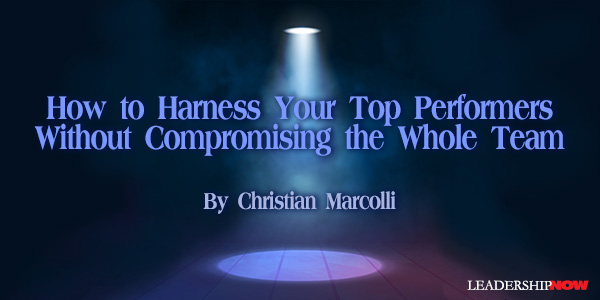
ONE OF the key questions for executives, business leaders, and entrepreneurs is how to keep raising the bar and ensure a continuous increase in your organization’s success year after year. To me, one of the biggest factors is how you specifically engage and develop your best performers — the ones who make a real difference. One of my clients, Richard, had a standout employee, Stella: at the top of her game, knowledgeable, driven, and skilled at connecting the dots. Hired for a key role in Richard’s organization, she quickly rose to a level of performance above many on her team. Therein lay the challenge. A Speedy Transformation Ruffles Some Feathers First, let’s take a look at Stella’s fast trajectory. She went through all four stages of her own evolution as a leader — what I call an Executive Performance Transformation — unusually fast:
Stella continued to shine, delivering top results confidently and consistently, embracing her own stretch goals, and role-modeling the company’s wider culture. She prioritized appropriately for overall success and was always willing to put in extra effort when needed. Richard saw the enormous value she added to the organization and increasingly involved her in the company’s strategic decision-making, asking for her input more often than he asked others. It was clear the whole business benefited from Stella’s ideas and achievements — even her team understood that. But she wasn’t always meshing with the team — and other sentiments began to surface as well among her colleagues, including resentment. Some of her fellow team members began to speak up, asking questions like: “Do Stella’s ideas and opinions count more than ours?” “Is Stella getting special treatment?” “Are we being outstripped by Stella?” Leveling the Team’s Imbalance As a leader, Richard had a dilemma. On the one hand, he needed to continue to reward and encourage Stella in order to go on harnessing her outstanding contribution. On the other hand, he needed to find a way to defuse her coworkers’ frustration and resentment and change the dynamic to prevent the team from becoming dysfunctional. In our coaching sessions, we discussed the best approach. It was clear he’d need to take care of both issues at the same time. We also went through some of the possible scenarios and unfavorable messages that he’d be sending out as a leader if he didn’t:
Parallel Strategies Embarking on his parallel approach, Richard started by regularly and explicitly expressing his appreciation and gratitude towards Stella for her exceptional attitude and performance. In this way, he avoided risking that she’d feel her efforts were taken for granted. In addition, he explained that he had the very highest expectations of her when it came to her team behavior. During their biweekly one-on-ones, he made sure to remind her that, as an exceptional performer, she had a major impact on those around her and would always be under intense scrutiny by other team members. Richard urged Stella to always act as a role model in every respect. In team meetings, for example, he advised her to contribute last, after her colleagues, to prevent them from feeling sidelined or railroaded. And before making her contribution, he suggested she first comment appreciatively on other members’ input: “You made a great point there...”, or “That reminded me of…” At the same time, Richard addressed the whole team. He organized an offsite session where he pointed out each member’s value to the overall success of the business. He particularly emphasized the team player qualities of each individual. Then he set up one-on-one meetings between every team member, including himself. After well-structured preparation, each team member shared what they valued, especially about the other, what the other could change to achieve even better teamwork, and how they could support each other even more. On the back of this process, each team member made one personal commitment that would add to the team’s strength. For his own one-on-one with each team member, Richard asked for direct and candid feedback, asking, “Does everybody feel equally appreciated?” “Does everybody get sufficient opportunity to contribute their ideas?” “Does everybody feel fully included?” Building a Culture of High Performance and Appreciation Richard’s approach enabled him to continue harnessing Stella’s exceptional performance and potential. At the same time, he established a high-performance culture built on mutual respect, appreciation and support. The challenge he faced is certainly not uncommon in organizations. As a leader, you may likely experience a similar situation. My recommendation is that you keep aiming high. Harness the exceptional potential of individual star performers while simultaneously cultivating a healthy team culture. It’s a win for everyone.  
Posted by Michael McKinney at 09:17 AM
11.08.24

Selecting My Team: The Art of Choosing the Right People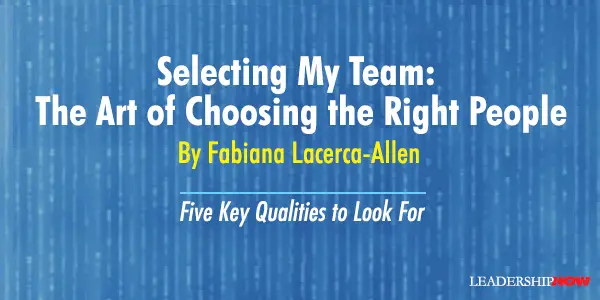
WHEN building a successful team, the selection process is critical. I once shared in an article in The Guardian that my approach to selecting team members can be distilled down to a single criterion: whether I’d be okay being kidnapped with them. This gauge encapsulates the essence of everything I’d want in a team member. Below are five key qualities to look for that will contribute to a cohesive and effective team: 1. Team oriented A successful team isn’t a collection of individuals working in isolation; it’s a cohesive unit where each member understands their role and supports one another. Team-oriented individuals collaborate seamlessly, communicate openly, and share a common goal. They’re willing to put the team’s interests above their own, which fosters a sense of unity and purpose. In my experience, team-oriented individuals are often those who have a genuine interest in the success of others. They celebrate victories, both big and small, and offer support during challenging times. Building a team with this mindset encourages a positive work environment where creativity flourishes. When members feel they can rely on each other, they’re more likely to contribute their best efforts, which results in heightened productivity and innovation. 2. Calm under pressure Another critical attribute in team members is the ability to remain calm during a crisis. In any organizational setting, challenges and unforeseen situations are inevitable. Team members who can maintain their composure under pressure are invaluable assets. They not only manage their own stress effectively but also help to stabilize the team as a whole. Individuals who can think clearly and strategically in high-pressure situations are often the ones who can turn challenges into opportunities. They analyze the situation, devise a plan, and communicate effectively, ensuring that everyone is aligned and informed. This ability to calmly navigate crises strengthens the team’s resilience. When team members know they can rely on each other during tough times, it fosters a sense of security and trust that is paramount for long-term success. 3. Strategic thinker In today’s fast-paced and ever-changing environment, individuals who can see the bigger picture and anticipate future challenges and opportunities are indispensable. These individuals possess a forward-thinking mindset that encourages innovation and adaptability. Strategic thinkers analyze data, consider various perspectives, and make informed decisions that align with the organization’s goals. They’re not content with the status quo. Instead, they challenge conventional wisdom and seek ways to improve processes and outcomes. A team that includes strategic thinkers is better equipped to navigate complexities and drive sustainable growth. 4. Loyal Loyalty is a cornerstone of any effective team. I seek team members who demonstrate commitment to both the organization and to their colleagues. Loyalty leads to a supportive environment in which individuals feel safe to express their ideas, take risks, and make mistakes. When team members trust one another, they’re more likely to collaborate effectively and work towards common objectives. Moreover, loyal individuals are often the ones who go above and beyond for their teammates. They’re willing to lend a helping hand, share knowledge, and advocate for others. This sense of solidarity enhances team morale. In a world where change is constant, loyalty acts as a stabilizing force that keeps the team grounded and focused. 5. Courageous Finally, I look for courage in a prospective team member. Courageous individuals aren’t afraid to voice their opinions, challenge the status quo, and take calculated risks. They possess the confidence to confront difficult situations head-on and make tough decisions when necessary. Courageous team members inspire others to step outside their comfort zones and embrace change. In a team setting, courageous members prompt open communication and transparency, empowering everyone to express their thoughts and ideas. They lead by example, encouraging a culture of continuous improvement and growth. When team members are willing to take risks and stand up for their beliefs, it cultivates an atmosphere of innovation and creativity. Selecting the right team members is a multifaceted process that demands careful consideration. Focusing on these five key attributes will create a cohesive and resilient team capable of navigating challenges and achieving collective success. My metaphor for assessing team members related to who I’d want to be kidnapped with aside, a well-chosen team will drive organizational success as well as ensure fulfillment for every member involved.  
Posted by Michael McKinney at 11:09 AM
07.05.24

What is the Gouge?
NAVY SEALs talk about the Gouge. But what is it? It’s not a thing but mental readiness—a preparedness that is based on some foundational beliefs. It is a place you bring yourself and others to mentally. It is defined by Admiral and former Navy SEAL Bob Harward in The Gouge!, as “the contract we all have with humanity, sharing the best of everyone for the collective well-being of all. It was always intended to be information you could believe in, people you could trust, organizations you could rely on because it came from people who wanted the best for you, and therefore good for all.” What caught my attention was the subtitle of the book: How to Be Smarter Than the Situation You Are In. The Gouge is more than just good advice shared with others. It is a perspective that brings out the best in others. It is a decision-making tool that presents obstacles as choices. Harward explains: Each choice is filtered through the collective experience and wisdom of those participating and reinforced accountability to each other and to yourself, faith in one another, and inherent trust, which facilitates deliberate action. Once the choice is made, you’re committed and focused on making the right choice. To have Gouge, you must be a tuned-in person with the following fundamental beliefs: Mission First. People Always. We can make others better every day. As a leader, “you are a participant in human development. If we can take care of people and each other, the rest of it will come.” Looking out for others builds trust and confidence. The mission succeeds when people succeed. Purpose Defines You. Embrace It. It all comes down to purpose. Leaders reinforce and leverage purpose. “If Gouge is about the information that links -all of us together, our purpose is the bedrock on which Gouge is built. It determines who you are, reinforces your belief, and ultimately determines your success.” We Are All Accountable for Ourselves and Others Looking out for each other requires accountability at all levels. It must come from above and below. “Lack of accountability is a slippery slope that is hard to stop once it festers itself in any organization or team. Accountability and confrontation are aligned. If you’re going to avoid confrontation, you’ll never hold anyone accountable.” Constructive, forward-looking confrontation is a part of accountability. Anonymity kills accountability. You don’t have to own what you say. While social media can be used for good, it has created cultural accountability problems. “Tweeting. Posting on Facebook. All of those sites put a barrier between human connection, allowing people to refuse accountability for what they’re saying or doing.” The best leaders know how to effectively implement it to get the best results for their team so they can fulfill their purpose. During any confrontation, remember we are one community with a purpose. Faith In People Is My Religion Faith in each other builds community. “It is essential because if you don’t have faith in one another, there is no trust, no passing of information or guidance, and the whole system breaks down.” This faith is placed in the bond between two people, casting your dot with your fellow man in hopes of achieving a common goal. Never Quit, but Saying No Is Always an Option For Navy SEALS, quitting is a mortal sin. No matter the demands, never quit. But there are times when the best Gouge is to quit. Sometimes, saying no is “just an opportunity to say yes to something else.” Sometimes, saying no forces you to live up to your maximum potential. Great Leaders Share Gouge Empower and support others through Gouge. Show them through your actions. “By showing your people that you see them not as a way to accomplish a mission but as teammates working with you to accomplish a mission. Make sure everyone is armed with the best information so they can not only do the job but so they can sync it with their purpose.” What About Bad Gouge? When people are working at cross purposes, there is bad Gouge. When you find yourself in a new situation, you need to recalibrate. “You have to think to yourself: Is someone trying to sell me something? Does it benefit this person/company in any way if they influence my thinking one way or another? Does this person have credibility?” Many times, bad Gouge is simply being surrounded by the wrong people. Good Gouge only comes from relationships where everyone is on the same page and working toward the same goal. Identify Your Own Gouge To identify your Gouge, “think about the essential personal and professional information you want your employees, team, and children to know. Focus on empowering those around you instead of yourself, and watch how successful you become. Always look to better yourself and better those around you, and always be courageous enough to communicate it. The Gouge is very simple. It is information used to create a better outcome for all.” 
Posted by Michael McKinney at 06:07 PM
02.19.24

Steve Jobs: The Dynamics of An Excellent Team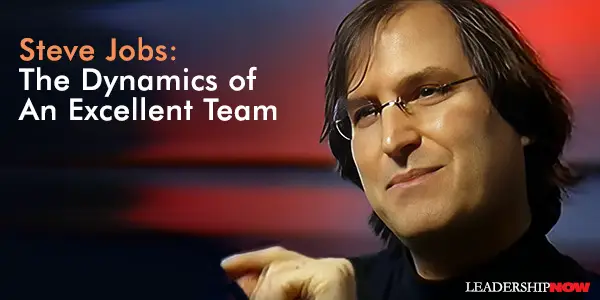
IN this interview, Jobs explains the dynamics of a team that pushes to excel—to be above average—excellent. There are some team leaders who would argue that a great team is all smiles and agreement. But that only produces stasis or marginal improvement at best. It’s groupthink. A productive team that pulls the best thinking from all members encourages the friction we need to grow into something transformative. What follows is a lightly edited portion of Steve Jobs: The Lost Interview, released in 2012, explaining what is required from a team to achieve excellence. One of the things that really hurt Apple was after I left, John Sculley got a very serious disease, and that disease I’ve seen other people get it, too. It’s the disease of thinking that a really great idea is 90% of the work and that if you just tell all these other people, “Here is this great idea,” then, of course, they can go off and make it happen.
Posted by Michael McKinney at 09:17 AM
12.18.23

4 Ways to Improve Your Team’s Decision-Making Habits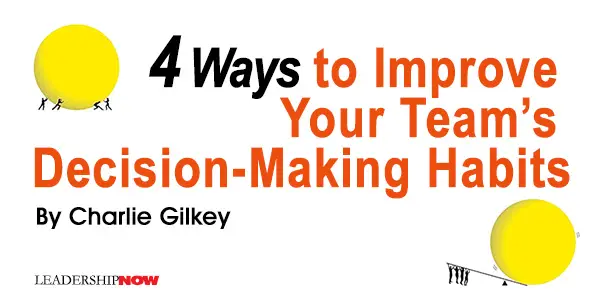
MOST WORK TEAMS have the same silent member who’s constantly dropping the ball. A slacker named “somebody.” Somebody was supposed to call the vendor. Somebody was supposed to check on the competition. Somebody was supposed to consult the boss. But somebody never does anything. Sound familiar? Of course, it does. That’s because you almost certainly have a “somebody” on your team. In my experience, though, as a guy who coaches and trains work teams professionally, I know this to be true: There is no somebody. That is, your team doesn’t have a “somebody” problem; it has a decision-making problem. And that makes knowing who’s responsible for doing exactly what, and by when, a real problem—one that reverberates through everything else your team does. A decision on such-and-such was made at the last team meeting, right? And who in the team would act on it, right? And in what time frame, right? Or does it just seem like you had decided? My money is on the latter. There is hope and help, however. Here are four surprisingly simple ways to improve your team’s decision-making habits. 1. Recognize that decision-making isn’t just social—it’s emotional. In teams, decision-making is about far more than gathering round to go over options and get to a pick. It’s also an emotional undertaking that involves the values, fears, and aspirations of the people making the decisions. Recognizing that emotional component can help your team appreciate why some decisions may be harder to make and act on than others. It also cultivates a decision-making environment where everyone in the team feels heard and respected and where people’s individual insights or skill sets are considered to make the best possible decisions. 2. Remove decision-making bottlenecks with the “three levels” framework. There are three levels of decision-making in a team, and understanding and applying those levels can help teams discern who has the power to make what types of decisions. Level 1 represents decisions that team members can make independently. Level 2 represents decisions that team members can make independently but need to let the rest of the team know when they do. Level 3 represents decisions that team members can make only after getting a thumbs-up from the rest of the team or management (or both). Ideally, about 80 percent of your team’s decisions should fall within Level 1. That not only empowers team members to act within their role or scope, but also escapes endless (and endlessly counterproductive) decision loops. It’s also a great way to prepare people for leadership. When team members get hung up on which level a particular decision falls into, they should schedule a quick conversation with the team to cover any questions or concerns. 3. Use intent-based decision-making. Intent-based decision-making is a powerful tool, as it allows team members to make individual decisions based on a clear-cut, agreed-upon understanding of the team’s overall objectives. So rather than letting people in your team waste precious time while waiting for permission on every little thing, they can proceed independently in the moment, as long as they’re acting within the boundaries of the team’s goals and mission. 4. Keep a team decision log. (Nobody’s memory is that good.) We’re all human beings, so it’s understandable when teams forget who’s responsible for what task or project, especially when, earlier, myriad decisions were made in a rush-rush call or meeting. Maintaining a decision log solves that problem by tracking who in your team is responsible for doing what and by when. It also makes for an easy-breezy accountability tool. In closing, remember that your team doesn’t have a “somebody” problem—it has a decision-making problem. And you can solve it in four surprisingly simple ways.  
Posted by Michael McKinney at 04:39 PM
06.12.23

Winning Teams Know to Trust Their Team Members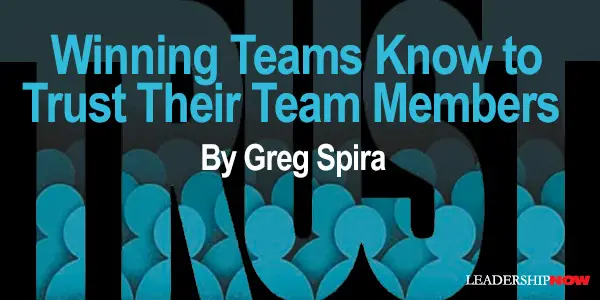
IN BUSINESS, as in sports, the aspect that distinguishes the best teams from the mediocre teams comes down to collaboration. Yet many times, companies struggle with sharing and aligning functional plans. Too often, managers put their heads down and focus only on their own departments. But setting goals in functional silos and then hoping that everything works itself out across the organization is an unlikely path to success. Instead, if they trust and coordinate with their cross-functional counterparts, they will be better able to synchronize plans. Doing so ensures that what they’re doing as an entire team will enable the achievement of the company’s overall business objectives — which often represents the difference between success and failure. Let’s apply the team sport analogy further. In ice hockey, for example, players have a decision to make when the puck is passed to them. One choice is to take the puck down the ice on their own to attempt to score a goal. They may have significant incentive to do so — they may be close to breaking a personal record or they may believe that their chance to increase their scoring statistics will make them more marketable as a player. They also may not trust their teammates’ ability to score a goal. An alternative choice is to pass the puck to another player who is in a better position and can make a coordinated play. Faced with this decision over numerous games, team members detect the repercussions when individual members regularly attempt to go it alone. The loners come to be regarded dubiously by their teammates and lose a measure of respect. Consequently, others may not instinctively pass the puck to them. Such behaviors will have an impact on the team’s win-loss record — and not in the preferred category. Consider this hockey analogy in a business context. Collaborating with other business functions is often an adjustment for sales and marketing leaders. Still, they can’t go it alone and expect to win the game. They often must consider broader implications when establishing commercial plans. Once they focus on the betterment of the entire business, however, a shift in attitude occurs. Sales and marketing leaders become more mature in their thinking about the demand plan. They consider the demand plan a request for product that they’re accountable for selling. The manufacturing organization is rarely an open bar, so to speak. Supply planners shouldn’t be forced to guess which of the demand mix, volume, or timing in the plan is going to come true, and which are hedges against possible poor performance from the manufacturing organization. Similarly, with suitable coordination, the supply chain organization’s thinking shifts. They know the pitfalls of second-guessing the demand plan. The role of supply chain organization is to create a supply plan in response to the demand plan. This supply plan considers inventory, cost, and service level parameters that are deemed optimal. Coordinating and synchronizing plans across functions enables coordinated responses to changes regarding both problems and opportunities. Doing so creates agility. When upper management leaders play their positions and trust their teammates to do what they say they’re going to do in their plans, something else happens. Responding to change becomes much simpler and in some cases, effortless. As in team sports, the regular synchronization of cross-functional demand plans in business is key to empowering teams to execute — and win.  
Posted by Michael McKinney at 07:30 AM
06.07.23

Good Team Leaders Checklist
HIGH-PERFORMING teams have six characteristics: leadership, organization, communication, knowledge, experience, and discipline, says former Air Force F-115 pilot James Murphy. But among these, leadership comes first. Bad leadership will doom a team. Leaders hold themselves accountable for the team’s performance. And great teams support each other. In Courage to Execute he writes, “Leaders of high-performing teams encourage their people to ask these two questions: First, is there someone on my team that needs my help in achieving our objectives? Second, do I need help from someone on my team to achieve our objectives?” Murphy offers a Good Team Leaders Checklist to ensure you are creating a positive team environment on a daily basis: ○ Take responsibility: A team owns success; a leader owns failure.

Posted by Michael McKinney at 11:03 AM
06.02.23

3 Telltale Signs It’s Time to Rethink Your Executive Team
WHEN A CEO first assumes their position or joins a new company, they’re often quick to make changes to the executive team, creating a group of trusted advisors who will drive their strategic agenda. But once the CEO has been in place for a few years, this dynamic changes. Replacing these hand-picked team members becomes a highly unpleasant process, one that CEOs avoid at all costs—despite clear signs it’s necessary. Our research on CEOs and their senior leadership teams reveals that regularly reevaluating and adjusting the leadership team is crucial for optimizing a company’s performance over time. To decide if “now is the time” for a change, CEOs must watch for three telltale signs. Sign 1: A change in the business environment The most obvious signal that it’s time for a change is a large-scale shift in the business environment. In recent years, many industries have been disrupted by technological change. These changes have necessitated new capabilities and forced even the most established players to make radical departures from their business models. Take, for instance, the automotive industry. The electrification of vehicles and increasing reliance on computer software, rather than mechanical parts, have upended the knowledge and capabilities needed in the industry. Simultaneously, the traditional automotive business model—built around individual car ownership—may soon be replaced by fleets of autonomous vehicles owned by service providers rather than individual people. Companies are also facing heightened expectations about their role in society. Stakeholders and shareholders alike expect businesses to make a positive impact on the big challenges our planet faces, such as climate change, redistribution of wealth, and more equitable ways of operating and performing. Adding to the already increased complexity of the business landscape, recent events like the COVID-19 pandemic and the war in Ukraine have forced companies to fundamentally rethink where and how they operate and how they can build resilience to change. When an organization faces fundamental shifts like these, simply adding a chief digital officer or chief sustainability officer to the leadership team is no longer sufficient. Instead, leaders must reassess their leadership teams, from redefining existing roles to creating new roles to altering how different roles interact. This was the challenge Mary Barra, CEO of General Motors, faced when she took over as CEO. Barra found an organization that not only had fallen behind the competition but was also largely unresponsive to the market. To initiate the changes that would make GM relevant once again, Barra overhauled the leadership team’s composition, culture, norms, and way of operating, converting the team from a group of disconnected individuals into an integrated group empowered to deliver on GM’s goals. Sign 2: A new CEO mandate After accomplishing their initial objectives, successful CEOs often face a new challenge: defining a mandate around a new set of goals. Doing so requires CEOs to not only reinvent themselves and their organizations but also to rethink their executive teams. Bracken Darrell, CEO of Logitech, a Swiss-American computer peripherals and software manufacturer, faced this very challenge. Initially, Darrell granted the Logitech leadership team a high degree of independence, treating the company’s various businesses as individual startups. However, following several acquisitions in 2018 and 2019 and rapid growth during the pandemic, he defined a new set of goals that required a higher degree of coordination and centralization in his team. As Darrell explained: I am planning to centralize a few things. This will change the dynamic. When decisions need to be made centrally it will mean that you cannot weigh how it affects every individual business as heavily. You have to put the company ahead of each business. So you have to rethink the team. CEOs must assess whether leadership team members can transition to meet new mandates or if they need to be replaced. Sign 3: Stagnation or deterioration of individuals or the team While changes in the business environment or a new mandate are hard to ignore, the third sign is more easily overlooked. In many organizations, individual team members—or the entire executive team—may stagnate in their development and gradually deteriorate in their performance. Some senior leaders stop developing and, therefore, over time will be more and more out of touch with the organization’s needs. As one anonymous Fortune 500 CEO shared: My CFO started well. Over the first two years, he accomplished a lot to put the company on a stronger financial footing. But he was really not interested in learning about our business, and after the initial results, he simply was not able to take the organization to the next level. Similarly, leadership team performance may deteriorate when members become too comfortable with and stop challenging one another or when healthy competition devolves into politicking and backstabbing. Take, for instance, the leadership team of a European multinational corporation we’ll call Frontal. The Frontal team had been working together for over 10 years, and the roles of every member in the organization had become very set. As the CEO said in a conversation in confidence: “With every topic, I can almost foretell what each member is going to say. Everybody is trying to be nice, and no one wants to step on the others’ toes.” When individual team members or the entire executive team begins to stagnate, it may be necessary to refresh the team by replacing at least some of its members to infuse new ideas and keep sufficient creative tension. Taking Action Upon recognizing these signs, CEOs must spur into action. They should approach the situation as if they were new to the organization. Does the executive team reflect the CEO’s goals, mandate, and vision for the future? Should the CEO clean house? Or should new sets of team roles and responsibilities be defined? Although this process may be uncomfortable, regularly reassessing and refreshing the leadership team is one of the most effective routes to long-term success.  
Posted by Michael McKinney at 07:10 AM
01.04.21

Teams That Work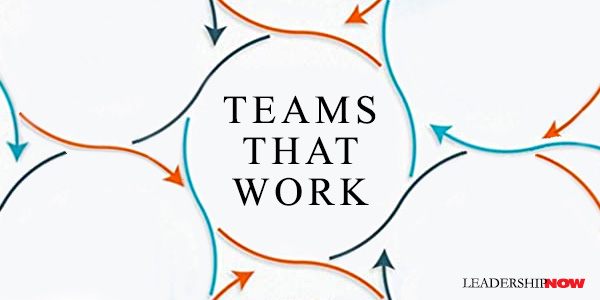
NOT every problem can be solved with a team. But when a team is called for, it is important to get it right. Teams That Work by Scott Tannenbaum and Eduardo Salas is a comprehensive look at teams and the drivers of their effectiveness—long term. Fairweather teams that crumble when things get tough or can’t recover from setbacks quickly are not effective teams. The authors say three components characterize effective teams: Sustained Performance (are able to generate positive results over time), Team Resilience (can work through challenges and can quickly bounce back from adversity), and Vitality (can maintain the energy, vibrancy, and resources needed for future success). Before addressing the seven drivers of team effectiveness, they point out that all teams are not the same. And this is important to consider because helping your team succeed depends on the nature of your team. They highlight five team distinctions and place each on a continuum from low to high: Reliance. Membership Stability, Task Consistency, Proximity, and Similarity. For example, the Reliance Continuum:
For teams that fall toward the far-left end of the continuum, sometimes all that is needed from a team perspective is for members to be civil with one another and not get in each other’s way. Perhaps all the team leader needs to do is provide individual feedback when deviant behavior emerges and occasionally host a social event, so team members see each other as real people. But for teams where team members must rely on one another a bit more, they need more than just being civil. They need to be able to pass the baton, know the planned plays, or adjust to one another on the fly. Teamwork and seven drivers become increasingly critical as we move from left to right on the continuum. Where is your team on these five continuums? The authors then get into the seven drivers of team effectiveness that consistently make a difference.
Capability Fundamental question: Do we have the right people with the right mix of knowledge, skills, and other attributes? If your team does have the necessary competencies, little will be accomplished. Consider both task-related capabilities and team-related capabilities. Team related capabilities include giving/receiving feedback, communicating, conflict resolution, leadership and interpersonal skills, and understanding how teams work. Communication Fundamental question: Do team members communicate effectively with each other and with people outside the team? Quality is more important than quantity, and a breakdown in communication makes the team vulnerable, especially in crisis situations. “Quality communication means sharing useful information clearly, accurately, and on time to the right people.” What drives team effectiveness is communicating unique information and knowledge that others may not possess or fully understand. That builds shared awareness among team members. Unique information can be related to an area of expertise, the status of a situation, or an action that is needed. It doesn’t need to be complex or highfalutin. Cognition Fundamental question: Do team members possess a shared understanding about key factors such as priorities, roles, and vision? When a team has conflicting or unreconciled points of view on priorities, roles, or how to handle certain situations, it can adversely affect to coordinate and perform effectively. In contrast, when a team possesses what psychologists call “shared mental models,” it often results in better performance. Another way to think about cognition is whether your team members are all “on the same page.” Conditions Fundamental question: Is the context in which the team operates favorable for performing effectively (e.g., ample resources, supportive culture)? Positive work environments create positive outcomes. There are some things that can’t be changed in an organization to accommodate the team. In that case, the team should learn to work around it. “It is helpful to think about conditions as operating on two levels: the broader organizational or business unit level and the local, team-specific level.” What is the situational strength of the environment? “Some situations are so strong they essentially mandate behavior, others only offer hints or ‘nudges’ about what to do, and weak situations may offer no clues about expected behaviors.” Organizational policies and practices, including performance management and compensation practices, create expectations about teamwork. The climate in which the team is embedded also matters. Coordination Fundamental question: Are team members exhibiting the necessary teamwork behaviors for team success? Coordination is about behaviors, not attitudes, and is at the heart of teamwork. Behaviors matter. The forms of coordination that matter the most are: maintaining situation awareness, providing back-up and support, learning and adapting, and managing team emotions and conflict. Coordination is more difficult when team membership is frequently changing, task requirements are dynamic, people work in different locations, or team members have diverse capabilities and perspectives. Cooperation Fundamental question: Do team members possess the right beliefs and attitudes about their team? Cooperation emerges from the other six drivers. Cooperation develops over time and is dynamic. “Cooperation isn’t like a skill or personality trait that you take with you from team to team. And it isn’t about your general attitude towards teamwork, but rather how you currently think and feel about this team.” Four forms of cooperation are essential: trust, psychological safety, collective efficacy, and cohesion. Coaching Fundamental question: Does the leader and/or team members demonstrate the necessary leadership behaviors? Coaching is not just for the team leader but is more of an all-in driver. Others on the team can step in and help with these functions. There are seven essential leadership functions: Task-focused:
Team-focused:
Team and task-focused:
People in power tend to self-anchor. That is, they tend to think and feel the same way they do. When in power, we have a harder time reading other’s emotions. We filter other’s opinions and thinking through our own opinions and thoughts and create false assumptions. “And, due to self-anchoring bias, our natural inclination can be to assume we are ‘reading the audience,’ when in reality, we are merely reading ourselves.” What I have presented here is just a brief overview of the material they present. You will find in Teams That Work practical so-what-now tips and how you can use this knowledge whether you are a team leader, team member, consultant, or a senior organizational leader of teams. Unless you work in a vacuum, this book will provide many insights for you. 
Posted by Michael McKinney at 03:09 PM
12.18.20

What Do You Do When Life Ambushes You?
WE are conditioned to believe that to be happy, for life to be good, everything should be going our way. Life is supposed to be comfortable when done right. Most self-help books are based on this line of reasoning. But when you think about it, a constant state of comfort is numbing to the human spirit. It takes us nowhere. What really makes us feel alive are those times when we are challenged, pushed, distressed. In those moments, opportunities arise, our mind expands, and we grow—we learn. What do you do when life ambushes you? When you are disabused of the status quo. Times like this can either shut you down or open you up. Ambushes create a question. Former Navy Seal Jason Redman says when a life ambush— “a catastrophic series of events that knock the wind out of you, pin you to the pain, and forever alter your reality” —hits you, you must overcome. You must get off the X. The X is the event that hit you. And we can get stuck there—sometimes for years. He says people respond to life ambushes in three ways. They are destroyed by it and can’t stop rehashing it. Or, like most people, they get through to the other side, but it is always a struggle for them. Or the third group turns the ambush into a launching point. In Overcome: Crush Adversity with the Leadership Techniques of America's Toughest Warriors, he shares the story of he was caught in an ambush that left him severely wounded, almost losing an arm and half of his face shot off. He was caught on the X—the “kill zone, the point of attack” –bleeding out, sure he was going to die. He had to stay awake to stay alive. He had to overcome. What would you do? “How you handle a life ambush, how you handle any crisis, is dictated by how well you lead yourself, and how well you lead others.” After an ambush, you have to take back control of your life and move from defense to offense or what he calls the Overcome Mind-Set. “Self-discipline is the best way to take control of your life again after an ambush.” Your first move is to get off the X. Identify the issue and find a new direction. You have to REACT: Recognize your reality, Evaluate your position, Assess possible exit routes, Choose a direction and communicate it, and Take action. Moving is the key to getting off and staying off the X. Once you’ve been through a life ambush, it’s so easy to look back at where you were in the past and think, “Getting back there is my goal.” It isn’t. It can’t be. You have to figure out what your new 100 percent is and build on it. Redman believes there are five areas of your life that when maximized will help you to face any ambush when it comes. The key self-leadership areas are physical, mental, emotional, spiritual, and social.
Physical Leadership: “If you are ignoring your physical health, you’re in denial about the risks you are unnecessarily taking. Physical fitness is not just about being ripped or strong; it is about having the energy needed to lead. Physical fitness is the base. Everything is supported by this base.” Mental Leadership: “You build mental leadership through broadening your perspective, increasing your knowledge, and getting outside of your comfort zone. An interesting recommendation from the Brain Center was to find a sport that requires balance, like paddle boarding, surfing, or even cycling. These exercises are great for mental training because you are using the muscles on both sides of your body, causing your brain to use both hemispheres.” Emotional Leadership: “What we do with our emotions is a choice. We choose to allow ourselves to get angry and explode. We choose to verbally express our negative thoughts and frustration. Controlling our emotions begins by understanding the scope of our emotions and what patterns we typically fall into when we react.” Social Leadership: “Often in those hardest moments you only have your close friends and family, and if you did not take the time to nourish those relationships, you will be trying to overcome the near impossible, climbing out of a deep hole without a rope or assistance.” Spiritual Leadership: “Spiritual leadership means recognizing that you are a unique part of a much larger world and picture, and investing time and resources to make your community and world better. If you struggle with spiritual leadership, try a simple practice: gratitude. Gratitude forces you to look outside of yourself, to focus on something beyond your problems.” If you are not maintaining each of these five areas, you will undermine your ability to lead others. A Crisis Is a Launchpad Overcome offers an approach to get you off of your X with a never-quit attitude. It’s about breaking down the barriers in your mind and keep moving forward despite your fears. It’s about perspective and gratitude. A life ambush is miserable when we go through it. Maybe we don’t fully recover from it, but it creates a whole new path. So many people get stuck on what they lost or what they no longer have. They want the past so much that they’re not willing to turn around and look forward at what is in front of them. They fail to even consider, “Okay, what are my new opportunities, and could something better come of it.” Choose to overcome—very good advice from someone who walks the talk. 
Posted by Michael McKinney at 04:32 PM
12.04.20

The Small Voice in the Room
ONE OF THE MOST challenging leadership problems is to get people to speak up, especially as it concerns realizing the value of the “small voice in the room.” I had just come off my first CEO assignment with Pretty Good Privacy, Inc. a fairly notorious email encryption company both provoking concerns from the NSA but also putting privacy on the map as “the marketing gorilla of the Internet.” With this cybersecurity background, I was recruited to run another security company that had developed a clever computer card implementation of the emerging virtual private networking standard. With this impressive implementation, it had managed to enter into an agreement with a much larger, high-profile player in the industry. This partnership had the potential to put the startup on the map and create a high valuation for subsequent investment rounds. When I joined the company, it was late delivering the hardware/software card to the partner. While I was able to secure a $6M investment from the partner, they were at the same time giving me increasing levels of grief for the delays. I had already completed some training in company principles and was pressuring the team to follow through on the “honoring commitments” part of the practices I had put forward. I had also discussed the “speaking up” practice, but one thing at a time. Unfortunately. With this pressure on the team, it eventually delivered the card. The larger partner took three months to begin testing the card, during which further development of the card by the startup was suspended, finding it amusing that the partner who complained about our tardiness was even more tardy, soon to become a not so amusing lesson in avoiding smugness. Once testing began, the card crashed. Repeatedly. And despite a desperate effort to remedy the problem, it turned out to be irretrievably flawed. During the testing process with the larger partner, one of the startup engineers was heard to say “They should be mad. That card is junk!” Had that fact been widely understood, the startup company could have used those three months to fix the card and save the partnership. Unfortunately, with time running out, the partnership collapsed. Somebody on the team always knows about a problem before it is detected by some kind of oversight system. That is why real teams provide a sufficiently safe environment to encourage speaking up no matter what consequences otherwise might attend the act. Instead, another startup, employing a similar technology strategy, but running months behind, gained traction. It ultimately went public and ultimately was sold for $3 billion. The first startup eventually sold for $50 million, or a difference in outcome of $2.95 billion. That’s an expensive communication mishap. In the Greek Pantheon, Hermes was the god of complementarity and communication. He encouraged not only open pathways but also actions to fill them. We think of Greek gods as curious figures from the past. They aren’t. They are an embodiment of human nature, and we might be surprised to find they are alive and well and present in our conference rooms. In this case, Hermes wept. These and many other principles and practices are covered in my new book, Real Teams Win: What Smart Leaders Need to Know Now About Achieving Peak Performance.  
Posted by Michael McKinney at 01:03 AM
10.23.20

Want an Ideal Team Player? Find an Introvert
WHILE the introverts at the office may not be top-of-mind when it comes to assembling a project team, you could be overlooking valuable contributors. Too often, the ideas of introverts are drowned out, yet when sought out, can have true merit. Management guru and prolific author, Patrick Lencioni, wrote about the three characteristics of an ideal team player – hungry, smart, and humble. That third trait, which includes sharing credit and defining success collectively rather than individually, is one most often associated with introverts. A measure of an effective team is that it utilizes all team members’ strengths. Introverts are keen observers, listeners, and deep thinkers. Without unlocking the introverted voice, teams won’t achieve their true potential. Teams involving both introverts and extroverts get exponentially more accomplished. It’s like having one group that can see close up and one that can see into the distance. Here are five approaches to more inclusive team meetings that insure introverts’ input: 1. Implement a 1-minute rule. Ask that each team member speak for 1 minute on a work-related topic. In structuring team meetings so that everyone has a chance to contribute for the same (short) amount of time, introverts are ensured the same opportunity to be heard as their extroverted counterparts. 2. Pair up. Pat Wadors, chief talent officer at ServiceNow, structures team meetings to be more inclusive by pairing up team members. They can privately check in with each other via chat or a program like Slack to see if either needs more explanation or context. Extroverted team members can advocate for introverts if they want to make a comment and are having trouble interjecting their thoughts. Additionally, the buddy system helps to increase compassion and understanding among team members and build one-on-one relationships. 3. Create team member user manuals. Consider the creative technique of asking team members to write their own user manuals that help others understand how they like to work. It can include their collaboration style, ideal times of the day for group and solo work, their motivations and stressors, and their interests in and outside of work. User manuals are a great tool for introverts – who often prefer written communication – to let the rest of the team know their preferences. 4. Consider teams of two or three. Introverts often prefer one-on-one or small-group meetings to larger ones. Instead of all-person team meetings all of the time, consider breaking up your team into smaller groups. These groups of two or three can focus on specific tasks. Encouraging these smaller groups to take walking meetings may also make it easier for introverted team members to speak up. Walking while talking helps to get introverts out of their head and facilitates the flow of ideas as they think on their feet (literally). 5. Foster transparency. Consider using a design or system map to get both introverts and extroverts involved. According to Service Design Tools, this is a representation showing in a single frame all the different actors involved and their mutual links – such as flows of materials, energy, information, money, documents, and more. You can display it and add or remove Post-it notes to provide supplementary information. Too often, introverts are expected to yield the floor to extroverts who are very comfortable with speaking up. Teams who include everyone’s voice will engage the introverts on the team. The team will find a well of resources in their quiet, calm contributors as well as their expressive, energetic ones.  
Posted by Michael McKinney at 03:10 PM
03.02.20

10 Lessons from Porter Moser’s All In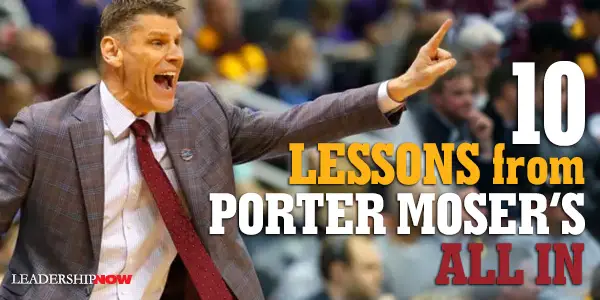
PORTER MOSER is the head men's basketball coach at Loyola University Chicago. Known for what he does on the court, he has guided the Loyola-Chicago Ramblers to three post-season berths, including a historic run to the 2018 NCAA Final Four and back-to-back MCV regular-season championships in 2018 and 2019. But it is his reputation and impact for what he does developing people off the court that is his legacy. In All In: Driven by Passion, Energy, and Purpose, he shares the values and beliefs, the ups and downs of his career, and the lessons he has taken from them. All In is filled with wisdom and lessons from a life leading others to their potential. I’ve extracted some of them for our mutual benefit:

Posted by Michael McKinney at 03:36 PM
12.25.19

Team Leader as Team Coach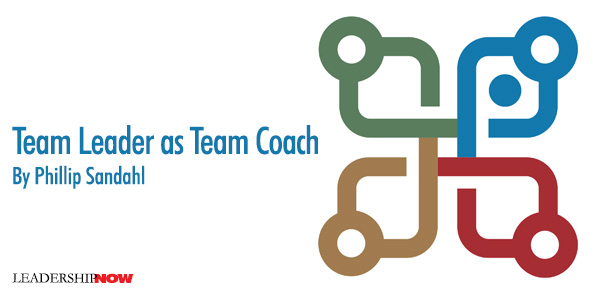
TEAMS HAVE PERSONALITIES. You know this from your own experience. Teams go through mood changes. No doubt you’ve felt it after a great team success or alternatively, the gloom and doom when things do not go as planned. It’s a team experience. It’s in the air. It’s mostly invisible, but it affects team performance. There’s an opportunity for leadership in that experience that is generally overlooked. Taking advantage of it as part of team development is an example of the skill set of team leader as team coach. Team leader as coach is not new. It’s a generally accepted leadership competency, working with individual team members, one-on-one. To that now familiar leadership style it’s time to add team leader as team coach: the ability to work with the team as a whole. The goals are similar: support, development, empowerment and ultimately improved team results. The difference is the environment and what that means in terms of skills needed to be effective. The Essential Mind Shift Where individual coaching is almost always a private, confidential dialogue between two people, team coaching happens publicly and in the moment with the whole team present. The conversation has multiple voices and the conversation between team members is just as important, often more important than the conversation between team members and team leader. In the midst of the team working on an issue that is timely and important at the content level, how the team interacts, how the team communicates and how that supports or undermines team performance, is showing up too. You are witnessing the team as a system, playing out team dynamics. It’s a challenge to shift your attention to this wider lens because of course, you’re an active part of the system too. But what it will give you is awareness of the underlying patterns that impact team behavior, and ultimately team results. Real World. Real Time. With a team coaching mindset, team meetings have two purposes: an action purpose and a learning purpose. The action is obvious: attend to the business. The learning purpose is about becoming more aware of the team dynamics. For example, take notice of how the team holds accountability. On your team, is it loose? Rigorous? Situational? Is it a mixed bag and different for different team members? How would you rate accountability on your team based on watching the team in action? Are you satisfied with that score? These are all good questions for your own consideration. They are also good questions to start an important team conversation. Facilitating that conversation is at the heart of team leader as team coach. Just as there are times when you need to be the commander as a leadership style, there are times to be a team coach, engaging the team and building a whole team culture. Intervening can happen during any team discussion when you notice a pattern, a mood change or a disruption in the flow. Obviously, it’s important that you focus on the issue at hand. Decisions need to be made; issues resolved. At the same time there is an opportunity to step back and watch the movie of how the team interacts. Is there permission, even encouragement for bold, out of the box ideas? Or is the team tentative? Based on what you’re seeing, how would you rate trust on this team? Skills for an Effective Team Coach The number one skill is curiosity. Set aside analysis and evaluation for a moment and just be immensely curious. In our training of team coaches we suggest that they imagine they are team anthropologists studying team behavior with a perspective of, “isn’t that interesting.” A second skill, related to being curious is to ask simple, open-ended questions. The best open-ended questions start with “what”, and the most powerful of all is, “what else?” By the way, “Say more” also works. Notice how important tone is when asking a question, especially when it comes from the team leader. Imagine the different ways this question could be delivered: “What made you think this was a viable option?” There is a curious version of that question and an accusatory one too, delivered with a bite. Remembering that here you are coaching the team as a whole rather than individuals, deliver the question openly, to the team. Avoid polling individual team members. A third skill is the practice of being a mirror to the team. This is a skill that includes clarifying, summarizing and active listening. It starts with your observation, “Here’s what I’m noticing…” and invites response from the team. “What do you see?” Or “Does anyone else see that?” Look and Listen Below the Surface That’s where the invisible forces of the team dynamics are at play. You are already well-practiced guiding and following the content level of a team conversation above the surface and get plenty of practice. That’s where the action happens. The learning for you and for the team happens by becoming more aware of what’s happening below the surface. The leadership competency of team coach creates a way to uncover the team dynamics that hold the team back from operating at its best.  
Posted by Michael McKinney at 12:33 AM
10.23.19

Becoming Interdependent as A Team
THIRTY-FIVE DAYS, 14 hours, and 3 minutes. That’s how long it took Jason Caldwell and the crew of the American Spirit to row 3,000 miles across the Atlantic Ocean during the 2016 Talisker Whiskey Atlantic Challenge. They not only succeeded but set a world record. Success like this is a result of the teams you build and how you choose to lead them. Jason Caldwell calls it Emotion-First Leadership. In Navigating the Impossible, Caldwell takes us through his journey to becoming an elite-rower to explain how he learned to build teams and lead them to perform in challenging conditions. Quit Like A Winner His journey began by quitting. He quit baseball after an injury and went to the boathouse to qualify to row eights. The important thing is to quit like a winner. “Quitting is nothing more than weighing two variables and finding that one of them has stopped being worth it.” What is your threshold for suffering and sacrifice for the goal you have set before you? Failure isn’t quitting—it’s never finding out what you should be doing. Your path to success often begins the day you realize what your focus should be. The path to doing difficult things is not mindless enthusiasm. It is to learn about yourself. Learning about yourself is the only way to block out negativity, endure past adversity, and meet the goal you’ve set. Building A High-Performance Team High-performance team members are interdependent. That interdependency is achieved by leveraging a single emotion—trust. As a leader, do you have the team member’s best interests at heart? You can’t fake it. The best way to be authentic and built this type of trust on your team is to worry less about the alignment of your strategies and more about the alignment of your own emotions. Do you care about your people? Are you more concerned about who they are becoming, or do you care only about what they are capable of producing for your bottom line? Do you pull hard for them before asking them to pull hard for you? Leveraging the emotions of your team is about asking each person “what they want to be, and then you create for them the opportunity to be what they want.” This is not static. People change, and their motivations change, and you need to “need to make it your mission to become obsesses with those evolutions.” Gathering Points Emotional connections are built over time through hundreds of individual connections—interactions. You can’t pull an all-nighter to make this happen. You can’t cram for it. Instead, you need to take advantage of gathering points. In rowing, “gathering points are the places in the stroke where you are expected to check your alignment to make sure it’s in line with that of the team.” If not, you reset and realign. (Alignment: When rowing, “I wasn’t trying to copy him. I was anticipating.”) Caldwell said the emotional connection didn’t happen in the boat or in the gym, “it happened at the bar or at dinner or late at night in the boathouse.” As a high-performance team leader, you need create as many of these gathering points as possible. You need gathering points that your team can’t get enough of. Gathering points that the team craves are the result of a team that knows why they are doing what they are doing and have set before them a challenging goal that they genuinely want to be a part of. “If your environment is mundane, it means you are not asking enough of the team you lead. If there is no challenge, who cares about checking in with one another.” Caldwell offered this litmus test of a team that I found meaningful: “If losing a member of your team is no big deal, then you don’t have a team at all.” The best teams are always personal. Human emotions are the cornerstones of high performance, and leveraging them requires building connections through consistently looking for and hitting gathering points. Navigating the Impossible is full of insightful lessons about team building pulled from the experiences of rowing to eventually winning the 2016 Talisker Whiskey Atlantic Challenge. The annual race that begins in early December is indeed the world’s toughest row. The death-defying challenge of it all and the emotion of the race is captured well in Caldwell’s retelling of the adventure. It’s not just about hitting that sales number or winning that race. It’s about you and your teammates discovering together what can happen when emotional human beings connect and commit to a goal. Once you see that, you’ll be changed. 
Posted by Michael McKinney at 05:28 PM
07.08.19

Nick Saban on the 5 Choices We Have in Life
THE 2019 Clinic of Champions held in April and hosted by Alabama head coach Nick Saban and the Crimson Tide football coaching staff featured a number of speakers from around the NFL including Cleveland Browns head coach Freddie Kitchens. Kitchens explained in his presentation what it takes for good players to become great. It was meant for coaches, but the principles apply to us all across the board. Saban shares his takeaway from that presentation: Freddie Kitchens made an interesting statement last night when he spoke to the clinic, and I actually shared it with the players today. The kind of excellence that Kitchens and Saban are talking about is not easily won. Excellence comes from a fanatical attention to basics. Little things make up the big things. Like the painting by Seurat, many points of activity conspire to produce a single effect. Details done right—at a high level—create excellence. One of those many points comes down to steadfastly acting instead of reacting to any condition you are faced with. That’s driven by consistently keeping the focus on where the team is headed and not where it has been.

Posted by Michael McKinney at 12:51 PM
06.17.19

Do You Trust Your People?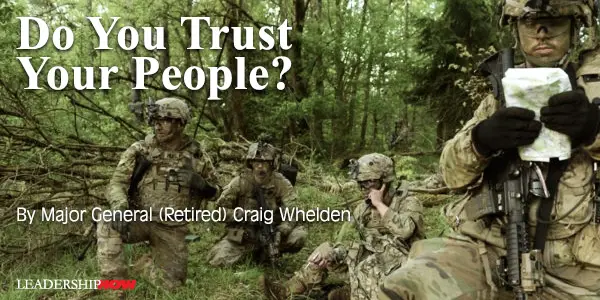
THE GREAT WRITER Ernest Hemingway once said: "The best way to find out if you can trust somebody is to trust them.” I’ve often told people in new organizations I joined that I trust them until that trust is violated. This puts a healthy kind of pressure on them NOT to violate that trust. Stronger performance is often the result. Here are two stories that demonstrate the value of trust: one that reflects what happens when there is no trust, and another that reflects the tremendous performance and learning that comes when there is trust. When No Trust Exists In 1992, I was the G3 (Operations Officer) for one of the Army’s 10 Divisions – forward deployed in Europe. Within a year in the job, I led a military-to-military exchange trip to Hungary, one of the satellite countries of the former Soviet Union. The Cold War had ended, and we were now opening the aperture to Eastern European countries that had been coerced into the Warsaw Pact decades earlier by the strong arm of Russia. After the Berlin Wall fell in 1989, General George Joulwan, the Supreme Allied Commander of all military forces in Europe, established a program called “Partnership for Peace” or PfP. His idea was to reach across the former Iron Curtain so new relationships could be forged between the U.S. and its former foes. The goal was to pull the Warsaw Pact nations out of Russia’s sphere of influence and into ours. My trip was the first such effort the U.S. military did with Hungary, and I was able to witness the difference in approaches to trust between the US military and the Eastern European military—and, by extension, the Russians, since Soviet satellite countries’ military dogma mirrored the mother ship. The Hungarians were truly trying to impress us when they showed us their weaponry, but they were seemingly unaware that the decades-old equipment they had was far inferior to ours if they had to face us in war. The Russians had given frontline nations in Eastern Europe the oldest and least capable equipment, saving the best for themselves. Soviet satellite countries such as Hungary, Czechoslovakia, Poland, and East Germany—rolled into the Soviet arc after World War II—were frankly viewed as cannon-fodder by the Russians. Although I was only a lieutenant colonel at the time, I was treated like a general. Everywhere I turned, only officers (majors and above) were briefing us. They had little trust in their more junior officers and sergeants, like the U.S. places in our junior leaders. Russian influence was everywhere, and the lack of trust and regimentation contrasted sharply with the way the U.S. military operates, where mission orders are issued along with the commander’s intent, thereby giving subordinates the freedom to operate within that framework. In the U.S. military, it’s all about trust and empowerment. I saw little of that in Hungary. A few months later, we reciprocated by bringing senior military leaders from Hungary to our bases in Germany. Most of these delegations consisted of colonels and generals. They were shocked when we turned them over to our sergeants (who actually gave the briefings) and even more shocked when we let them mingle with our troops—out of our earshot—to see what U.S. soldiers were really like. General Joulwan’s approach obviously worked, as a number of former Soviet Union countries are now members of the North Atlantic Treaty Organization (NATO): the Czech Republic, Poland, Bulgaria, Estonia, Latvia, Lithuania, Romania, Slovakia, Slovenia, Albania, Croatia, and Montenegro. And yes, Hungary. When Trust Exists I soon found myself on the list for both colonel and command. My boss called me in one day and told me that I had been selected to command a base. In fact, it was the base we were on: the 98th Area Support Group (ASG), headquartered right there in Wurzburg, Germany. Though I knew little about running a base, it took me just a few months to realize this turn of events was the best thing that ever happened to me. Over 95 percent of my 3,000-person workforce was civilian, half were females, and an equal number were German nationals. I was like a “town mayor” serving more than 45,000 constituents and customers. My leadership style needed to adapt to this very different environment, or I would fail. I was joining THEIR team and needed to learn quickly how to adapt to THEIR environment. Commanding a base required me to put trust, faith, and confidence in a workforce that knew much more about the tasks at hand than I did. I had to lead the team, but at the same time, I had to have confidence that their shared feedback and advice to me was of value. They needed to know that I trusted them. The leadership skills I employed at that time had little to do with the technical aspects of running an Army base, but rather, those that required skills in simply leading people; something I had spent 20 years honing. I found myself praising and encouraging what was working well, and just as importantly, I sought to learn what was not working well and how we could make it better. It wasn’t difficult sorting out the two, as all I had to do was pay attention to those on the receiving end of what we provided. Simply put, I listened to my “customers.” They could be very vocal when something wasn’t right. I understood this well since I too had been a customer of the community for the previous 18 months. This very different experience helped me grow as a leader and prepared me for the rest of my time in uniform and beyond. One of the keys to my success was rooted in the trust I showed my team. It was paid back in exceptional performance. It should be intuitive to most leaders that the higher you climb up the corporate ladder, the greater the reliance you must have on those below you. Support your team and let them do their job, and you’ll be amazed at what they give back. That’s what I tried to do in the 98th ASG, and it worked. It can work for you as well.  
Posted by Michael McKinney at 09:10 AM
06.07.19

How to Tackle Big Challenges in A Networked World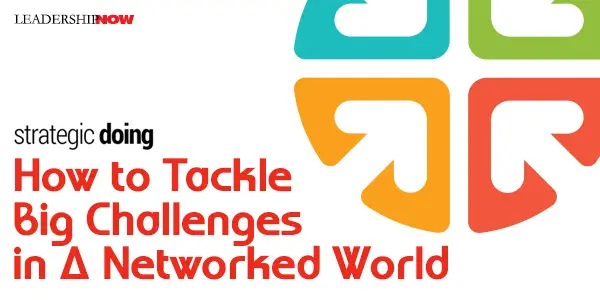
TACKLING THE BIG CHALLENGES when there is no single, simple, rational answer can rarely be done by a single individual or company working alone. Certainly, this is true when facing global, national, or community issues, but it is increasingly true within organizations and small groups. When faced with complex problems, we tend to find a rational answer by analyzing increasing amounts of data and polling for opinions and then announcing the answer to those who must follow. It’s a rigid approach to strategic planning. We need an agile approach that leverages all of the cognitive diversity available to us. In a networked world, the question becomes. “How do you design and guide complex collaborations in open, loosely connected networks when no one can tell anyone else what to do?” Without going into a critique of society, this has become a major concern across a wide range of organizations and institutions. To answer this question, Ed Morrison and his Strategic Doing team* have designed an agile approach to strategic planning that they present in their book, Strategic Doing: Ten Skills for Agile Leadership. Good strategy answers two questions: Where are we going? and How will we get there? The answers to these questions will provide you with an effective strategy, but by themselves, they don’t inspire the engagement that is sorely needed in our time. Strategic Doing divides these two questions into four questions: What Could We Do? and What Should We Do? to provide destination. Then to answer the how we have What Will We Do? and finally, What’s Our 30/30?
These questions encourage networking and real collaboration—“linking, leveraging, and aligning resources in ways that enhance one another’s capacity to create a shared outcome, a mutual benefit.” In telling example, a civic group came together and implemented Strategic Doing concluding, “Strategic Doing broke our grant addiction.” They were able to come together and identify and unlock assets so that the sum was greater than the parts. In a hierarchy, the challenge is to communicate information about what to do down, and to get information about the results up. The Strategic Doing method contains a set of ten skills that work within the framework of the four strategic questions. “Complex collaborations emerge when we follow a small set of simple rules. These rules—really, just the implementation of each of the skills—embed a lot of practices that academics have found valuable in a wide range of academic fields.” The ten skills themselves encourage collaboration as no one person is good at all ten. Transformative results can happen when you enlist a diverse team to bring each of these skills to the network. The Four Questions of Strategic Doing Skills 1 and 2 begin the process by setting the stage for productive, collaborative conversations. Skill 1: Build a safe place for deep and focused conversations. An agile leader will communicate and reinforce equity of voice and the commitment to behave in ways that build trust and mutual respect. Keeping the group size small—5 to 7 people—can also increase our chances of success. Skill 2: Use an appreciative question to frame your conversation. “We live in the world our questions create. We spend time developing framing questions to assure we are all in the same world, as it were—looking a closely as can at the same conversation.” So, we need to define the issue with an asset-based, personally meaningful question that has many answers to encourage people to reflect and think. Question 1: What Could We Do? Skill 3: Identify the assets at your disposal, including the hidden ones. There are assets that team members have control or influence over, but there are also assets that people don’t even know they have. Often these must be coaxed out by others in the group as we all too often, undervalue what we bring to the table. These can include hobbies, skills, and interests that someone has pursued independently over the years. Skill 4: Link and leverage your assets to create new opportunities. Connecting assets allows us to think horizontally. That is, to combine assets from different discipline, fields, or bodies of knowledge. It’s thinking together and extending our minds. Question 2: What Should We Do? Skill 5: Identify a big opportunity where you can generate momentum. Deciding which option has the greatest chance of success is not easy. The authors suggest a 2x2 matrix that considers two criteria to draw out better thinking from the group. Skill 6: Rewrite your opportunity as a strategic outcome with measurable characteristics. At this stage, you are trying to define a shared outcome that everyone can agree on and see in their mind’s eye. It must be emotional, or people will not move on it. It’s not a vague vision statement. The authors suggest asking three qualitative questions to draft an agile strategy: If we are successful, what will we see? What will we feel? and Whose lives will be different and how? Then name ways you might measure the outcome so that you can be sure that everyone understands the outcome in the same way. Question 3: What Will We Do? Skill 7: Define a small starting project to start moving you toward your outcome. You’re not looking for the perfect plan here; you’re looking for action. A small step towards your outcome keeps you from becoming overwhelmed. You don’t need the whole path laid out before you do anything. You just need to begin—and learn as you go. “We really can’t learn how to make progress toward that outcome until we start doing something.” Four qualities of a good start are first, short enough. They engage everyone on the team. The create buzz, garnering attention for the work. They test some key assumptions. And finally, they don’t require permission. Skill 8: Create a short-term action plan in which everyone takes a small step. No spectators. Make sure everyone on the team shares the responsibility for implementation. Question 4: What’s Our 30/30? Skill 9: Meet every 30 days to review progress, adjust, and plan for the next 30 days. Without feedback, we easily get off-track. “Agile leaders need a specific kind of feedback loop: a learning loop.” Change is inevitable, so we need to make adjustments along the way. What are we learning? Does everyone still agree with the outcome we are after? Do we need to make changes? The 30/30 is a guideline 30 days look back and a look forward to the next 30 days. You may need to shorten the timeline to 7/7 or perhaps longer. Skill 10: Nudge, connect, and promote to reinforce your new habits of collaboration. Establishing new habits and making changes are not easy. Agile leaders provide guidance. “If it is vaguely assumed that the network will thrive on its own, it won’t.” Agile leaders nudge everyone to move ideas into action and complete their tasks. They strengthen their network by connecting new people and other networks to it. And they promote it by publishing the successes. These ten skills implemented within the framework of the four questions will create conversations that can lead to transformative change. The four questions are a cycle that you return to again and again to build on what you’re learning by doing and to refine your strategy. *Edward Morrison, Scott Hutcheson, Elizabeth Nilsen, Janyce Fadden, and Nancy Franklin 
Posted by Michael McKinney at 03:56 PM
05.29.19

Business Lessons from the Top 0.01%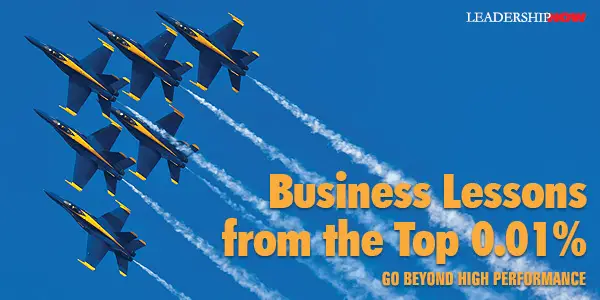
MORE THAN 400 climbers have reached the summit of Mount Everest. There are currently 2450 active Navy Seals. 536 astronauts have journeyed into outer space. But since 1946, only 257 pilots have flown as Blue Angels. In other words, 0.01% of all U.S. military pilots in history have achieved the unparalleled performance symbolized by the Blue Angels gold helmet. And consider this. Throughout the Navy, all personnel are reassigned every three years. That means for the Blue Angels, each year, roughly a third of their colleagues and half of their leadership are brand new. That kind of disruption would put a huge strain on any team if the culture were not designed to handle it. Former lead solo Blue Angel pilot John Foley writes in Fearless Success: “In a high-performance organization, individual talents will come and go, but the culture and the process of the organization need to be so strong that change doesn’t negatively impact forward motion.” Could your team or organization continue to function a high level with that kind of change? What the Blue Angles do is inherently unforgiving. They must get it right each and every time they are called on to perform. Just getting by is not an option. Foley shares how the Blue Angels make that happen—the processes, the culture, the values. But fundamental to all of it—always running in the background—is a mental approach he encapsulates as the Glad To Be Here mindset. That phrase drove them to be the best they could be. Glad to Be Here Mindset Glad to be Here is about respect and gratitude. It represents a shared purpose that is larger than the self. It requires a large degree of self-awareness. It is the “differentiator, the spark, that ignites all of the key elements that teams are looking for, such as chemistry, trust, and camaraderie. When people actively engage with this emotion and allow it to define their being, it promotes a state of mind that allows for open and honest human interactions with more efficient outcomes.” I found it especially instructive that they used it in their debriefings. I’m jumping ahead a bit here, but this is critical. You can really see the value of this mental approach in action. As each team member contributes to the debrief, they end their comments with “Glad to be here.” And here’s why: “This statement reaffirms your commitment to the team, and over time, it can remind you of your purpose larger than self. It’s an acknowledgment for your thankfulness to have the opportunities and challenges that life presents. While emotions vary day to day, the intent is to stay aligned to a positive mindset.” It signals to the other team members that my comments reflect my commitment to the purpose of the team. “We are aligned.” Glad To Be Here is most important in times of trial. Reminding yourself of the sources of your gratitude is an awesome way to drive out fear and immobility. It connects you back to your higher purpose. It refocuses the mind on the positivity, allowing you to spot new opportunities for innovation and execution. It’s the differentiator that can turn a bad situation into a great success. Now on to the process. The Diamond Performance Framework This framework (DPF) takes the basic concepts of vision, plan, execution, and feedback to a new level. The DPF provides a process to achieve high performance. It is a cyclical process designed with continuous improvement in mind. What unifies the DPF is the CenterPoint. The CenterPoint is your “north star,” and every team needs one. It is your reference point for all decisions. “It provides you with a sense of ‘true north’ that allows you to react quickly in changing situations. It keeps individuals and teams focused on specific goals and outcomes.” Ask yourself, “What is the CenterPoint of my life? What is the one thing that all of my actions flow through, that informs key decisions I make?”
1. Belief: High performance begins with a belief, and we perform at our belief level. If you raise your beliefs, then you can raise your performance. If you never raise your beliefs above your current reality, you can never achieve the performance of the top 1% of performers in their field. So, we have to be clear about our beliefs and then ask how do I raise those belief levels. On a path of continuous improvement, you are constantly resetting your goals to the next level. So, step one is a commitment to liberating beliefs and continuous improvement. 2. Brief: Before every flight, the team assembled to brief their upcoming performance. “The brief is the place where you take your focused, elevated beliefs and turn them into consistent, efficient actions.” The brief is sacred. And together with the debrief, it provides a feedback loop that takes everything you’ve learned and applies it to upcoming actions. Foley stresses that this is not a planning exercise. Rather the purpose is preparation and focus. The goal is to “bring collective preparation and focus to future actions.” This is where they connect, align, and commit. The key here is dynamic focus. This is the ability to be task focused while maintaining an awareness of the overall situation. “It creates rapid compartmentalization, followed by immediate execution.” 3. Trust: High trust is the key to execution. In the Blue Angels, trust is critical. It provides a “clarity of mind” that allows them to focus on the task at hand. It is not taken for granted. Foley notes that it is something that they work on constantly—earning it every day. It becomes a contract between each of the team members. It becomes a source of strength that the team can draw on. The key is strong communication. Competency, commitment, and consistency. Your working relationship becomes nonverbal, but you understand it concretely. When you reach predictability—when you can trust, inherently, without thinking, in the actions and character of yourself and those around you—true high performance becomes possible. 4. Debrief: This is the platform for continuous improvement. It is an “inward look for an outward result.” In the debrief they look at the good and the bad together. “We focused on the aspects of what went well so we could continue to improve. We shared areas where we were out of parameters; we made contracts to adjust our actions in the future.” Feedback is key. And every contribution ended with, “Glad to be here.” The Glad to Be Here Debrief created a safe environment that drove out fear. The secret sauce is respect (safe environment), humility (check your ego), openness (openness and honesty), accountability (own it and fix it), and gratitude (glad to be here). The debrief is the key to rebooting the system and kicking off continuous improvement. The debrief allows you to reassess and elevate your belief levels, which brings focus to your highest potential. With elevated expectations, the brief allows you to prepare for your best action. Building high trust enables execution with commitment. And finally, the debrief allows you to process all of that information and imbue it with gratitude. There is much to learn here. The emphasis on gratitude is the ingredient that is frequently missing from leadership and team building. The insights in Fearless Success will have a huge impact on your leadership if you will incorporate them into what you do. This is how the best liberate their beliefs and move beyond what they thought they could achieve.

Posted by Michael McKinney at 05:30 PM
03.25.19

Are You Living in Conflict Debt?
WHEN YOU AVOID the tough discussions and decisions, you hold your business back, make your team dysfunctional, and cause yourself stress. You set up a kind of conflict debt. Conflict debt, writes Liane Davey in The Good Fight, “is the sum of all the contentious issues that need to be addressed to be able to move forward but instead remain undiscussed and unresolved.” The solution is more conflict, not less. “Rather than working through the conflicts that will help our organizations move forward, we avoid, postpone, evade, duck, dodge, and defer them.” We need to work through our contentious issues. Most of us are conflict adverse—as is the author—and she explains why we are that way. We have been conditioned to get along, but we often take that to mean that we should avoid all conflict or simply accommodate others. But she concludes, “conflict is a natural part of healthy relationships and a critical defense against unhealthy ones.” Conflict is normal. And we either can either make it better or worse. And that doesn’t happen by assuming we are right. We need to be curious about the other person or people and where they are coming from. After building the case for conflict, Davey turns here attention to avoiding unnecessary conflict and establishing the ground rules for productive conflict. She calls this the Conflict Code. To begin, you need to establish a line of communication. That is, build the trust before you need it. Next, create a connection so that you can problem-solve as allies rather than fight as adversaries. “When a discussion gets heated, the facts and information presented provide excellent clues about what is important to the players. Pay attention to what is (and isn’t) said to zero in on what’s at stake. Finally, if you have completed the first two steps, you are in a good position to contribute to a solution. She offers six techniques to help you contribute a solution without bulldozing the others at the table. In part 3, Davey focuses on “what you can do to systematize conflict so it’s a part of the standard operating procedure of your team.” This section is worth the price of the book alone. Her examples resonate as they seem to be so much a part of everyday team dynamics. Clarify Expectations Clarifying roles and setting clear expectations from the beginning avoids a lot of unpleasant conflict and drama. “If everyone is clear on their role and the value they are expected to add, they will be less likely to disappoint, or be disappointed by, others in the group.” To this end she has created the U Tool. The U Tool documents “what you need from your superiors, what your team will add, and what you expect from the layers below you” and “when that value should be added.” She covers issues that the U Tool can help to neutralize like the absentee boss and micromanaging. It also helps to raise the bar on expectations. This situation is something I see in my work as an advisor: Adding value at the wrong level can create considerable conflict in your team. First, when you neglect the strategic issues, you fail to provide the direction and context that your team needs from you. In this case, you become the absentee boss and set your team up to fail. The other issue is that as you dip down into issues and choices that should be made in the next level, you disempower the leaders whose job it is to be making those decisions. It’s demoralizing when you do their job as it robs them of their opportunity to add value. I’ve even seen leaders more than two layers above encroaching on the work of the individual contributors. One of my clients admitted sheepishly that he had been “belly-down in the bottom of the U.” He was simultaneously disempowering two layers of his team. Normalize Tension When we think about teams we think about conflict-free members all rowing in the same direction. This ignores he reality and our ability to deal with it—if we do. “You can be a good team player and still create tension with your teammates.” Davey introduces a metaphor called The Tarp. Imagine a group of people stretching out a tarp and each pulling in a different direction. If it’s all in balance it works. But what happens if one team member pulls harder than the others What if the strength of one member overwhelms that of his teammates? What if one of the team members gets fed up, rolls her eyes, and walks away? To get the best possible answer out of a team, you need to pull in different directions, always optimizing the tension on the system—never pulling so hard that you take the team of course, and never so gently that your angle isn’t covered. That’s what productive tensions should feel like. The common issues are when a team member is pulling too hard dominating the discussion. Or the opposite when someone is under contributing by staying silent or gives up presenting their point of view. The Conflict Habit Make productive conflict a habit. A habit you “engage in routinely without requiring significant attention and effort.” To add productive conflict into your organization, you might begin by clarifying expectations, add then adding some low-intensity conflict by offering another perspective, define consequences, and highlight assumptions. Improve your feedback by not loading up on judgments but observations. (Very helpful section.) She also suggests using humor and code words “to draw attention to troublesome behavior in a gentler way.” Finally, encourage productive conflict in your meetings. “Instead of creating a forum for productive conflict to be surfaced and resolved, meetings are often just hour-long displays of the power and politics on your team. The actual work of discussing and coming to a solution is relegated to side conversations and he dreaded meeting-after-the-meeting.” So often we see teams living in conflict debt. They let issues pile up until someone leaves or blows up. Introducing productive conflict will take the pressure off, encourage cooperation and help you get things done. The Good Fightis a well-written book on a critical issue. The examples are helpful and it includes a bonus chapter on how this can help at home. Templates and worksheets for the U Tool and for creating a diagram of your own Tarp are available on her website. 
Posted by Michael McKinney at 08:12 AM
01.25.19

The Fearless Organization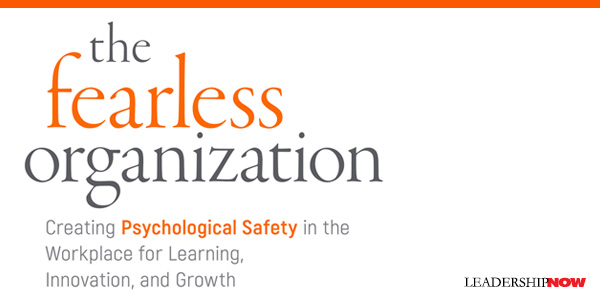
YOU’VE CAREFULLY put your team of people together, spent a lot of time getting the right people on the bus, your best and brightest, and yet you’re underperforming? Your team isn’t giving you everything they’ve got. People hold back when they feel it is not in their best interests to contribute—to say what they think. As a result of this interpersonal fear, we miss the benefit of the very minds we are relying on to move us forward. Creating psychological safety is essential in a world where innovation, integrity, and renewal can make the difference between success and failure. In The Fearless Organization, Amy Edmondson explains what psychological safety is and what it isn’t and how we can create in our organizations. We all—most of us—manage our image. Some better than others. But… No one wakes up in the morning excited to go to work and look ignorant, incompetent, or disruptive. These are called interpersonal risks, and they are what nearly everyone seeks to avoid, bit always consciously. In fact, most of us want to look smart, capable, or helpful in the eyes of others. No matter what our line of work, status, or gender, all of us learn how to manage interpersonal risk early in life. And it is this fear we have of looking bad or retribution that organizations must reduce or eliminate if we are to help people to bring their best to work. Psychological safety is not about taking all of the bumps and ruts out of the road (which sadly is becoming more and more prevalent in leadership thought today). Psychological safety is like the oil in the machine. It makes everything else you’re doing work better. It is an enabler. “Psychological safety makes it possible for other drivers of success (talent, ingenuity, diversity of thought) to be expressed in ways that influence how work gets done.” Without it, people will withhold thoughts, ideas, and contributions that are vital to your growth, renewal, and the overall health of your organization. It’s not about whistle-blowing. “Whistle-blowing is not a reflection of psychological safety but rather an indication of its absence.” Psychological safety is not about introverts or extroverts. It’s not about being nice. It’s not about creating an environment where people are talking all the time. You need discipline. The is to make it easy for everyone to get everything out on the table so that you can proceed in a thoughtful, calculated way. Psychological safety doesn’t mean sharing everything either. That doesn’t create a safe place to work. People will learn where to draw the line with constructive feedback. It’s an emotional intelligence issue. Psychological safety is not about lowering performance standards. It’s not an anything-goes environment. As the chart below shows, “psychological safety and performance standards are two separate, equally important dimensions—both of which affect team and organizational performance in a complex interdependent environment.
Psychological safety enables candor and openness and, as such, thrives in an environment of mutual respect. It means that people believe they can—and must—be forthcoming at work. In fact, psychological safety is conducive to setting ambitious goals and working toward them together. Psychological safety sets the stage for a more honest, more challenging, more collaborative, and thus also more effective work environment. One must build psychological safety to spur learning and avoid preventable failures, and they must set high standards and inspire and enable people to reach them. We owe each other our opinions and ideas, and it is the responsibility of leaders to create and reinforce an environment where people free to do that. Psychological safety is about unleashing talent across your organization. Creating a psychologically safe workplace is an ongoing function of leadership. Edmondson divides the process into three steps which she covers in detail: Setting the Stage, Inviting Participation, and Responding Productively. Setting the Stage This step is about framing the work to be done and how failure is to be dealt with. As GoogleX’s Astro Teller stated, “the only way to get people to work on big, risky things…is if you make that the path of least resistance for them [and] make it safe to fail. I’m not pro failure, I’m pro learning.” Inviting Participation Two mindsets are required here: situational humility and proactive inquiry. Humility is an obvious quality but not as easy to cultivate. Inclusiveness on the part of leaders helps in this regard. London Business School Profesor Dan Cable wrote, “Power…can cause leaders to become overly obsesses with outcomes and control,” inadvertently ramping up, “people’s fear—fear of not hitting targets, fear of losing bonuses, fear of failing—and as a consequence…their drive to experiment and learn is stifled.” No one feels safe presenting ideas to a know-it-all or someone who feels the need to be talking all of the time. Proactive inquiry is actively asking questions designed to learn more about an issue, situation, or person. We benefit from a diversity of views. Implement structures designed to elicit employee input. Responding Productively “It’s imperative that leaders—at all levels—respond productively to the risks people take. Productive responses are characterized by three elements: expressions of appreciation, destigmatizing failure,” and punishing clear boundary violations—reinforcing the rules of mutual respect.
There is a connection between psychological safety and learning. It’s foundational to building a learning organization. In an ever-changing world, learning and adaptability is everything. Edmondson admits that this is not an easy process. It’s not a natural process. Creating psychological safety is a constant process of smaller and larger corrections that add up to forward progress. Like tacking upwind, you must zig right and then zag left and then right again, never able to head exactly where you want to go and never quite knowing when the wind will change. It’s a necessary condition for success. What’s at stake is the future of our organizations. 
Posted by Michael McKinney at 03:28 PM
11.26.18

Leading Matters: John L. Hennessy on the Leadership Journey
A Leading Matters is about the journey. The stories he tells here are revolve around the ten elements that shaped his journey and how he relied on these traits in pivotal moments. The elements are relevant to any leader at any level. As he observes, the higher up you go the crises just get bigger and come faster.
Here are some of his thoughts on each element extracted from his stories: Humility A true sense of one’s own skills and character—arises not from ego, but from humility. Arrogance sees only strengths, ignores our weaknesses, and overlooks the strengths of others, therefore leaving us vulnerable to catastrophic mistakes. Leading with humility means letting others announce your accomplishments because you don’t need to, it means realizing and openly admitting that your understanding might not be right, it means taking the opportunity to learn from mistakes, and it means stepping up to the moments that challenge and grow you. Authenticity and Trust Authenticity is essential to building trust. Consider the wisdom popularly attributed to Socrates: “The way to a good reputation is to endeavor to be what you desire to appear.” It’s a start down the path to a deeper practice of authenticity—you must identify those good and true characteristics you admire, and then you must work to embody them. So this is part of the practice: identify the virtue you admire, strive to embody them, and be humble about the journey—you probably aren’t there yet. In fact, just when you think you’ve arrived, life has a way of returning you back to the beginning. Leadership as Service The larger one’s leadership role becomes, the bigger the role of service in that leadership. If you take a leadership role as a step toward a personal goal of gathering ever-greater titles, awards, and salaries, you will never see true success in that role. Recognize the service of others. As a leader it is easy to get wrapped up in big projects and ambitious initiatives, and, in the process, to forget the smaller, but no less important, individual acts of service taking place all around you. Much of that service supports and enables the widely celebrated success of others. Empathy Empathy should always be a factor in making decisions and setting goals. Empathy represents a crucial check on action—placing a deep understanding of and concern for the human condition next to data can lead to decisions that support the wellbeing of all. Empathy usually implies compassion and perhaps charity, but we are looking for more than that: we are looking for the kind of empathy that changes people as a result of their interactions with each other, the kind of empathy that arises when one sees the world anew through someone else’s eyes. Courage Humility, authenticity, empathy, service-mindedness—these characteristics shape a leader’s vision and chart a course toward right action. Courage, on the other hand, compels a leader to take that right action. While many people can discern what is right and true, acting on that discernment is more difficult. Even if risk-taking is against your nature, for the good of your organization, you must find the courage to practice it. Collaboration and Teamwork Most significant endeavors will be accomplished by a team. Certain ground rules circumvented interteam rivalries. First of all, I reminded everyone of our shared goal: we wanted to achieve something great. Further, to support innovative, cross-disciplinary thinking, I set a second ground rule: at the start, we don’t criticize ideas. To this, I added a third ground rule: tough questions aren’t only allowed, they are necessary. This led to my final ground rule: team members must be treated with the utmost respect. Innovation I can’t tell you how many times I’ve had this conversation with students: the student opens with, “I want to create a start-up.” I ask them to tell me about their technology, and they answer, “Well, I don’t have it yet, but I want to do a start-up.” I remind these students that great start-ups begin with great technology discoveries. Innovation presents great opportunities for smart entrepreneurs, not the other way around. Intellectual Curiosity Beyond personal enjoyment, though, this lifelong curiosity has served me well in my career. It has enabled me to engage in meaningful dialog about the world and its future. Literature, biographies, and histories—they’re like laboratories in which we can examine and learn critical lessons without having to live the difficulties ourselves. In challenging moments, great leaders show their true character. …Their stories taught me if you can’t take the blame for failure, you shouldn't take the job. Storytelling If you really want to inspire a team to action, best to engage them with a story. Once they become receptive—once they can imagine themselves as part of your vision—you can back your story up with facts and figures. When you turn that dream into a vivid story, you make it so attractive and so real that people will want to share it with you by joining your team. When it came time to respond to change, these companies moved quickly and efficiently, because every employee already understood the company identity and therefore knew how to respond without direct coaching. In every profession and career, as we climb to higher leadership positions, the role of facts and data decreases. Legacy Instead of worrying about my legacy too much or too early, I’m choosing now—as I always have—to follow the path of making meaningful contributions. Legacy means the institution serves people more effectively now than it did when you arrived. 
Posted by Michael McKinney at 02:08 PM
11.14.18

The 8 Elements of Punk Rock Business
O The title of Jeremy Dale’s book, The Punk Rock of Business, comes from a comment Bono made to Oprah about a project Dale was working on with him for Motorola. Dale and his team had performed the impossible and Bono said, “They are the punk rock of business: no long introductions, three beats and you’re in. They say they are going to do something, and then it just gets done.” Using that as an inspiration, Dale has taken it to mean so much more. Punk is an attitude. It’s a fight against apathy and complacency. “I’m not okay with the current status quo. We’re into disruption.” Many businesses these days are clogged up by bureaucracy that thwarts innovation, slows down creativity, and encourages mediocrity. I hate mediocrity. I’d much rather have spectacular success or fantastic failure. I believe mediocrity occurs far too often because too many people in business, particularly those in middle-management roles, are far too cautious, pessimistic, and more concerned about protecting their jobs rather than striving for greatness and being everything they could be. They are fearful of putting their heads above the parapet, so they take a play-it-safe attitude and come up with the conservative, tame, and expected proposals. Dale has distilled the punk rock movement to eight elements. These 8 elements of Punk Rock Business were at the heart of punk rock music, movement, attitude, fashion, and culture. Elements that are wanting in many organizations. Element 1: Have a Cause “Punk was all about wanting something better, being clear about what that was, and making that their cause.” Have a point of view. Find something you’re passionate about and then inspire your team to deliver it. An organization’s mission statement is meant to direct every single decision. A mission statement may not be enough. You may need to create a manifesto to add substance and emotion, creating a story around the mission statement. “We should be committed to being a lighthouse brand; that is, one who shines brightly, whose position is fixed so that people can navigate their world trusting in us and our position on things.” Well put. Element 2: Build a Movement “Punk was attractive to like-minded people, and it galvanized that segment of the youth. Punk, more than music, was a mindset, and that attracted people.” It’s all about the people. The followers make the movement. You must get other people on board. Show your commitment to them and the mission by showing up. This is where you bring your emotional brain and not your rational brain. Element 3: Create New and Radically Different Ideas “Punk was completely different—never seen before jaw-dropping creation that exploded into our consciousness. No one was ambivalent to punk; you loved it or hated it.” It’s about creating new, different, and better ideas. After all, that’s what leadership is. Punk provided an avenue to express their frustration with the dead-end society that they saw at the time. “Never before had music been played at anything like two hundred beats per minute. Never before had music been played so loudly or aggressively. Never before had the lyrics to the songs been so politically charged or laid siege to taboo subjects.” Begin by finding out what’s different about what you’re doing. What problem are you trying to solve? Radical ideas come from teams. And when they do they need to be brought to life by showing, not telling. Radical ideas are targets and so need to be protected. “Every project should have a vision and some nonnegotiables. The nonnegotiables are so important, because not only do they prevent the willingness to compromise, they also act as the catalyst for intelligent people to seek creative solutions when the inevitable challenges arrive.” Element 4: Drive Speed and Action “Punk was three beats, and you’re in.” Go for it. “When time is tight, great things happen.” You don’t always have to be right. “Decision-making is a portfolio. Not every decision needs to be correct.” The momentum is the important thing. Element 5: Say It as It Is “Punk lyrics came with a contagious honesty.” No nonsense. You have to say it like it is—but constructively. Sometimes you have to call others out, and sometime you must call yourself out. Don’t leave people wondering what you think. Speaking plainly saves time, bring clarity, and sets the performance bar where you want to set it. Element 6: Be Authentic “Punk gave people permission to be themselves.” Probably the only rule of being punk is: “to be yourself and be comfortable being who you are.” Surround yourself with confidants who will hold you accountable and call you out when you are being a fraud. Element 7: Put Yourself Out There “To be punk you had to make a very visible and belligerent statement; it required you to put yourself out there, say ‘this is me,’ and invite criticism. It was far more important to just give it a go, rather than to get it perfect.” Grab every opportunity to challenge yourself. Be the first to volunteer. You will be criticized. Get used to it. “You will not always get it right, but my experience is that the impact you have when you do get it right far outweighs the embarrassment when you don’t.” Are you a participant or a spectator? Element 8: Reject Conformity “Punk pressed the reset button.” Nonconformist. “However, it wasn’t just its nonconformity, it was the extent to which it didn’t conform that was shocking for many.” Some norms are pointless and irrelevant. “Today’s corporate world is full of mediocrity, slowness, politics, false praise, and people too scared to say it as it is. More and more employees are disillusioned with lukewarm leadership that makes their jobs dull and boring and constrains their creativity, imposing limitations rather than empowering them.” Don’t take yourself too seriously. “Get over the show, get over your ego, and react based on the quality of work, not the superficial stuff that doesn’t matter.” Joey Ramone said they started a band because in 1974 everything was overproduced. “Being overproduced and perfectly organized kills the lifeblood that spontaneity brings.” Humility is the X-Factor “Punk by its very nature is aggressive and in your face.” Humility keeps you out of trouble. “Punk doesn’t need to be aggressive if you apply a degree of care and humility. If people see that you are fundamentally a good person, whose heart is in the right place, whose motives are pure, who has charm and charisma, who isn’t arrogant or conceited, who cares about people, and above all else is human and has humility, then you can apply all eight elements without worrying if you’re going too far.” Dale adds fifteen more key requirements that are needed to implement a punk rock attitude in business. Unfortunately, I have not conveyed in this commentary the great stories that are used throughout to illustrate the 8 Elements of Punk Rock of Business. They are engaging and entertaining and really help to develop the concept. Well worth the read. The book provides a much-needed perspective on business and leadership in a very unconventional way. 
Posted by Michael McKinney at 07:14 PM
10.29.18

Michael Lombardi’s Lessons in Leadership
M In Gridiron Genius, you will certainly get the inside scoop on the game of football, but it’s much more than that. As a three-time Super Bowl champion, Michael Lombardi provides lessons in organizational culture, team building, strategy, and character. His philosophies on how to build championship teams were foundational for the teams built by both Walsh and Belichick. Organizations of all types will benefit from the insights found here. “Football is ultimately a business, and as in any successful business the most important ingredients are a sound culture, a realistic plan, strong leadership, and a talented workforce.” So let’s look at some of the leadership lessons to be found here. The main lesson that comes through his experience with great coaches and owners is that culture comes first. “If you haven’t created an underlying ecosystem of excellence, short-term success is all it will ever be.” On Bill Walsh building the San Francisco 49ers in 1979: “From the talent on and off the field, to the quality of the workplace, to the practice fields. No detail was too small for Walsh to consider because, to his assembly line way of thinking, only the sum of them all could produce the organization he wanted. As he was fond of saying, if he managed to perfect the culture, the wins would take care of themselves.” He writes: “Character assessment is by far the hardest challenge for team builders. More than any other factor, inaccurate character assessment is why draft boards are to this day littered with so many mistakes. For starters, let’s be honest, there’s a sliding scale of morality in the NFL (as in every industry), in which the more talented a player is, the more he can get away with.” “Each player retains information differently, and it’s the coach’s job to determine the best way to instruct him.” What Makes a Great Quarterback? A winning way. (Winning is a habit.) A thick skin. (The measure of who we are is how we react to something that does not go our way.) Work ethic. (Your best player has to set a tone for intolerance for anything that gets in the way of winning.) Football smarts. (A quick mind come with preparation. You prepare so well that you don’t have to think; you just react.) Innate ability. (Born with it quality: Walsh couldn’t define it, but he knew it when he saw it.) Carriage. (Quarterbacks have to inspire. They can always look as if they have it all under control and that somehow they will figure out how to lead the team to victory. No one wants to follow a sulker.) Leadership. (Quarterbacks who fail to gain the respect of teammates leave a team rudderless.) Building a team: “A big part of Walsh’s genius was his uncanny ability to spot a quarterback in a crowd. Even from a distance and after only a few throws, he could sense immediately if a quarterback could run his offense. Guys like Walsh and Belichick are unusual this way: They can visualize how skill sets fit in their schemes in a way that both maximizes those abilities and fuels the system.” From Bill Belichick: “Although practice doesn’t make perfect, it gets you closer to perfection each time you do it.” “We aren’t collecting talent; we are building a team.” Mental Toughness: Doing what is best for the team when it might not be the best for you. If players can fight past exhaustion, if they can focus when they’re completely drained, well, that’s mental toughness. On Bill Walsh: “His meticulousness was evident everywhere.” “Walsh opted for less experienced men who shared his curiosity and displayed a willingness to learn his system and methods.” What Makes a Great Coach? Command of the Room. Followers need something to commit to. A leader has to have a plan. On Nick Saban at Cleveland: He had a strong plan and an effective way of communicating that plan, and his ability to be self-critical earned the players’ trust in a way that rivaled their feelings for Belichick. Command of the Message. What good is the plan if you can’t talk about the plan? Players can’t accomplish anything unless they can visualize the path. Delivery isn’t as important as meaning. Command of Self. Personal accountability is the ultimate sign of strength. Sophocles sums it up best: “All men make mistakes, but a good man yields when he knows his course is wrong and repairs the evil. The only crime is pride.” Ego is the leading cause of unemployment in the coaching world. Command of Opportunity. Becoming an NFL head coach is a process. You learn on the fly. In the beginning, it is likely you’ll be bad at it. You just have to keep working at it until you get good and pray that you don’t end up a one-hit wonder. Command of the Process. A leader must be fair and consistent. When rule don’t apply to everyone, the ensuing chaos collapses whatever foundation a leader has tried so hard to build. In a particularly good section of the book, Combating Complacency he talks about how Belichick and Walsh fight complacency. This was interesting: “Whether the Patriots have just won the Super Bowl or not, the first thing Belichick does is wipe the slate clean. One of his favorite sayings is, ‘To live in the past is to die in the present.’ It’s why you see no Super Bowl trophies as you walk through the players’ entrance and why all the photos from the previous season are removed as soon as the season is over. That clean slate demands a trip back to basic principles and fundamentals after a detailed examination of the current process.” He adds, “What impressed me the most about Belichick and Walsh in their self-awareness. With the same kind of success in the NFL many lesser men have become close-minded, authoritarian, and lazy.” Of Related Interest:

Posted by Michael McKinney at 12:16 AM
09.03.18

Business Chemistry: What Type Are You?
T Business Chemistry is a tool for self-understanding and empathy—a way to identify meaningful differences between people’s working styles and perspectives. Kim Christfort and Suzanne Vickberg of Deloitte helped to develop Business Chemistry. It does not invalidate everything else of its type, rather it is designed to be simpler and thereby memorable and actionable on issues that really matter for people in the work environment. And it is quite straightforward for both accessing yourself and others you work with. Using the key sticking points between people, they identify 4 Working Styles:
The authors naturally go into detail on each of these types and give an example of a well-known person that fits that type. They also delve into difference between the types as they relate to stress (Pioneers are the least stressed.), career aspirations, environments they thrive in, and where each type if found organizationally and generationally. The trick of course, is to use this knowledge to modify you own behavior. Otherwise it’s just a game. “By learning about your own type and developing a hunch about the types of those you work with, you can see right away where some of your key differences and similarities are. Then you can determine how you might flex your own style to better match the preferences of those around you.” For example, too many constraints can completely shut a Pioneer down, while a Guardian may withdraw in an environment that feels too chaotic. A Driver may become very frustrated in an organization that lacks decisiveness, while an Integrator may wither on a team that doesn’t value broad-based input. Knowing these trigger points can help you as a leader to give people more of what they need to excel and less of what will turn them off. To understand your own style and develop your hunch about others you know, they’ve developed a test which you can take here. If you’re going to try it out for yourself, you might think about what you are naturally inclined to do and what you have learned to do. I might want to be direct with others but I have learned that I am more productive when I am diplomatic. But being that that is my natural tendency, I probably prefer when people are direct and concise with me. That fact would affect my working style profile. Interestingly, 32% of Millennials are most likely Guardians. They prefer having all of the answers and enjoy zooming into every detail. 29% of Baby Boomers are most likely to be Pioneers or Integrators. They grew up in a different time and may have adopted a more novelty-seeking and relationship–focused orientation. 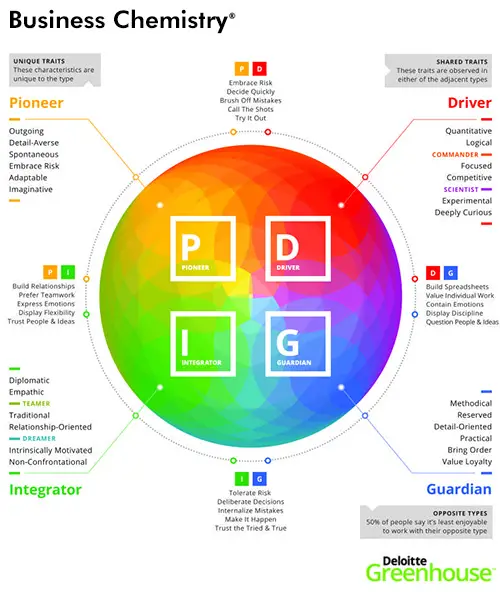 
Posted by Michael McKinney at 08:21 AM
03.26.18

Getting to US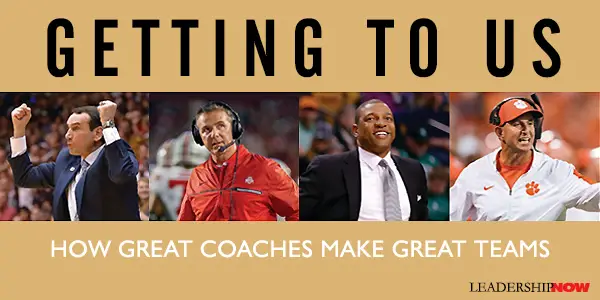
S Davis asks, “How do great coaches turn a collection of individuals into a coherent us?” He narrows it down to four personal qualities that are the core requirements all great coaches must have in order to get a group of individuals to Us. In Getting to Us, Seth Davis interviewed nine coaches of football and basketball, college and pro. And not only the coaches but also their wives and families, their friends, their players, and colleagues. Nine very different men with very different personalities. This is really the task of every leader, but interviewing sports figures is a good place to start learning about building teams that can perform at a consistently high level. The four core qualities form what he calls the PEAK profile: Persistence, Empathy, Authenticity, and Knowledge. In each of the nine coaches' lives, their PEAK profile was forged in different ways. It is interesting to read how each one of them was transformed by life experiences to learn persistence and empathy, how to be themselves, and how they acquired and continue to acquire the knowledge necessary to excel in their profession. You’ll find that it is a lot of small things consistently done right, that brings them success. At the same time, there is the humility to modify what needs to be modified for the sake of the team. It is interesting too, that while each possesses these four qualities, they each express them in unique ways so that there is no secret to replicate. They each had to learn to do what was right for them.
Empathy is the most important of all of the qualities. Empathy is being sensitive to the feelings of others. “A great coach must find ways to learn about his players, taking time to acquire the critical information that will lead him to understand how the player’s mind, heart, and guts operate.” Authenticity is remaining true to yourself and acting accordingly. “What makes them great coaches is their refusal to be something they are not.” It’s finding what works for you and not deviating from it, “particularly in those critical moments when the team must function as a single unit or suffer defeat.” Of course, the team has to believe that you have to believe that you know what you are doing. “Acquiring this knowledge take time and passion.” It’s a life-long pursuit. But there must be humility in the mix. “Knowledge without adaptability will eventually diminish a leader’s effectiveness. People change, games change, times change. Life authenticity, knowledge is an important step on the pathway to trust.” Here are some of the instructive excerpts from several of the coaches he profiled: Urban Meyer—Head football coach of the Ohio State Buckeyes His sabbatical taught him the importance of living a balanced life and conserving energy, which replenished his persistence. Having to face his own weaknesses and limitations deepened his empathy. The time off gave him a chance to reevaluate what was important to him, which reset his authenticity. Tom Izzo— Head Basketball Coach of the Michigan State Spartans The principles he learned in the family store: Show up. Work hard. Give back. Stay humble. “From day one he creates a family atmosphere and makes it known that he cares about you as an individual.” “I spend time with my players. That’s how I get to know them and can determine which way I need to go with them.” It takes more than a coach to get to Us. “I’ve always said, a player-coached team is much better than a coach-coached team.” “I worry about all the time spent on Twitter. That’s why there are no leaders on teams anymore. Kids can’t communicate. … We’re teaching kids that they should have your own ‘brand.’ Be your own guy. So now at fifteen, fourteen, thirteen, it’s me me me me me me. This is not about old school/new school. It’s about right school/wrong school.” Mike Krzyzewski—Head Basketball Coach of the Duke University Blue Devils [and that’s Sha-SHEF-ski] “Failure is not a destination, and you’re never going to do it alone.” Practice plans were scheduled down to the minute, but they also included notes explaining how each drill would prepare the team for its next opponent. That allowed his players to visualize the big picture. “I don’t coach for winning. I coach for relationships.” He wants his players to be instinctive, not calculating—to follow the courage of their convictions, just as his grandparents did when they set sail for America. Instinctiveness begets adaptability. Doc Rivers—Head Coach for the Los Angeles Clippers It is through this balance between coldness and empathy that Doc Rivers gets his team to Us. When critical moments arise, he doesn’t play the victim and he doesn’t want a hug. He’d rather pivot and get moving, trusting that is players will follow. “I learned from [Pat] Riley that the key to coaching is to get a group of players to believe there’s one agenda and that you have the same agenda as them. If you can do that, your players are going to do whatever they can do for you.” Brad Stevens—Head Coach for the Boston Celtics As a college player to his coach: “What are supposed to do, just lay down for these guys?”—[Coach Bill] Fenlon gave him his first lesson on leadership. “No, you should play hard,” he said. “But do it in a way that brings them along. Don’t create a divide.” Stevens says, “I became content when I came to the conclusion of, ‘Hey moron, it’s not about you. It’s about being as good of a teammate as you can be and putting your best foot forward every day.’” “Do you want to be around somebody who lifts you up or somebody that breaks you down? That’s why whenever people ask me what’s your leadership style, my answer is, ‘It should be you.’ There’s an authenticity that is needed for leadership. If it’s not real, then it’s not going to work.” “I think a lot of people in sports have missed the boat on mental health. You have to be empathetic in knowing that everybody has their own lives, and everybody has something tough going on. You need to make sure you understand that before you coach them.” “Toughness is doing the next right thing.” “All the good ones want to be coached.” 
Posted by Michael McKinney at 11:19 PM
12.20.17

Lead Your Tribe, Love Your Work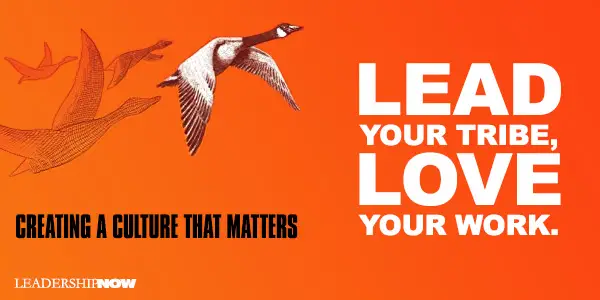
A Piyush Patel, the founder of Digital-Tutors, found himself in just that place after his company began to grow and the sixteen-hour days that were once energizing became draining. Stuck in the weeds, putting out fires, he needed a change. In Lead Your Tribe, Love Your Work, he describes what turned it around for him was defining his values or as he called them, “Rules of Our Game because they were the bare minimum for someone to play on our team.” The five values he and his wife Lisa crafted transformed their company from a place he hated to go into a place he loved to call home. Values, your company’s culture, comes from the heart. They can’t be borrowed or manufactured because they have to be your own. They aren’t something you want to achieve. They are your reality—what you believe. Ask yourself, “What are the rules? What would you never do under any circumstances? A healthy culture has three needs. Belonging. Think of geese flying together. The goal is to make it together. We need to belong to something greater than ourselves. “We want to identify with the people with whom we spend most of our day.” One of the best ways to create that sense of belonging is through shared experiences and company traditions or rituals. Annual road-trips, progressive dinners, Thai Thursdays, having a beer in the break room and other casual activities that create shared memories. Affirmation. “We want to be individually recognized and appreciated in a way that means something to us.” Affirmations are more than just saying thanks. It includes listening, assisting, giving quality time and gift-giving. As important, is making them the hero of the story in front of their loved ones. Taking the time to do these things instills core values into the tribe. Meaning. “We want know what we do makes a difference.” Collect stories of how your organization changes lives. “Meaning goes deeper than just what you do. Meaning goes down into the heart of why you do it.” Meaning goes beyond the transaction with your customers. Make them part of the tribe too. Talk to your people to get a pulse on your culture at least once a week. Just listen and say thanks. Begin by asking questions like: • What’s one thing that makes our culture unique?
Focus on the why and make sure your tribe knows what it is. 
Posted by Michael McKinney at 06:19 PM
12.15.17

Pass Judgment
P We learned this the hard way in NASA Mission Control’s management team. What started as a top executive trusting his senior managers to run their divisions rather than discussing challenges or weak performance in front of their peers, evolved into an expectation to keep your criticisms of the other divisions to yourself. Over time, this evolved even further to not even mentioning any significant issues or challenges in management meetings. The management team mantra became, “No ripples in the pond.” While this led to polite, non-confrontational, and seemingly collegial meetings, it also meant an ever-growing list of cost, schedule, and technical problems that were not being addressed or even on the radar screen of the senior management team running our $650-million/year enterprise. True to the stereotype of government organizations, we had become known as a “marching army” who cost way too much and still did things the way we had for almost 50 years. Our customer program managers were seeking to abandon us and find any other team to turn their spacecraft over to because they had lost faith in our ability to control costs, even though they still considered us to be the best operations team on the planet. Worst of all, most of their criticisms were well founded, and we had become culturally incapable of discussing and doing anything about them as a management team thanks to “no ripples in the pond.” Judgment Can Set an Organization Free Then we looked outside our walls by benchmarking operations teams in several different industries, in both the government and the private sector. We were shocked to find example after example of teams who not only were better than us but also made us look like amateurs in some areas, including some that we considered core competencies. That was the game changer we needed. From that realization, we knew we had to put the “ripples in the pond” and discuss where the organization’s performance was lacking. Choosing otherwise meant that instead of being part of the solution, we were the problem. We started passing judgment rather than hiding from it. We identified management practices that were contributing to our decline and those that we needed to change or implement to improve. The goal then became intentionally performing at the highest level, which we all knew was the intended standard of our high-performing organization all along. We weren’t making personal judgments about each other, but we became adamant in holding each other accountable to this transparent, value-driven, fully engaged style of managing. It set the tone for every discussion whether the decisions entailed our technical work, strategic risk, business management, personnel development, or any subject. Over time, it became a natural part of doing business. We completely upended “no ripples in the pond” with a formal policy of “clarity over diplomacy.” Rather than getting in our way, this level of candor and on-going judgment increased the trust across the team. This genuine and open collegiality also led us to management practices and business strategies we otherwise could not have developed without the talent and experience from across the full management team. As just one measure for how that affected organizational performance, in the course of two years we were able to reduce total costs to our customers by half while performing the same work and still delivering the expected high-quality support. Judgment Can Enable Personal Growth Learning to pass judgment about team behaviors is one thing, doing the same individually can still be a challenge. A respected senior executive once told me, “Nobody’s any better or worse, really. They’re all about the same talent level. There’s nothing you can really do as a manager to change that.” In practice, this individual version of “no ripples in the pond” feels nice because it avoids the discomfort that can accompany passing judgment. But it also keeps us stuck, because, of course, we are not all the same. We all have different strengths and different weaknesses, and top performance requires us to first understand both. In the same way that benchmarking helped our management team, personality assessments (Myers-Briggs, Birkman, DISC, etc), feedback, and executive coaching are all great tools for gaining insights into our individual strengths, weaknesses, and how we affect others because of them. With that awareness, we can then make judgments about which of our behaviors help the organization be successful and which get in the way. Rather than being critical, these judgments are aligned to the team’s success, and with them, we can choose to deliberately improve. See The Ripples in the Pond The ripples are already in the pond in everything we do. The question is: Are we willing to acknowledge them and proactively do something about them? High-performing teams and individuals do not ignore the ripples in the pond – the indicators of problems that could erode success and lead to failure. They learn to see them and do something about them. That requires passing judgment, but this isn’t about judging individual worth. It is about judging our behaviors and how well aligned they are to the team’s success. With that understanding, critical judgment becomes less threatening, and the actions required to improve likewise become easier to identify and implement. From those judgments, the highest performing teams are able to harness the strengths from across the team, while also working around or improving each of our individual weak areas. They are then best equipped to handle challenges and identify opportunities. That’s leading.    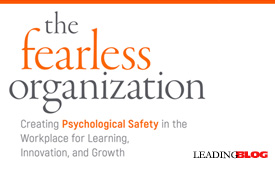
Posted by Michael McKinney at 07:19 AM
12.13.17

Commanding Excellence with Purpose, Passion, and Ingenuity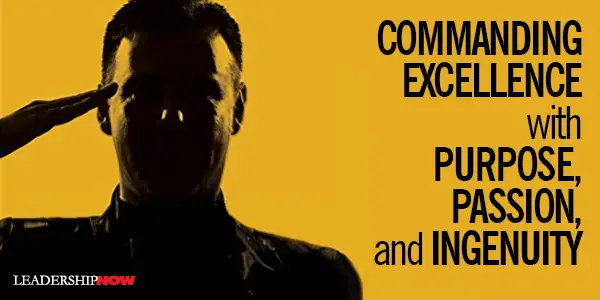
G Commanding Excellence describes how these two leaders led their respective organizations to incredible success. Fred Dibella says the account is “about everyone signing up and them pulling their weight, so the whole becomes greater than the sum of its parts.” What made these organizations stand out was the simplicity of their leadership driven by an absolute clarity of purpose, empowered obsession, and unleashed creativity. Morton illustrates how each of these was manifested in these organizations. Absolute Clarity of Purpose The first all-important question to ask is, “What are we trying to achieve?” After that, all distractions were eliminated or deliberately de-emphasized, and a playbook was developed to codify the mission. “Success would not come from devising an ingenious plan for each battle but from hard work in executing the six simple plays that relied on disciplined execution.” Having this kind of clarity simplifies managing. In most cases, decisions did not require higher-level endorsement; the purpose served as a guide. What made it work is that everything was structured around the mission. There was accountability at every level as lines of authority were drawn, “first and foremost, for maximal effectiveness in combat, and, second, for effectiveness in training and preparation. The mission-focused structure was decentralized from the standpoint that each commander was given great freedom to execute, but they were also expected to cooperate with the decentralized companies and share everything with other teams. Morton credits the structure working because it was developed and built around strengths. “Dibella did not believe that all men do all things well, and he felt it was foolhardy to ask them to do so.” Brown did the same thing at Stryker with his 20-percent annual growth goal and the mantra: Invent it, make it, sell it. “Everyone in the organization knew the goal, acknowledged how important it was to the organization, and understood how they could contribute to the achievement.” Empowered Obsession Clarity isn’t enough. “Clarity was the foundation, but the walls and roof were built around shared obsession.” Brown and Dibella drove this obsession. They were both “seriously afflicted by an absolute, monomaniacal obsession, and spreading that obsession throughout the organization—every person, process, and method of measuring anything meaningful—was central to their leadership.” Everyone felt a deep personal ownership of the goal and knew that their actions were absolutely essential to attaining it. What you did mattered and it was rewarded. Stability in the teams was important. 4-68 leadership determined that “gains from stability—mainly unit-to-unit and soldier-to-soldier relationships—would trump any gains that might come from tailoring the organization for a particular mission.” Morton notes that “Greatness may require all-star talent, but only when a group of talented individuals is stabilized and able to bond into a cohesive team over time so they deliver their top performance.” Unleashed Creativity Clarity of purpose provided the why. Obsession delivered the high-performance. And unleashed creativity made it possible. Ingenuity was essential. “The thirst for better ways of doing things was deeply interwoven into the organizational mindset.”
Rank plays no part here. Ideas are elevated on their merit. Dibella “embraced every new idea that moved us closer to the goal.” In each organization, their purpose required radically different methods and new thinking. “Both leaders exhibited a considerable understanding for mistakes of the mind but little for mistakes of the heart.” 
Posted by Michael McKinney at 07:54 AM
11.17.17

4th and Goal Every Day
O The secret is that it is fourth and goal every day. Phil Savage of the Crimson Tide Sports Network, explains in 4th and Goal Every Day: Alabama's Relentless Pursuit of Perfection, “Alabama goes for it. Alabama wins more than anyone else because it is 4th and goal to these people in Crimson every practice, every meeting, every game, every day. Do not underestimate the power of that mindset.” When they find themselves in a chaotic game situation, Alabama is prepared because, as they say, “We played this game four times already this week.” You play the game the way you practice, says Saban. Daily urgency is core to the Alabama program. Saban is concerned about the details—the fundamentals. “The fundamentals and practice regimen require players to play to a standard. They do not play to the level of their opponent. They play to a standard set by Nick Saban and established by the team leaders.” Linebacker Dillon Lee said, “We would go in the game and everyone just feels like we played this game. It’s not going to be more physical than practice, it’s not going to be harder than practice. Everything will be slower, based off how we practiced.” Phil Savage says these are life lessons being taught on the field. “The Alabama practices reveal the grit in their players, one by one. Players learn determination and how to deal with adversity.” He adds, “What parents want to happen after four years is to see that their son came out the other side of the Process with resolve and a will to succeed in life. The parents covet the diploma, but they covet most the work ethic players are taught in practice, the forty-year bargain with Nick Saban, not the four-year deal.” How might some of these concepts play out in your leadership and impact your team or organization? Some more thoughts from Phil Savage and co-author Ray Glier: The Crimson Tide does not just recruit high school players, it evaluates them psychologically to determine if they can fit into the culture. Alabama is a demanding place to play, and the staff will dig in on a prospect and investigate how he handles criticism or being corrected. Mental makeup is important, critical, in recruiting a player. If you are a high school player with all the measurables and you did not get offered by Alabama, look in the mirror. 
Posted by Michael McKinney at 03:01 PM
06.28.17

4 Characteristics of Great Teams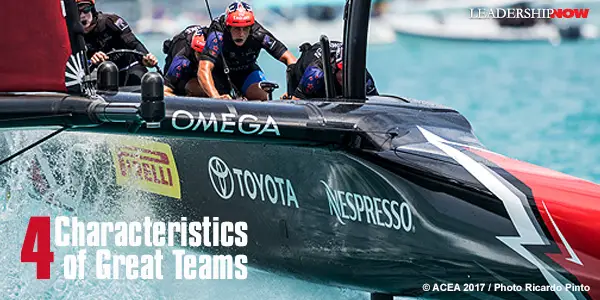
T This year at the 35th America’s Cup in Bermuda, Team New Zealand beat the defending Oracle Team USA. What made their victory possible was a new team with a new approach. Great Teams Serve Each Other Team New Zealand operates as a team. Skipper Glenn Ashby said, “Everyone on this team is as important as the next guy. It’s a whole team policy where we have a belief in the collective power as a whole and not any one individual to get the job done.” A cyclor for New Zealand, Andy Maloney, added, "We pride ourselves on not everything being put into [skipper] Peter [Burling’s] or Glenn's hands. Whereas you see Jimmy Spithill and Tom Slingsby [of team Oracle] pretty much doing 99 percent of the work on the other boat.” When all members of the team serve each other through many small acts of service they balance out the whole team. Great Teams Maintain Their Composure and Focus Team New Zealand CEO Grant Dalton made an effort to stay behind the scenes. He also placed emphasis on the importance of the crew as a whole rather than individual team members. Team New Zealand believed they could win despite the odds and remain determined to do so despite the skeptics. Great Teams Overcome Adversity After their defeat four years ago, the New Zealand team was fractured and bitter. There was a lot of finger-pointing and some team members left. Skipper Glenn Ashby said, “It is very much a new team from 2013 across most departments and, as a result, we have a very healthy and fresh team culture.” They learned from 2013 and kept moving forward. They were able to tune out their critics. Great Teams Innovate Team New Zealand CEO Grant Dalton has said that the team almost folded due to lack of money. The board of directors came to the decision that they had no option but to shut the team down. Only a last minute influx of cash saved the team. But the lack of cash made them think and get creative with the resources they did have. They made a habit of doing things differently; operating at the margins. As a result, their innovations were a large part of their success. Specifically, they employed a revolutionary "cycling" system to power the hydraulics needed to control the catamaran's foils, which lift it out of the water, and the vast "wing" sail which drives it along. Great teams can set aside their limitations and innovate.
Posted by Michael McKinney at 12:15 AM
03.13.17

Create the Target Before You Shoot the Arrow
I Having just returned from our annual meeting with over 5,000 chicken people present, I am thankful we took the time to draw the target before we shot the arrow. We will see what the attendees have to say, but preliminary reports are positive. I think the event hit the mark. Here’s the leadership lesson that comes to mind as I reflect on the event. One of the reasons it was a success—not the only reason, but one of them—is that we decided what we were trying to accomplish before we created the event. We drew the target BEFORE we shot the arrow. I’m wondering how often, as a leader, we fail to clearly define the target. I think about all the times my leadership efforts have fallen short . . . how many of those failures can be attributed, directly or indirectly, to an unclear target or goal? There are many things leaders CANNOT do for their people. However, clarity regarding intent should never be in short supply. People must always know what they are trying to accomplish. The power of clarity transcends targets, goals, and objectives – it includes vision, values, and strategic intent, as well as other tactical issues. But what we are trying to accomplish cannot get lost in the process. When you identify the target with crystal clarity, I think you may be amazed at how often your team will hit the mark.  His latest book, Leaders Made Here, describes how to nurture leaders throughout the organization, from the front lines to the executive ranks and outlines a clear and replicable approach to creating the leadership bench every organization needs. 
 
Posted by Michael McKinney at 01:22 AM
09.27.16

The 10 Laws of Trust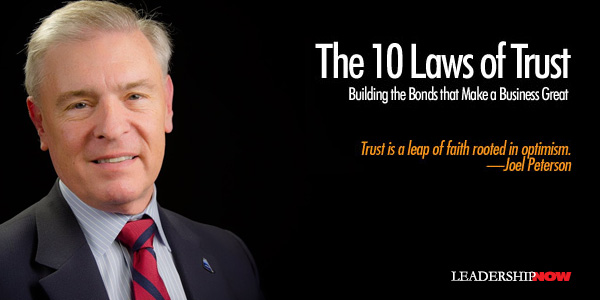
IN The 10 Laws of Trust, JetBlue Chairman and Stanford Professor Joel Peterson begins by reminding us that “when it comes to building great companies, a leader’s job isn’t to make it to the top of the mountain alone. Instead, the task is to help others reach peaks they want to climb but might not be able to without the help of the leader.” That leaves no room for distrust. “Trust is a leap of faith rooted in optimism.” It means giving away some control. Trust levels differ from organization to organization. While trust levels are not fixed, ‘what tends to motivate people within any organization tells you what level of trust you might realistically hope for.” So low-trust organizations rely on fear and high-trust organizations are motivated by duty and love. 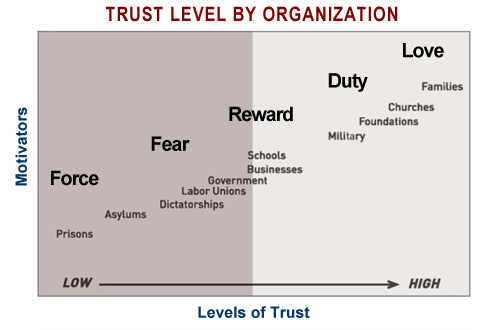 The goal of a leader is to move their organization to the high-trust duty and love end of the spectrum. Peterson offers 10 steps how to establish and maintain a culture of trust: 1. Start with personal integrity.
2. Invest in respect.
3. Empower others.
4. Measure what you want to achieve.
5. Create a common dream.
6. Keep everyone informed.
7. Embrace respectful conflict.
8. Show humility.
9. Strive for win-win negotiations.
10. Proceed with care.
Building or rebuilding a high-trust culture is a “patient, one-person-at-a-time, conversation-by-conversation process.” And forgive. 
Posted by Michael McKinney at 12:40 AM
10.21.15

Collaboration Begins with You
IN Collaboration Begins with You, Ken Blanchard, Jane Ripley and Eunice Carew weave the tale of Dave Oakton, the head of a cross-departmental project that fails due to self-serving silos. What’s more, the company offers “no incentives that encourage people to work together toward organizational goals. Managers get promotions and bonuses based on their own individual success and the success of their siloed groups—regardless of the success of the projects they work on or the company as a while.” Oakton, with the help of his sister-in-law Beattie, turns the tide and the culture changes. Along the way he learns that giving up his own ego first is a prerequisite to others giving up theirs. Beattie shows him a model for a collaborative culture: Heart, Head, and Hands. She explains that heart comes first because collaboration is an inside-out mindset. If your heart isn’t right, you’ll never be a place where you can make collaboration with others work. You have to get you right first. “When your heart is right, you want to bring out the best in others.” The UNITE acronym helps to remember the components necessary for the implementation of the Heart, Head, and Hands model.
To team members, they advise that they are the one’s responsible for ensuring their opinion is heard. “If collaboration begins with me, it’s up to me to make my intention clear that I want to contribute more.” Organizationally, if collaboration begins with each individual, “the only people who should be promoted to leadership positions are those who allow others to contribute.” Empowerment too begins with the individual. “In a culture of collaboration, individual contributors see themselves as self leaders. Leaders empower these individuals by building trust and coaching competence in their job roles and networking skills. And individuals also empower and inspire each other when they share ideas and deliver on their allotted tasks or goals. A collaborative leader is a coach supporting people in their work and removing roadblocks. Collaboration Begins with You also contains a self-assessment to help you find out just how collaborative you are. 
 
Posted by Michael McKinney at 12:54 PM
10.12.15

Extreme Ownership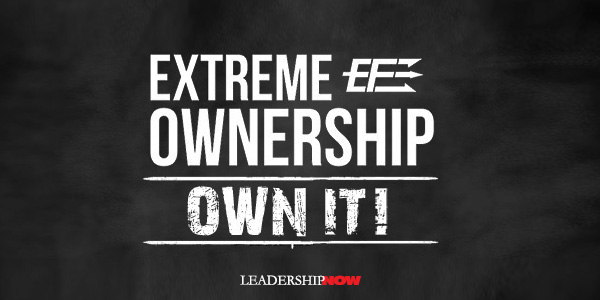 Extreme Ownership by Navy SEAL officers Jocko Willink and Leif Babin is about leadership as personal responsibility. “Leaders must own everything in their world. There is no one else to blame.”
Extreme Ownership by Navy SEAL officers Jocko Willink and Leif Babin is about leadership as personal responsibility. “Leaders must own everything in their world. There is no one else to blame.”
Willink and Babin bring up some of the critical problems that result from not taking responsibility. Too often we as leaders intend to do the right things, want the organization to do the right things, but do not take the steps necessary to make sure that learning happens and standards of conduct are enforced. When thing do not go as expected a leader must stop and do a “stern self-assessment of how you lead and what you can do better” if you want outcome to be different next time. Too often we skip this step, especially when the incident blows by with little or no consequence. When it comes to what we want from our leaders throughout the organization, “it’s not what you preach, it’s what you tolerate. When setting expectations, no matter what has been said or written, if substandard performance is accepted and no one is held accountable—if there are no consequences—the poor performance becomes the new standard.” This is why we see little change in leadership and organizational culture. “Leadership isn’t one person leading a team. It’s a group of leaders working together, up and down the chain of command, to lead.” It’s critical that everyone is on the same page. Everyone must believe in the mission. If you don’t understand the mission, it is your responsibility to ask questions until you understand how and why the decisions being made are made. Ego is always in the background ready to disrupt anything. “Most of the disruptive issues that arise within any team can be attributed directly to a problem with ego.” What is interesting is when we don’t want to take any responsibility—when preserving our rightness is most important to us—we block others from seeing their responsibility. Instead of a learning experience we create a clash of egos. They write, “If you approached it as he did something wrong, and he needs to fix something, and he is at fault, it becomes a clash of egos and you two will be at odds. That’s human nature. But, if you put your own ego in check, meaning you take the blame, that will allow him to actually see the problem without his vision clouded by ego.” By asserting our rightness we block others from being able to see their responsibility. Willink and Babin provide combat examples and apply them to business situations. “Combat is reflective of life, only amplified and intensified.” They cover four critical concepts that enable a team to perform at the highest level: Cover and Move (to move as one), Simple (keep plans and communications simple), Prioritize and Execute (avoid target fixation on a single issue), and Decentralized Command (leaders at all levels must be empowered to make decisions). Finally they cover Sustaining Victory. Here are some thoughts from that section: One of the most important jobs of any leader is to support your own boss—you immediate leadership. Leaders in any chain of command will not always agree. But at the end of the day, one the debate on a particular course of action is over and the boss has made a decision—even if that decision is one you argued against—you must execute the plan as if it were your own. And this key point: A leader must lead but also be ready to follow. Extreme Ownership is inspiring in many ways but more importantly, it tackles accountability for one’s own actions that is not stressed enough in leadership. We all know but we don’t always do. And when we don’t we need to look at our own contribution. 
Posted by Michael McKinney at 11:19 PM
09.04.15

Missing Ingredients: Finding the Right Team Recipe
IN my 25 years of professional endeavors, the lessons I apply the most often…the tools I use to achieve success . . . the skills I call on every day . . . all of these things I experienced and developed to one degree or another through sports. And when the discussion is about team sports, coaching, leadership, chemistry, relationships, role players, and all-stars become a natural part of the conversation. I find that the same is true in my business experiences and my work with civic organizations, where the natural question is why some teams perform better than others, and how to improve the performance of those that are struggling. There are a number of ways to look at this challenge, but to me, it usually comes down to three important things:1. Same Page of the Playbook: There are many reasons why a team may be struggling, but the first place to look is the source of any activity: everyone has to agree on the foundation before you put up the house. This is true in business, true in civics, and true in life. In my new book Xbox Revisited, I chronicle the challenges we faced during the formation of the Xbox business. The cold, hard truth is that we failed to establish a strategic foundation for the business, and as a result, the team was dysfunctional, our execution was inconsistent, and the business lost north of $5 billion over 4 years. We subsequently backfilled that mistake with a 3-page document that defined the Purpose, Principles, and Priorities for our second product, Xbox 360. This 3P Framework strategy process is chronicled in Xbox Revisited, and I now use it in my consulting, board work, and civic engagements. It forced the Xbox team to define a single Purpose, a joint set of operating Principles, and a focused list of Priorities that we used consistently to drive the business to market share leadership and substantial profitability for Microsoft. 2. Managers, Coaches, and Captains: Even with the greatest strategy, teams can still flounder without the right leadership. In fact, many of our early struggles on Xbox were a function of my leadership as Chief Xbox Officer – although I had many of the right instincts, I was simply too inexperienced to deal with the type and level of issues we faced on Xbox. Great leaders have to be self-aware of their own strengths (what I call super-powers) and weaknesses (kryptonite) and build a team around them that fills in identified gaps. The next level of leadership has to understand their roles and responsibilities well and translate that down through the team, consistent with the strategy framework that is driving the business. Just as with any sports team, there is no "correct" structure for a group – but everyone must know, accept, and perform their roles effectively if the team hopes to be successful. Great leaders identify weak team members or those that have not bought into the strategy/their role and either help them improve quickly or replace them. This is difficult work – both because it takes great judgment to know when to "hold 'em" and when to "fold 'em", and because the process of firing and replacing someone is emotionally challenging if you are a caring manager. And yet, the fact remains that there is quite often "addition by subtraction" and no team is much better than its weakest link. 3. Executing the Game Plan: A strong strategy framework with good team leadership is enough to get you to the starting line – but game-time performance is entirely a different matter. There are many teams that look good on paper but can't actually perform to expectations. Great communication is certainly a central element in establishing an operating rhythm that drives day-to-day excellence because once the game begins, modifications and adjustments are a constant requirement. This is the football equivalent of an audible called by the quarterback at the line of scrimmage. If everyone on the field doesn't hear that the play has changed, the whole effort falls apart. Great execution is also about efficient and effective decision-making up and down the ladder of the team. If decisions can be pushed down into the organization where people closest to the issues can make the quickest and best decisions, the team has a much higher likelihood of success. In contrast, if everything must flow up the chain and back down again, as it often did in our early Xbox days, the likely result is either poor, uninformed choices or decision constipation. Finally, winning on the field is about continuous improvement. Teams that struggle at first can ultimately be successful if they keep making mid-course adjustments – changes in people, process, decisions, etc. Most projects are marathons not sprints and the secret to success is finishing strong and fast. This sporting analogy and the discussion of teams applies across a broad cross-section of organizations. The dynamics and culture of a business are certainly different than what you might find in a government agency, a community organization, or a non-profit. But the elements that make a great team and create an environment for success are similar in all of these cases. So whether your goal is renewing your business or joining me as a Civic Engineer trying to improve our local, state, and national civic organizations, building the right team is a critical element to success.  
Posted by Michael McKinney at 04:44 PM
07.10.15

Are You Running at Full Power?
ONLY about 10% of us are running at full power! Power Score is designed to help you determine why you might not be performing at your best.Your Power Score (P x W x R) is based on three questions you should be asking yourself and your team: Do we have the right priorities?
“The key to great leadership is to have the right priorities, the right people on your team, and the right relationships that achieve results.” Interestingly, their research found that where most leaders were weakest related to the who and then priorities. The relationship factor was the strongest factor by far. To score high on the Priorities factor, the priorities connect with the mission (the why), they are the right ones (will they get you what you want), and they are clear (focused).
To score high on the Relationships factor means building relationship that function well together and achieve results. Is communication coordinated within and beyond the team? (Communicating with the right people at the right times.) Is our team committed to the mission and to one another? (Emotionally invested in their work.) Does our team feel challenged to accomplish something bigger than themselves? (Feedback and mutual accountability. A challenged team will remain a committed one.) The book provides a questionnaire to help you and your team determine your own power score. You will also find instructions to have a follow-up power conversation. By having a power conversation with your team and rating each of these areas you can discover areas where you can improve and increase your power score.  Of Related Interest: 
Posted by Michael McKinney at 08:49 AM
03.17.14

How to Avoid One-Dimensional Thinking What undermines far too many leaders is that they don’t want feedback; they don’t like to be or feel they should be questioned. Unfortunately, this position takes them out of “leading” and into their own heads. They become focused on their own one-dimensional thoughts and agenda. What undermines far too many leaders is that they don’t want feedback; they don’t like to be or feel they should be questioned. Unfortunately, this position takes them out of “leading” and into their own heads. They become focused on their own one-dimensional thoughts and agenda.
As human beings, we easily deceive ourselves in ways that are completely unknown to us. To lead well we must encourage feedback. In The Moment of Clarity, authors Christian Madsbjerg and Mikkel Rasmussen state, “As a leader you cannot be sure that you are always making the right interpretations or know the right path.” They recommend creating a “brain trust” of advisors that in include the following three kinds of people:
Posted by Michael McKinney at 10:33 PM
03.11.14

Lessons on Team Performance from Elite U.S. Military Units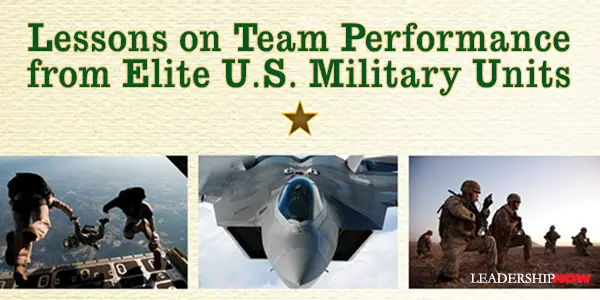
JAMES MURPHY says American business has an execution problem. Why? Because we make things complex. “Complexity is the mortal enemy of good execution.” We tend to combat complexity with even more complexity. Simplicity is the SEALs answer to a complex world. In Courage to Execute, Murphy walks us through a simple process used by America’s elite military units that will improve an organization’s ability to execute and achieve goals. “Their courage, confidence, and capabilities stem from a relentless, time-proven process of conditioning, training, planning, executing, and improving.”Soldiers morph into Rangers—individuals into teams—when they get a sense of who they are and what they’re a part of. “Together, the army’s core values and the Ranger Creed create a unique organizational identity that breeds unit and trust. This is the glue that holds everything together.” Successful organizations are able to focus and execute according to purpose. “Principles are like cardinal rules so important to your organization that they should never be broken. They are things you always do or never do. They are your guardrails.” To align everyone in your organization create and pursue a common high definition destination. “Think exclusively in high definition and create a specific, detailed, granular, crystal-clear picture of what you’ll look like and how you’ll be operating when your organization reaches its intended future destination.” Keep in mind, “General ideas lead to general execution, and that gets sloppy.” When you plan your “mission” ask, is it clear? Is it measurable? Is it achievable? Does it align with your high definition destination? Every plan should be run by a red-team. “Red teams play the role of adversary.” They “identify potential risks, holes, or contingencies that the original group may have overlooked.” Once you begin to execute, “never let yourself or your team lose sight of where you are relative to your objective and your threats.” Utilize checklists and cross-checks to help avoid task saturation. The moment you have too much to do or resources to do it, you lose focus on the most important thing. “When people become task saturated, they either quit, compartmentalize, or channel. In each case, their performance deteriorates rapidly. Quitters stop working or stop being productive. Those who compartmentalize appear busy but focus on tasks that accomplish little. Most of us, however, channel our focus onto one thing and ignore the rest. None of these behaviors lead to a good outcome.” Murphy says debriefing is the essence of teamwork. “Organizations that don’t debrief often equate failure with retribution or negative consequences.” (And often for good reason.) But it is an opportunity to improve and to see if something systemic might have caused the problem. Murphy advocates the STEALTH debrief: Set the time, Tone, Execution versus objectives, Analyze execution, Lessons learned, Transfer lessons learned, and end on a High note. 
Posted by Michael McKinney at 09:30 PM
10.30.13

The 8 Elements that Bring People Together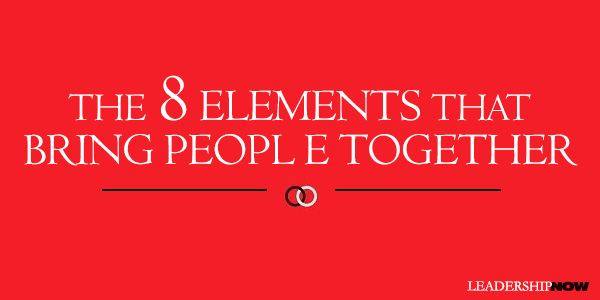
WORKING together to solve a common problem provides us with a more complete picture of the problem, and can offer us more options, synergies, and solutions than we could achieve by working alone. Many of the issues we face will require collaboration at some level to solve or even manage them. In Finding Allies, Building Alliances, authors Mike Leavitt and Rich McKeown, state, “The ability to get things done with collaborative networks is the next generation in human productivity.” We need to be able to form and work with and through value alliances. Value alliances are “a group of participants with aligned interests in pursuing an outcome with value for each of them.” These alliances can last long enough to solve the issue they came together to solve or they can be ongoing as an alliance enterprise to oversee the solution to the problem. But value alliances are not always easy. “Value alliances require that participants subordinate their egos, their agendas, their preferred styles, and their biases—not to mention their organizational agendas—in favor of a shared benefit.” Some people just don’t have the aptitude—the collaborative intelligence, if you will—to work well with others. “People with high collaborative intelligence make an effort to understand the views and needs of others; they listen honestly, thoughtfully, and objectively. They don’t lock into positions prematurely. While they may possess strong points of view, they make an effort to hear other perspectives and will adjust their points of view once convinced they need adjusting.” The authors have had a lot of experience creating, working with, and successfully resolving problems through effective value alliances. They share the good and the bad and the lessons learned along the way. They answer why you form value alliances, the eight key elements required for a collaborative effort to succeed, how you select productive participants, and how you deal with the inevitable issues that come up dealing with other people. Their case is well thought out and clearly presented. From their experience, they have discovered why some collaborative efforts have failed and why others have succeeded. From that background, they detail the 8 elements required for a collaborative network to succeed: 1. A Common Pain is a shared problem that motivates different people/groups to work together in ways that could otherwise seem counterintuitive. Value alliances “exist at the intersection of self-interest and common interest.” We often become collaborators when we discover that we can solve a problem on our own. “Few people are willing to place themselves in a collaborative position of they have an alternative.” (As a side note, leaders, because of their position and the authority it brings them, usually have an alternative—my way or the highway. The best leaders collaborate anyway.) Collaborations require time, money, and people. The collaborative process is more complex, slower, and messier than independent decision-making. To be willing to give up a degree of independence and control, a given leader must believe the problem poses a serious threat to the enterprise. 2. A Convener of Stature is a respected and influential presence who can bring people to the table and, when necessary, keep them there. “The inability to turn down an offer is one sign that you’re dealing with a convener of stature.” The book lays out the roles and responsibilities of the convener. 3. Representatives of Substance. The collaborative participants must bring the right mix of experience and expertise for legitimacy and have the authority to make decisions. Look for participants who possess at least one and ideally all three varieties of substance: authoritative, cognitive, and reputational. Sometimes it is wise to create additional layers of participants beyond the primary or core group. “Omitting people from the collaboration often guarantees that they’ll become external critics or even saboteurs.” 4. Committed Leaders are individuals who possess the skill, creativity, dedication, and tenacity to move an alliance forward even when it hits the inevitable rough patches. Value alliances require committed leaders who fulfill many of these ten roles: organizer, diplomat, technician, teacher, counselor, matchmaker, salesperson, referee, judge, and disciplinarian. “If committed leaders can consistently achieve consensus, they will move the alliance forward. Finding consensus is an art form that alliance leaders must master.” 5. A Clearly Defined Purpose is a driving idea that keeps people on task rather than being sidetracked by complexity, ambiguity, and other distractions. It is important to identify and deal with purpose creep—“an inexorable broadening of scope that eventually makes it impossible to relieve the common pain that drew the group together in the first place.” The authors provide a step-by-step guide to creating a purpose in a collaborative setting. They advise, “Find a golden mean: big enough to matter and small enough to do.” And add, “As a committed leader, you need to develop a sixth sense for when people are setting goals that are too difficult to achieve or too wide-ranging; you also need to grasp when you’ve shrunk the purpose to the point that its achievement won’t have any real impact.” 6. A Formal Charter establishes rules that help resolve differences and avoid stalemates. The three crucial parts of a charter are: the Purpose section, the Principles section, and the Operating Procedures. 7. The Northbound Train is an intuitive confidence that an alliance will get to its destination, achieve something of unique value, and that those who aren’t on board will be disadvantaged. The idea is, “decisions that matter to me are going to be made, and I need to be there. The train is headed north, and I want a seat on it.” They explain why a northbound train slows and what to do about it. “The feeling generated by a northbound train is what carries the collaboration to its destination.” 8. Defining Common Ground. “Participants and leaders need to discuss the beliefs and ideas that they take for granted in their collaborative efforts.” A Common Information Base keeps everyone in the loop and avoids divisive secrets and opaqueness. “Defining common standards boils down to the capacity of collaborators to reach foundational agreements.” People are coming from all different places with different values and beliefs, but to get to the point where there is a recommendation or decision that everyone can buy into and to hold the collaboration together until that point is reached, “Agreement about operating modes and information protocols is necessary.”

Posted by Michael McKinney at 12:43 AM
09.23.13

8 Ways to Have a Successful Partnership
I N A MARKETPLACE gone global, productive partnerships are more crucial than ever. Partnering has become so critical that the word "coopetition" had to be coined to describe companies that partner in some areas while competing in others. Yet very few partnerships ever deliver on their symbiotic promise. Why? The single biggest mistake we make in our partnership efforts is treating potential partners as if they were end users. While the interests of partners and end-users must overlap they are seldom if ever identical. Through many years of business experience, I learned some great lessons on what it takes to produce a successful partnership.
 
Posted by Michael McKinney at 10:41 PM
06.20.13

Phil Jackson's 11 Principle's of Mindful Leadership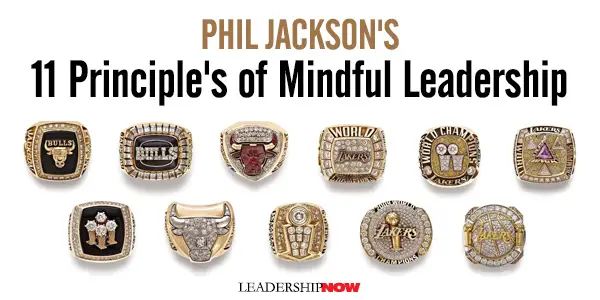
PHIL JACKSON, considered one of the greatest coaches in the history of the National Basketball Association, has won 11 titles as a coach. The most in NBA history. Eleven Rings is a memoir that, for me, is more about leadership and relationships than basketball. Jackson's principles are worth taking a look at. They support the idea that a leader's job is to build leaders at all levels. You could take back to your organization and put into practice today any one of the following 11 principles:1. Lead From the Inside Out. Avoid fads. Lead from who you are. "As time went by, I discovered that the more I spoke from the heart, the more players could hear me and benefit from what I gleaned." 2. Bench the Ego. "The more I tried to exert power directly, the less powerful I became. I learned to dial back my ego and distribute power as widely as possible without surrendering final authority. Paradoxically, this approach strengthened my effectiveness because it freed me to focus on my job as keeper of the team's vision. "Some coaches insist on having the last word, but I always tried to foster an environment in which everyone played a leadership role, from the most unschooled rookie to the veteran superstar. If your primary objective is to bring the team into a state of harmony and oneness, it doesn't make sense for you to rigidly impose your authority." 3. Let Each Player Discover His Own Destiny. Jackson's goal wasn't to provide all of the answers. "I've always been interested in getting players to think for themselves so that they can make difficult decisions in the heat of battle." "My approach was always to relate to each player as a whole person, not just a cog in the basketball machine. That meant pushing him to discover what distinct qualities he could bring to the game beyond taking shots and making passes. How much courage did he have? Or resilience? What about character under fire? Many players I've coached didn't look special on paper, but in the process of creating a role for themselves they grew into formidable champions." 4. The Road to Freedom is a Beautiful System. Similar to the principles used to foster greater creativity and innovation in an organization, Jackson used a system known as the triangle offense. "What attracted me to the triangle was the way it empowers the players, offering each one a vital role to play as well as a high level of creativity within a clear, well-defined structure." 5. Turn the Mundane into the Sacred. Leaders take note. Jackson writes, "As I see it, my job as coach was to make something meaningful out of one of the most mundane activities on the planet: Playing pro basketball." He incorporated meditation into his team's practices. "I wanted to give players something besides X's and O's to focus on. What's more, we often invented rituals of our own to infuse practices with a sense of the sacred." 6. One Breath = One Mind. Players "often have to make split-second decisions under enormous pressure. I discovered that when I had the players sit in silence, breathing together in sync, it helped align them on a nonverbal level far more effectively than words. One breath equals one mind." "If you place too many restrictions on players, they'll spend an inordinate amount of time trying to buck the system. Like all of us, they need a certain degree of structure in their lives, but they also require enough latitude to express themselves creatively." 7. The Key to Success is Compassion. "Now, 'compassion' is not a word often bandied about in locker rooms. But I've found that a few kind, thoughtful words can have a strong transformative effect on relationships, even with the toughest men in the room." Compassion breaks down barriers among people. 8. Keep Your Eye on the Spirit, Not on the Scoreboard. When a player is "playing within his natural abilities, he activates a higher potential for the team that transcends his own limitations and helps his teammates transcend theirs. When this happens, the whole begins to add up to more than the sum of its parts." He adds, "Most coaches get tied up in knots worrying about tactics, but I preferred to focus my attention on whether the players were moving together in a spirited way." 9. Sometimes You Have to Pull Out the Big Stick. Sometimes Jackson used "tricks to wake players up and raise their level of consciousness….Not because I want to make their lives miserable but because I want to prepare them for the inevitable chaos that occurs the minute they step onto a basketball court." 10. When in Doubt, Do Nothing. "Basketball is an action sport, and most people involved in it are high-energy individuals who love to do something—anything—to solve problems. However, there are occasions when the best solution is to do absolutely nothing….I subscribe to the philosophy of the late Satchel Paige, who said, 'Sometimes I sits and thinks, and sometimes I just sits.'" 11. Forget the Ring. We all hate losing. "And yet as coach, I know that being fixated on winning (or more likely, not losing) is counterproductive, especially when it causes you to lose control of your emotions. What's more, obsessing about winning is a loser's game: The most we can hope for is to create the best possible conditions for success, then let go of the outcome." Jackson concludes with: "What matters most is playing the game the right way and having the courage to grow, as human beings as well as basketball players. When you do that, the ring takes care of itself." 
Posted by Michael McKinney at 10:33 AM
02.20.13

Into the Storm: Lessons in Teamwork from the Treacherous Sydney to Hobart Ocean Race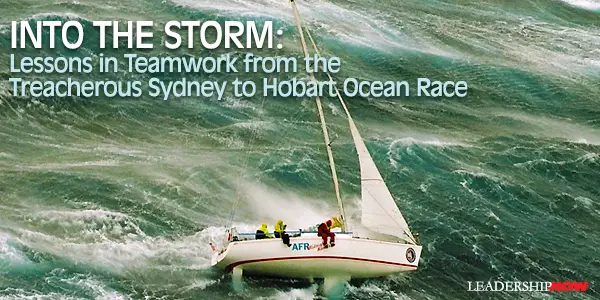
The iconic Sydney to Hobart Race, a 723-mile deepwater challenge—often called the "Everest" of offshore ocean racing—is considered one of the toughest in the world. Unpredictable weather and seas make each race demanding, but in 1998, an unexpected "weather bomb" hit the fleet, creating 80-foot waves and 100-mile-per-hour winds. Many bigger, better-equipped boats tried to maneuver around the storm, but the crew of the AFR Midnight Rambler chose to head directly into its path. After battling mountainous waves and hurricane-force winds in the Bass Strait, the tiny 35-foot boat arrived safely in Hobart, 3 days and 16 hours later—winning the coveted Tattersall’s Cup. THERE are two central themes in Into the Storm. The first is the importance of exceptional teamwork in overcoming challenges at The Edge. The second is the value of distributed leadership—a team culture that allows every person to provide direction when he or she has expertise that will help the team succeed. The story of the AFR Midnight Rambler exemplifies the power of exceptional teamwork and distributed leadership. But where does this leave a formal team leader—the skipper of a boat, the CEO of a corporation, the commanding officer of a military unit, or the President of the United States, for that matter? Is there a unique role that he or she needs to play? I believe there are some critical things—some unique responsibilities—that fall to the skipper. The leader needs to keep the team aligned. The varied performance of boats in the Sydney to Hobart Race underscores the importance of having a coherent, unified team. Some boats, like the Midnight Rambler, demonstrated extraordinary cohesiveness even under the most terrifying, life-threatening conditions. At the other end of the alignment continuum, some crews were fragmented, with key team members at odds with each other—in a leadership vacuum. Adrienne Cahalan, one of the world's best navigators, has had a chance to observe the role of the leader in more than twenty-five years as a professional competitive sailor. She has been named Australian Yachtswoman of the Year twice—and has been nominated four times for World Yachtswoman of the Year. Cahalan characterized the leader's role this way: "Skippers need to keep the team focused. They need to keep an eye out to see if someone is wavering, or a faction developing. They need to have the skill to manage all the personalities, to bring them together, and to get them working toward their common goal. Not everybody's perfect, so a good leader is able to deal with imperfections. And they need to be able to do it all under pressure." Managing personalities and bringing people together can be challenging in any situation. But the pressure of a storm—or a tough business obstacle—calls for exceptional leadership. The leader needs to demonstrate passion. The leader's passion is a magnetic force that pulls other people in. Describing the impact of Ed's enthusiasm, one crewmember observed: "What makes Ed an exceptional leader is his desire to win. He is committed to driving the boat as fast as it can go. And he can take risks because of his comfort and trust in the team." No one who has ever sailed with Ed Psaltis has any doubt about his absolute, total commitment to winning. He is so passionate that his excitement sometimes needs to be offset -- by humor, or by the composure of others. But there is no mistaking the electric spark that comes from a leader who is excited to win. That enthusiasm is contagious, and it is a contagion that leads to victory. The leader needs to instill optimism and confidence that the team will succeed. Ed Psaltis and navigator Bob Thomas have a close relationship. They have complementary personalities, with Bob's cool demeanor balancing Ed's passion. Both Ed and Bob joined forces during the storm, and their combined leadership provided a reassuring presence for the crew. Crew member "Mix" Bencsik recalls: "Their leadership played a large part in making sure that no one gave up. Ed and Bob constantly instilled optimism and confidence that we could handle the conditions, and that the crew had the ability to win." While there was no question about Ed's formal role as skipper, Ed and Bob together reinforced a sense of unified leadership. And because of their close personal relationship, they were able to send a joint message of reassurance and optimism. The leader needs to set an example. Ed realizes that people are watching him, and he makes a conscious effort to set an example. Coming off his watch as helmsman, Ed will take a forward position on the rail. In this exposed position, he is subjected to the first onslaught of water and spray. It is cold and uncomfortable, but it is clear that Ed is not afraid to do his share. Ed will also take his turn in "the bad bunk." It seems that every boat comes equipped with a berth that—for one reason or another—is undesirable. Nobody wants the bad bunk, but Ed makes sure that he takes his turn. He is sending a message. Leaders need to set an example on a daily basis, but there are some moments that are different. There are times when leaders need to inspire others through fortitude, courage, and skill. One such moment came for Ed Psaltis in the 1998 Sydney to Hobart Race. Mix Bencsik reflected: "I've been through a lot of storms with Ed. Sitting on the side of the boat—wave spotting while he was helming -- was something that made me feel really proud. I thought, Here's a person who has my life completely in his hands. He was performing extraordinary feats of strength and seamanship, holding a 35-foot boat on the right course in those conditions." "Ed was giving more than 110 percent. The well-being of the boat and crew were in his hands, and he didn't falter. It was an outstanding feat of seamanship. Even to this day, it's quite emotional to talk about. That was his finest moment." Not every leader has the ability to steer a boat through a storm like Ed Psaltis. But there comes a time when every leader needs to be willing to step up and give "more than 110 percent." For every leader, there can be a finest moment.  
Posted by Michael McKinney at 10:44 PM
11.26.12

The Four Leadership Traits of Highly Collaborative Leaders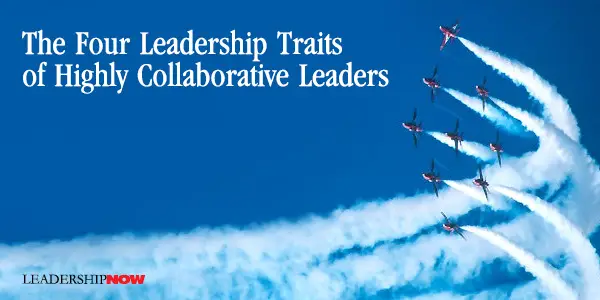
COLLABORATION taps in to a broader pool of ideas. It maximizes the talents and abilities of your people. An inclusive culture is more flexible and adaptable. People are highly motivated, work harder and are more creative. However, collaboration isn’t something you can put on. For it to work you have to believe in it. You can’t order it. Collaboration begins at the top. If leaders model it, others will too. Collaboration isn’t technique. It’s culture. If a leader believes that everything rises and falls on their talent and ability, and resources are for their sole use, collaboration is DOA. Moreover, it severely limits the organization. Ron Ricci and Carl Wiese report in The Collaboration Imperative, that there are four leadership traits of highly collaborative leaders:

Posted by Michael McKinney at 07:43 AM
11.15.12

Resilience: How We Can Learn to Bounce Forward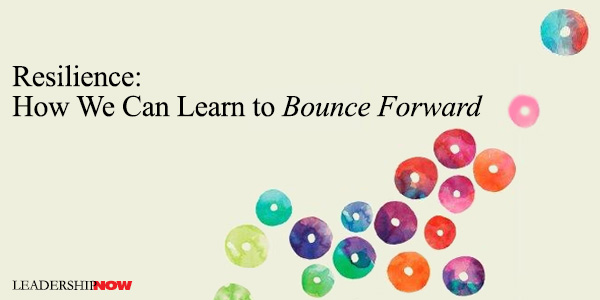
ALL OF US will be tested from time to time on our ability to adapt—on our resilience. The goal of resiliency is not necessarily to bounce back, but to bounce forward. It is the ability to maintain your purpose even while adapting your methods. “If we cannot control the volatile tides of change, we can at least learn to build better boats,” write Andrew Zolli and Ann Marie Healy in Resilience. “We can design—and redesign—organizations, institutions, and systems to better absorb disruption, operate under a wider variety of conditions, and shift more fluidly from one circumstance to the next.” Resilience-thinking is not the same thing as being in a defensive mode. It’s engaging the world in a different way. They discuss tight feedback loops, dynamic reorganization, built-in countermechanisms, decoupling, diversity, modularity, simplicity, swarming, and clustering, as proactive ways to encourage resilience. They don’t give check-lists or quick fixes (indeed, there are none) so you’ll have to think about the ideas they offer. Most of the ideas are quite useful in principle on a personal level. TRANSLATIONAL LEADERS Interestingly—but not surprising—they found that resilient communities had a special type of leader: a translational leader. “These leaders demonstrated an uncanny ability to knit together different constituencies and institutions—brokering relationships and transactions across different levels of political, economic, and social organization.” They were leading from the middle out. Translational leaders do not dispense with hierarchies; they recognize and respect their power. Instead, standing at the intersection of many constituencies, translational leaders knit together social networks that complement hierarchical power structures. Rooted in a spirit of respect and inclusion, these complementary connections ensure that when disruption strikes, all parts of the social system are invested, linked, and can talk to one another. It sounds like they have a high degree of emotional intelligence or ego-control. That necessitates a leader that is reflective and operates from strength rather than weakness; a grounded mindful leader. ADHOCRACY Many of the lessons learned from the disruptions discussed in the book boil down to adhocracy, say the authors. Adhocracy is adaptive, creative, flexible, and non-permanent organizational style. “In the digital age, an adhocracy can be put together in a plug-and-play, Lego-like way, well suited in fast-moving, fluid circumstances where you don’t know what you’ll need next. If it were a musical genre, adhocracy would be jazz.” (Robert Waterman on Adhocracy.) They caution: “When systems are structurally overconnected … or when interventions are bureaucratically imposed on communities rather than developed with them, there is no space for adhocracy to germinate.” Of course formal organizations have a role to play. “But when we focus too strongly on them as the sole actors in response to a disruption, we don’t just ignore, but can actually smother the opportunities for these kinds of successful, improvisational approaches to emerge.” 
Posted by Michael McKinney at 12:22 PM
08.28.12

There is an I in Team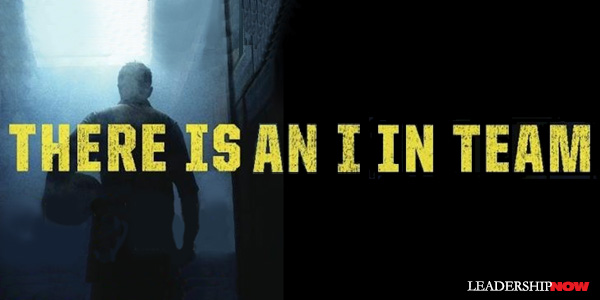
THE often repeated phrase, “There’s no ‘I’ in TEAM” is only half true. It ignores the fact that great teams have great individual members. And high performing teams are not always easy places to be. Mark de Rond acknowledges in There Is an I in Team, that “with few exceptions, the qualities that make individuals as gifted as they are can make them wearisome as team members.” Great team members are often perfectionists, paranoid, stubborn and/or self-confident. But they do perform. “Team leadership is as much about mitigating the risks of these traits as it is about exploiting their potential.” David Whitaker, one of Britain’s most distinguished coaches wrote in The Spirit of Teams, “If you want an exceptional team, keep your eye on the individual … Teams thrive on individual choice and commitment … the most powerful teams are made up of individuals who have chosen to work as a team.” Using fresh examples, de Rond tackles other realities of teams: On high performance teams, everyone is not equal. Star performers increase a team’s overall effectiveness but only to a point. If the proportion of stars versus average members exceeds much beyond about 50%, you begin to experience diminishing returns. Of course, emotional intelligence plays a part. De Rond reports that “if someone is strongly disliked, it is almost irrelevant whether or not he is competent. By contrast, if someone is liked, her colleagues will seek out every bit of competence she has to offer, meaning that a little likeability has far more mileage than competence in making someone a desirable team member.” Without internal competition, teams may underperform. Too much harmony can hurt team performance. “A healthy level of internal competition can help get the best out of high performers.” Citing Timothy Gallwey, De Rond explains, “each player tries his hardest to defeat the other, yet not for the sake of beating another player, but merely to overcome the obstacle he now presents.” Interestingly, one study de Rond offers, finds that often team members value charitable individuals much less than we might expect. After a team activity, members were asked which people they would eliminate. Not surprisingly, the selfish people were unpopular, but so were the most selfless. One explanation was that “seeing others take less than their fair share made them feel bad, and that the only way to rescue their own reputations was to eliminate the martyr. Virtue had become a vice.” While we want everyone to be on the same page, people have different versions of reality. Whether or not they are correct is less relevant than what their realities tell you about their priorities. “At the root of much team conflict is disagreement on why things are as they are and not otherwise, which too easily escalates as colleagues begin to question each other’s motives. To recognize explanations for what they are—a visceral reminder of what matters to people personally—is often a good first step to calming the waters.” De Rond also deals with social loafing or why productivity tumbles with size. An interesting series of studies show that productivity and team size is less an issue of coordination and more a problem of contribution. Team members are “more likely to optimize their performance when faced with slightly fewer members than the task at hand requires.” Management consultant Kal Bishop found that with creative teams in particular, larger teams were inclined to seek consensus rather than explore novel ideas. Understanding and managing our humanity is key to leading teams. De Rond concludes: “Team leaders may choose to increase their reliance on sophisticated technological gadgets to up performance but will only ever be effective when they use these tools to unlock that basic, shared humanity. And, then, not by dispensing solutions, but by knowing what questions to ask and when.”

Posted by Michael McKinney at 10:22 AM
08.08.12

Leadership by Choice LEADERSHIP is always a choice. In Leadership by Choice, author Eric Papp says it means “making a conscious choice to positively influence those around you by managing yourself and leading others in four areas: communication, leading teams, productivity, and personal development.”
LEADERSHIP is always a choice. In Leadership by Choice, author Eric Papp says it means “making a conscious choice to positively influence those around you by managing yourself and leading others in four areas: communication, leading teams, productivity, and personal development.”
Communication — How well do you listen, ask questions, and speak with influence? How many of our problems are caused by a lack of listening? We listen better to people we like, but we can learn to listen with liking to anyone. What prevents us from doing so is preconceived ideas and ideas that we have about someone. “Sometimes while listening to someone, thoughts flood your mind – “can this person do anything for me?” “I probably won’t like this person,” or “Who likes them anyway?” – influencing how you listen.” Listen with liking. Leading Teams – How well do you establish trust, healthy conflict, and achieve results with others? A culture of blame teaches people that they can avert their own responsibility by blaming others. “When you breed and teach a culture of no accountability, it’s very hard to reach anything above mediocrity.” Without accountability you can’t lead. Papp suggests five ways to hold yourself accountable: 1. Don’t overextend yourself; 2. Take action before you speak. Actions speak louder than words; 3. Have an accountability partner; 4. Chart your progress. Write down daily or weekly actions that chart your continual growth; 5. Aim for consistency, not perfection. Productivity – How well do you spend your time and how focused are you? You are responsible for being productive. Know where your time is going, plan the day before, focus on high-payoff items, and delegate for results and not the process. (Forcing someone to do things your way is not delegating for results. It makes for a very stressful environment and is also counterproductive.) Personal Development – What are you doing to develop yourself? Where do leaders find their inspiration? “When we retreat to silence, we tap into the inner calm that allows us to search for answers.” Lead with silence. We must learn to deal with stress. Papp suggests that we enjoy silence, create a gratitude list, get your sleep and take naps, allow for mistakes, help someone (giving is a great stress reducer), and make a decision to enjoy life. 
Posted by Michael McKinney at 08:25 AM
07.18.12

How to Turn Your Team Around in Six Stages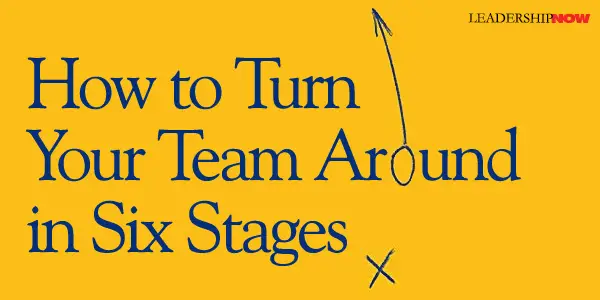
HOW DO YOU transform a losing climate into one that fosters collaboration, innovation, and productivity? Losing is not necessary or permanent, but to turn it around you need a leader who can see the truth, identify where things that have gone wrong, and broadcast the reality of possible in spite of what’s actually happening. A turnaround is really a change in culture—changing the culture of the team or organization.In Team Turnarounds, authors Joe Frontiera and Daniel Leidl present a six-stage Team Turnaround Process. While many of the examples are from sport franchises—Colts, Eagles, Steelers—and the people they interviewed there, they also include turnaround stories of Domino’s pizza, Spider-Man: Turn off the Dark Broadway show, and the state of Michigan. Each stage contains specific developmental milestones—principles that leaders and their teams typically master before proceeding to the next stage: Stage I: Leading Past Losing
The funny thing about truth is that people often want to embrace it. They may not want to hear it, but once it’s spoken, everyone’s shoulders drop in relief. Finally, someone has noticed that the organization has been skating by. Finally, someone is willing to confront the ugly reality. Finally, someone is putting the success of the group above everything else. What most often holds us back are the excuses we hold on to. Stage II: Committing to Growth
Stage III: Changing Behaviors
Stage IV: Embracing Adversity
Challenges are moments of growth—times for you to refine yourself, make yourself better, and believe with even more confidence that you’re on the right path. The resilience and the willingness to take on adversity that come with stage IV will prepare your team for the even larger challenges presented in stage V. Stage V: Achieving Success
We think of life, our efforts, our aspirations, as something like a movie, as if we work toward the one big goal, give everything we have to a single crowning achievement, and when it’s complete, the credits roll. We become so fixated on the effort to achieve that we sometimes lose sight of what we’re doing and how it relates to the bigger picture. We sometimes forget that there aren’t any credits, and that there’s no stop to the action after we hold up the trophy. Life keeps rolling even after our big wins. Stage VI: Nurturing a Culture of Excellence
When teams win, they can become complacent. Success feels good and builds confidence, but it can also breed sloppy habits, overconfidence, and eventual performance decline. The book concludes with the Team Turnaround Workbook. The exercises for each stage will help you and your team work through the Team Turnaround Process.

Posted by Michael McKinney at 11:10 PM
04.18.12

Master the PRIMES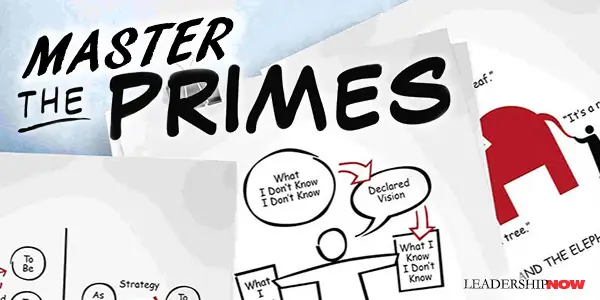
“Master the Primes and you can master leading groups,” says Chris McGoff. The Primes are 46 universal patterns of group behavior that show up every time people join up in groups to solve problems, drive change, and transform systems. Faced with the need for transformative change, a leader’s ability to form and sustain effective groups is critical. The Primes will help you to understand the reasons behind what is blocking the progress of your group. Each of the Primes that McGoff identifies challenges you to take a look at fundamental components of group dynamics by asking key questions. For example, the Change versus Transformation Prime asks, “Are you fixing or creating?” The distinction between fixing or creating is important and requires a different approach. What kind of problem are you trying to solve? Fixing is about making a better, faster, cheaper past. Fixing involves corporate improvement programs like Activity Based Costing, Six Sigma, and others.”These tools are effective when a better past is the desired outcome, but they’re dead weight in the business of transformation.” Creating is about transformation—imagination, declaration, invention, and innovation. The Trust the Universe Prime asks, “Is your vision limited to what you have already seen?” This Prime is a mindset that understands that we don’t know what we don’t know and whatever we need to realize is out there in the future somewhere. But…“Trust in the Universe is a myth. It’s a required myth, an essential myth for any true leader, but a myth just the same. Embracing this Prime is the only real way to create transformative possibilities.” Importantly, McGoff adds, “Leaders understand that although Trust in the Universe promises no guarantees, it gives us the ability to imagine without limit and watch what shows up.”
The Facts, Stories, and Beliefs Prime is the need to distinguish facts from stories from beliefs. There is one of each in the following sentences: “Our revenue was $50 million last year (FACT), and that is simply not enough (STORY). Marketing is inept (BELIEF).” One of the last Primes discussed is an increasingly difficult one: A Clearing. How skilled are you at creating nothing? A clearing in your schedule, your office or meeting place, or your mind: a space where possibilities can exist. The Primes leaves you with plenty to think about. Each concept is illustrated with “back-of-the-napkin” style illustrations and explained with tangible examples. The Primes will show you where you can grow as a leader. 
Posted by Michael McKinney at 11:03 PM
04.12.12

The Essential Member You Need on Your Team: The SynergistIn trying to understand the dynamics of team interactions, Les McKeown writes in The Synergist, that people tend to act primarily in one of three naturally occurring styles: the Visionary, the Operator or the Processor. (A free assessment is available online.)The Visionary thinks big, generates creative ideas, and takes risks. They also become irritated by detail and can disengage easily when bored. Operators get stuff done. They take the Visionary’s big idea and translate it into actionable tasks. They like to be left to work alone and will do whatever is necessary to complete the task they’re given, even if it means breaking a few rules. Processors devise and monitor the systems and procedures necessary to enable an organization or enterprise to deliver consistent results in a complex environment. They think linearly and objectively and are averse to undue risk. The problem is that as stand-alone approaches, they get in each other’s way because each achieve a sense of fulfillment or satisfaction in very different, often competing ways. Not surprisingly, teams (or any group of people trying to achieve something together) come to gridlock because, fundamentally, they have different motivations, different goals, and different perspectives. As a result, it’s just a matter of time until any group or team will implode, gridlock, or simply underperform. Since the point of a team is to “pool the knowledge, experience, and skills of each individual member in order that they may together produce high-quality decisions on behalf of the enterprises as a whole,” another style must be introduced. That style or role is that of the Synergist. The Synergist is not focused on their own way of doing things, but rather on what is best for the organization, team or group. This “helicopter view” gives them a better vantage point from which to interact with the team in a positive way. McKeown notes that “the Synergist is a style that anyone can emulate irrespective of their natural style. Any Visionary, Operator, or Processor can (and should) learn also to be a Synergist.” The Synergist style isn’t persistent and intervenes with the team only at key moments to resolve conflict, choreograph the other style’s interactions, harmonize their output, and move them effectively on to their next topic or project. McKeown’s explanation of each style is illuminating and might help explain why your team interacts the way it does and what can be done about it. In a chapter devoted to each he explains what the style is, how to work for one, how to work with one, and how to work as one. Get your team to take the assessment and talk about the results. A lot can be accomplished if we add the Synergist to our individual styles instead of insisting that the world works just the way we see it.

Posted by Michael McKinney at 07:04 PM
03.22.12

5 Leadership Lessons: Leading Any Team to Success Fistitude is a fable about a basketball team at a small private high school that is struggling through a rough season. The coach must take a leave and it is up to the interim coach to try to turn things around. Through Fistitude—each finger representing a success attitude—author Sean Glaze presents five lessons to build leaders and teamwork. Glaze illustrates that leadership is taking personal responsibility for what happens, holding yourself accountable and setting an example for others. Here, described in brief are five success attitudes:
Posted by Michael McKinney at 07:54 AM
03.12.12

The 11 Essential Elements Needed to Achieve True Collaboration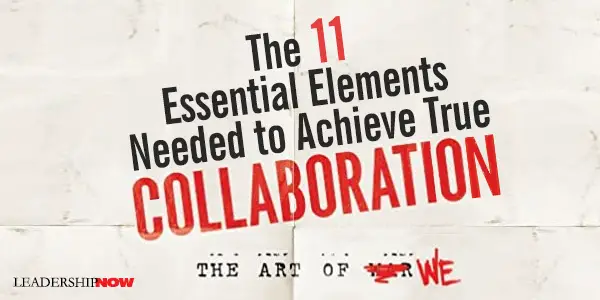
DAN SANKER states that ironically, in order to remain “competitive” companies will have to become more collaborative. Collaborate: The Art of We is a practical guide to going beyond democratic or cooperative work to creating truly collaborative work environments as a growth strategy. Collaboration is not a new concept, but globalization and new technologies have turned it into one of the best methods of competitive advantage available. Rather than engaging in an endless tug-of-war over the dwindling crumbs in a finite market, collaborative companies find ways to make the pie bigger, or create whole new pies, expanding everyone’s market and revenue. “It’s not about how many people you can defeat, but rather about how many people you can help win.” Although networking, coordination, and cooperation may look like collaboration, they are not. True collaboration is the “synergistic relationship formed when two or more entities working together produce something much greater than the sum of their individual abilities and contributions.” It results in something that did not exist before. The focus is on results and not process. Collaboration is distinct from cooperation in that “although both cooperating parties may achieve a common goal, they do not necessarily enhance each other’s capacity. In addition, cooperating parties do not fully share risks, responsibilities, and rewards. In the case of collaboration, all available resources, as well as risks, responsibilities, and rewards, are fully shared.” For a collaboration to be successful, Sanker says that eleven elements must come together: Ongoing Communication. People need to be able to talk to one another freely and regularly. Groups that do not have this kind of interaction are nothing more than loose collections of individuals working on their own tasks, toward their own ends. Willing Participation. Everyone believes that they are working toward the same, mutually beneficial goal and that each one of them will have gained something valuable when that goal has been achieved. Brainstorming. It’s the creative part of the collaboration process, in which members of the group move beyond the “same kind of thinking” to come up with new ideas that bring true value to the collaborative effort. Teamwork. It’s teamwork that keeps people with a diverse set of skills, knowledge, information, and perspectives working together effectively and efficiently to achieve their common goal. A Common Purpose. If the group moves forward too quickly without taking the time to clarify their goal and make sure that everyone is in agreement about what it is, they will undoubtedly run into huge disagreements that are likely to tear the effort apart. Trust. You need to feel confident that other people in the group are putting the group’s shared goal—not their own interests—first, and that they will keep confidential or sensitive information within the group, take you seriously, respect your point of view, and not take credit for your ideas. A Plan for Achieving the Goal. Everyone needs to be working from the same script, clearly understanding roles and responsibilities, and they need to have the same understanding of what success looks like. A Diverse Group. Diversity is the power behind collaboration. Without diversity groupthink sets in. It is diversity that gives a team the unique perspectives needed to create truly innovative solutions. Mutual Respect. For collaboration to be successful, team members must encourage, listen to, and seriously consider all of the ideas suggested by others in the group, no matter how unworkable they might seem. A Written Agreement. A written agreement helps the group avoid misunderstandings and lack of clarity that could derail the process after everyone has invested a great deal of time, effort, and resources. Effective Leadership. Whether one person has been formally designated as the leader of the group is self-led, leadership of some sort is essential to keep the group focused on its destination and facilitating the process of getting there. 
Posted by Michael McKinney at 11:33 PM
09.19.11

Hypocrisy Isn’t Going to Get You There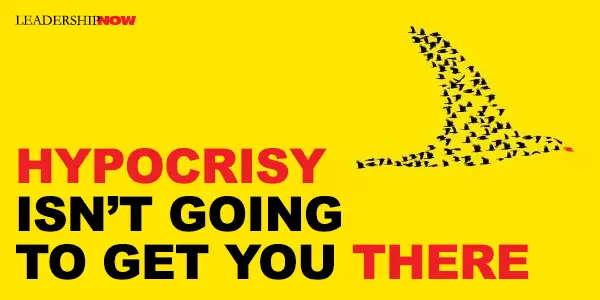
IF you’ve ever asked yourself, “What’s the matter with them? Why don’t they get it?” or said, “I feel like I am alone here,” maybe they are listening more to your actions than your words. Culture explains how things really work. Culture reflects practical values—values that will get you through the day regardless of what you say you believe. When it comes to preaching values, too many leaders are just talking heads. Preach change, demonstrate status quo. Changing culture in an organization is often difficult because leaders make it so. A culture that does not resemble your stated values reflects a lack of ownership and accountability to those values. A value that is meant for “them” but not lived-out in the behavior of and choices made by the leadership, will never become part of the organizational culture. Culture is formed by the choices we make, not the lecture we give. In Too Many Bosses, Too Few Leaders, Rajeev Peshawaria suggests three steps to cultural change: • Define the desired culture. Articulate a set of behavior guidelines for everyone to follow.
In this discussion he makes three statements that are worth reflecting on: Leaders should use every opportunity to exhibit guidelines or values in their own behavior. Are you modeling the behavior you want to see in others? Senior leaders of the company routinely showed up at these training sessions to show employees how important the values and brand were. Are you excusing yourself from what you expect others to be doing? In sharp contrast, another client told me to design the session in such a way that it did not rely too heavily on the executive team’s presence. He argued that the senior team was already under a lot of pressure, and that this would be a huge time commitment for them. I could not believe my ears. After all, as leaders, what do you spend time on if not aligning your organization’s culture with your vision and strategy? Do you live by a different set of rules? Sometimes this is difficult to see in yourself, so asking a trusted friend if there is a disconnect between your words and your behavior is helpful. As a leader, it is too easy to think of yourself as the exception. “I’m busy.” “They don’t have to deal with what I am dealing with.” “This is for them, I don’t need it. When a leader’s behavior conforms to their talk, there is a connective quality formed that is worthy of trust and attention. If we live our values we can create radical change.

Posted by Michael McKinney at 07:07 AM
09.09.11

Managing the UnmanageableIf we truly want to deal with a difficult or unmanageable person, we have to get at the thinking behind the behavior. Why do they do that? Why are they that way?Instead of going deeper, it’s easier to just label them and avoid the issue. He’s rude. She’s unreliable. He’s an egomaniac. She’s self-absorbed. Anne Loehr and Jezra Kaye, authors of Managing the Unmanageable, say that these “unmanageable” people are costing companies a fortune. Loehr estimates that her clients lose, on average, 30% of their productivity because of issues related to unmanageable employees. The fact is, “there’s a world of difference between someone who’s acting unmanageable, and someone who can’t [won’t] act any other way. There’s a world of difference between someone who’s become unmanageable in response to a particular set of circumstances (that can, at least theoretically, be changed) and someone who’s just like that.” Perceiving the difference is the task of leaders, managers, and coaches. Most of the time we deal with people at the symptom level. Managing the Unmanageable is written to help you do just that. They begin with an appropriate caution: If you find yourself being convinced that someone could never have the slightest redeeming good quality, find a way to deal with your own feelings before you try to manage theirs. Good advice. There are some early warning signs that it is time to look deeper than the behaviors you see: Diminished Motivation: “Frustration with a job can grow out of unmet or unrealistic expectations, company-wide uncertainty or relationship problems on a team or with a manager.” You’ll hear comments like: “I’m just not into it anymore.”Unclear Expectations: Misunderstandings are common. We don’t always communicate as clearly as we think. Too much often goes unsaid. Sadly, too, “managers and executives sometimes purposely lead employees astray, confuse them, or keep them in the dark to avoid unpleasant issues or consolidate power in their own hands.” It sounds like this: “I have no idea what she wants.”Lack of Confidence or Self-Esteem: “It’s natural to wonder if you have what it takes when the stakes go up or your job becomes more complex. But if that lack of self-confidence persists, an employee can become resistant, defensive, and ultimately unmanageable. They will say things such as: “I don’t know why they thought I could do this.”Personal Issues: “When your employee is distracted, self-absorbed, or unable to focus, her problem may stem from conditions outside of work. It might be expressed as: “I haven’t slept through the night in weeks.”“A radical shift in behavior,” say Loehr and Kaye, “may be your first indication that a good employee is morphing into an unmanageable employee.” In short, other people have many of the same problems we have, it’s just that they haven’t learned how to deal with it or are not in a position to do anything about it in the same way that we would as leaders. The book specifically deals with the excuse-maker, the grumbler, the egomaniac, the loose cannon, the joker, the do-gooder, the wallflower, the gossip, the slacker, the rude-nik, and the AWOL. Each “salvage” operation follows the 5-C Model: Commit or Quit, Communicate, Clarify Goals and Roles, Coach, and Create Accountability. The focus of each chapter is to get behind the behavior of each type and understand it. You will find helpful composite cases, practical tips and dialogues for dealing with each type.
Posted by Michael McKinney at 08:41 AM
08.08.11

Common Purpose Leadership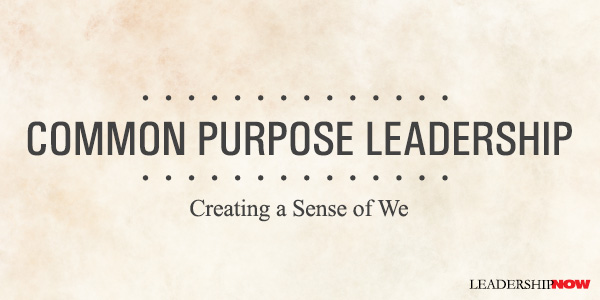
IN Common Purpose, consultant Joel Kurtzman makes the case that excellent leaders build a sense of inclusiveness—a sense of we—within the organization by creating a common purpose. A place where people know what to do and why and understand what the organization stands for. Based on interviews and first-hand experience, Common Purpose lays out how to achieve and then sustain a culture based on a common purpose. For example:
The easiest way to create a sense of we, says Kurtzman, is unfortunately to create the specter of them. Because it is easy, it is probably the reason you see this dynamic played out in so many organizations of all kinds. While it is a shortcut to common purpose, “it can also be a stepping stone to chaos, doom, and organized opposition.” I would add that within the organization or group, it also leads to arrogance, stagnation and closed minds. In most cases, it leads to decline. Organizations are created to achieve goals that “are beyond the capability of an individual to accomplish alone.” They are a method of “aligning groups of people so they achieve common goals.” This is best accomplished when you encourage people to be leaders at any level within the organization. Simon Cooper, president and CEO of Ritz-Carlton, says the best reason to rid an organization of mindless hierarchy is to provide scriptless service: employees deciding on their own how to make guests happy. “They make decisions on their own, on the spot, using their own judgment, and with the sense of confidence that comes from owning their jobs. That’s real leadership.” Taking risks on behalf of the organization. This requires trust at all levels and a different view of real leadership, says Kurtzman. It is difficult to overstress how important it is for teams of people working together to meet informally from time to time…The point is that you cannot lead a team if you do not know the people you are leading, and the best way to do that is informally. “The leader is not separate from the group he or she leads. Rather, the leader is the organization’s glue—the force that binds it together, sets its direction, and makes certain that the group functions as one.” Kurtzman notes, “Leadership is not coaching. Coaching focuses on helping people arrive at their own goals. Whereas leadership, especially common purpose leadership, is about helping people arrive at a collective set of goals. It is about coordinating people’s efforts, aims, ambitions, and capabilities.” Leaders can’t think of themselves as better than their workers or more favored because they have a higher rank. Becoming CEO is not a coronation; it’s a promotion. And CEOs can’t do everything. The purpose of an organization is to combine the efforts of many people to produce results no one on his or her own could achieve alone. Leaders must understand that. They must live the goals they espouse. They must understand that everyone inside the organization is looking at them — scrutinizing them, really — and also that every action of theirs is being watched and talked about. At FM Global, Shivan Subramaniam, the chairman and CEO, decided against buying a corporate jet despite the prodding of his board. Instead, he decided to abide by the same corporate travel rules that every other executive in the company abides by. He even flies on the redeye if he must. By doing this, he sends a powerful signal throughout the company that while he may be the CEO, he’s also an employee, just like everyone else. People value that. People will do almost anything for a leader like that. Of course, one size does not fit all. “People are individuals, and those who thrive in one firm might not thrive in another. Chemistry, fit, values, and many other qualities are in the eye of the beholder.” Kurtzman believes that “organizations will come to resemble constellations of capabilities linked together technologically from centers located around the world….Big companies will comprise smaller pieces, each with unique characteristics, ownership structures, and relationships. Each of these elements, when combined, will create enormous value?” The question is what will keep it all together. Incentives alone won’t do it. “The power of a common purpose will become the factor that differentiates winning organizations from those left behind.” This means that leaders will have to be “kinder, more caring, and more empathic than leaders of the past.” We have seen this increased focus on respect as many of you write, talk, and practice this on a daily basis. Common purpose leadership, at its most basic level, is about recognizing people as individuals. Common purpose leadership begins with respect for individuals and their differences, and goes on to celebrate their strengths. 
Posted by Michael McKinney at 10:59 AM
07.26.11

Have a Nice Conflict!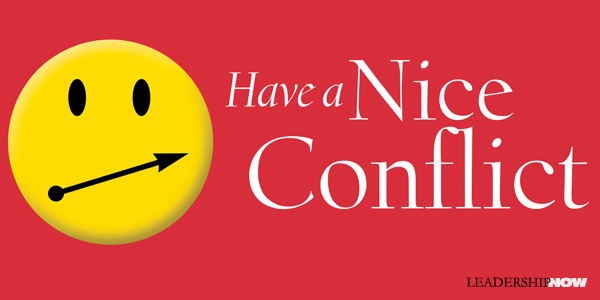
READING Have a Nice Conflict was like listening to my Dad again. He first met “Doc” Porter in the early seventies and they clicked almost immediately. Elias Porter’s Relationship Awareness Theory, on which the book is based, resonated with my Dad. Behaviors are the tools we choose and use to support our self-worth.Have a Nice Conflict is the story of sales manager John Doyle who has been passed over for what he believes is a well-deserved promotion. He has lost some of his top performers because he rubbed them the wrong way. When he turns up at an old friend and client’s office to explain yet another change in sales reps, he puts him on to Dr. Mac to help him improve his people skills at both work and home. Dr. Mac explains to John that there are many ways of interacting with others. We have default ways of behaving and when in conflict we often shift into other behaviors to maintain our self-worth. While we are trying to do the “right thing” to maintain our self-worth, conflict can happen when our “right thing” appears to be the “wrong thing” to another person. Conflict can be prevented by seeing contentious behavior as merely a different style instead of a direct challenge or threat aimed at annoying you or derailing you. He introduces him to the Strengths Deployment Inventory (SDI) which is a tool to help you understand the motivations behind your own behaviors and to better discern the motivations of others. By giving you a framework it helps you to understand what you and others are feeling and then helps you be better able to respond. Having a nice conflict is about taking personal responsibility for the interaction. To create movement toward resolution, we need to show the other person the path back to self-worth—where they feel good about themselves. That path may be different than yours. The concept should be taught in schools, however, the thought process is essential for leaders. The book alone offers valuable insights into the process and methodology, but coupled with the SDI you’ll have greater success. The authors offer a discount on the SDI to readers of the book. 
Posted by Michael McKinney at 05:08 PM
06.27.11

The Big Vision is Important but People Live in the DetailsMost leaders don’t want to be called a tyrant, a control freak, or even a micromanager. To avoid that, it’s easy to jump into the other ditch and be laissez-faire. Leaders have a duty to navigate between these two extremes as the situation dictates.Typically, we like to present the vision—the values—and leave the details to be sorted out. We like to give the big overarching principle without explaining exactly how it plays out in everyday life. The problem is that everything happens in the details. That’s where people live. That’s where decisions are made, community is built, and your vision and values are realized—or not. We like to articulate the “promised land” and expect that everyone will catch on. That might work for the most highly visible leaders—those interacting with employees day-in and day-out—because they see you translating those values and goals on a day-to-day basis. But seriously, how many of us are that visible? We’re far too busy!?! We don’t want to be caught telling people what to do, but we want everyone on the same page. Life doesn’t work like that. People see the same thing and hear the same thing differently. They interpret it differently and thus it plays out in their behavior differently. And that is where the friction starts. That’s where the community breaks down. That’s where the judgment begins. Organizations, groups and families need more guidance than that. I’m not suggesting that we become control freaks, create even more rules, or become condescending or judgmental, but we need to clarify the vision and values in the details where people live. What do our values look like in everyday life? We need to use examples as they come up to relate everyday behavior to our values. Show where they match-up and where they don’t in a way that leaves room for them to develop good judgment and practical wisdom. From the beginning—and along the way as needed—we need to spell out, “This is the kind of company we want to be, this is the kind of people we want to be, so that means we don’t do this but we do do that.” Specifically. And we then communicate this over and over again in our rhetoric and actions. People need to know and understand your values if their behavior is to be guided by them. If there is a disconnect between your values and everyone’s clear understanding of them, confusion and misbehavior will define your leadership.
Posted by Michael McKinney at 08:17 AM
06.22.11

Leading Views: Keep Dissenters Close to Provide Perspective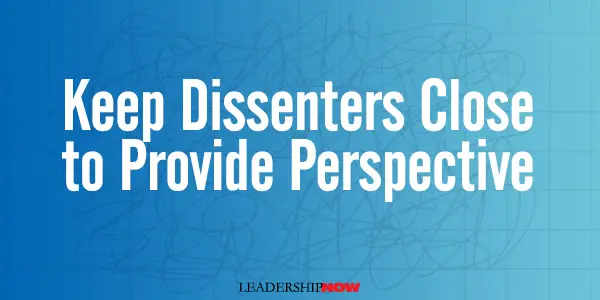

Posted by Michael McKinney at 10:58 PM
06.03.11

4 Lessons from the Toyota Crisis
“Crisis response must start by building a strong culture long before the crisis hits,” say Jeffrey Liker and Tim Ogden, authors of Toyota Under Fire. Turning crisis into opportunity is all about culture. It’s not about PR strategies, or charismatic leadership, or vision, or any specific action by any individual. It’s not about policies or procedures or risk mitigation processes. It’s about the actions that have been programmed into the individuals and teams that make up a company before the crisis starts. The accident in August 2009 that took the lives of four people in a runaway Lexus brought national attention to Toyota. Fueled by innuendo and speculation by Congress and some media, it escalated into something it was not. Toyota Under Fire deals with not only the massive recall of 2009-2010, but also Toyota’s response to the oil crisis and recession. Toyota’s response has not been typical, but it does follow the Toyota Way. It is a reflection of their culture. That way includes what is probably Toyota’s “greatest contribution to the world as a model of real continuous improvement” at and by all levels in the organization. Liker and Ogden describe the Toyota Way as: Face challenges with a clear head and positive energy. Hold fast to your core values and your vision for the company. Always start with the customer. Understand the problems that you face by analyzing the facts, including your own failings, and understanding the root causes. Thoroughly consider alternative solutions, then pick a path, develop a detailed plan, and execute with discipline and energy. “You do not turn a culture off and on again like a light switch.” Culture—like character—is built over decades of living your values in the real world. And then in a crisis, when you really need it, it is there to carry you through. The authors isolated four lessons for dealing with a crisis: Lesson 1: Your Crisis Response Started Yesterday. What a company does isn’t likely to change much when a crisis strikes or for any length of time. “They are driven by culture, and culture simply can’t be changed quickly, even in a crisis…. Therefore, the chief questions to ask yourself about how your company will respond in a crisis are not contingency plans and policies, but about your culture and your people. Have you created a culture that rewards transparency and accepts responsibility for mistakes? Have you created a culture that encourages people to take on challenges and strive for improvement? Have you created a culture that values people and invests in their capabilities? Have you created a culture that prioritizes the long term?”Lesson 2: A Culture of Responsibility Will Always Beat a Culture of Finger-Pointing. Common sense? Yes, but the question is how far do you go in accepting responsibility? What if the factors were beyond your control? The answer illuminates an important nuance in understanding Toyota’s culture of responsibility and problem-solving. “There is no value to the Five Whys [the belief that you have to ask why at least five times] if you stop when you find a problem that is outside of your control. There will always be factors outside of your control. When you reach a cause that is outside of your control, the next why is to ask why you didn’t take into account forces outside of your control—either by finding an alternative approach or by building in flexibility to adjust to those forces.” Lesson 3: Even the Best Culture Develops Weaknesses. The greatest threat to a culture of continuous improvement is success. “To survive the weaknesses that inevitably develop, a corporate culture has to have clear and objective standards, codified in such a way that self-correction is possible. Having a culture that recognizes a loss of direction is absolutely critical to long-term survival.” Lesson 4: Globalizing Culture Means a Constant Balancing Act. The clarity of Toyota’s culture and values is essential to growing the culture in every employee. And there is a balance to strike—the balance between centralized and decentralized, local and global—that is not easy. “There is an inherent demand here that especially the people who are at the margins, at the periphery of the organization, be deeply steeped in the culture, and that they are to be trusted to make decisions because they are at the gemba.” One of the root causes of the crisis they identified was centralized decision making. They will now pursue a regionalization strategy which will require trusting the leaders they have trained to maintain the culture. Toyota Under Fire is an in-depth look at the value of having a strong culture that can serve you when things go south. The discussions explaining the reasoning behind why Toyota does what it does were very helpful. They demonstrate that the most important decisions are the ones made before the crisis. And then when the crisis hits, return to basics. Go deeper and wider. 
Posted by Michael McKinney at 05:21 PM
05.24.11

Got Drama?
YOU can’t stop The Drama. There will always be drama. But that’s not the problem says Marlene Chism, author of Stop Workplace Drama. “The amount of time you stay in the drama—and the effort you put toward it—is the problem. Complaints, excuses, and regrets only serve to keep the drama alive.” Your drama—what you add to The Drama—is the problem.Chism defines drama as “any obstacle to your peace and prosperity.” Drama is the result of not recognizing or taking care of the little signs of bigger problems when they first presented themselves. At the core of drama, you will find one of three common elements (if not all three): a lack of clarity, a relationship issue, and/or resistance. So, says Chism, when you experience drama you need to ask yourself three questions: 1. Where am I unclear?
Chism presents eight principles for dealing with drama, but “lack of clarity” struck me as the most common and excuse-laden trap there is. Too often this is where we get stuck.
“Any type of discord, abuse, confusion, or game-playing always boils down to a lack of clarity.” A loss of focus. Sometimes we create drama because we want something on our terms. We imagine that we can’t do something because we can’t do it the way we think it should be done—our way. Chism relates a clarifying example of this with the recently divorced Joe who is having visitation issues with his ex-wife Patty. She’s not letting him do what he wants in the way that he wants. Many people get stuck in the drama of what should or shouldn’t be. Yes, you can fight that battle, if winning a battle is what you want. But again, in order to clear the fog and help Joe get clarity, I asked, “If there are two islands you can go to, and one means winning a battle with your wife and the other island is getting to see your kids and be a father to them—then which island would you choose?” This kind of dynamic plays out every day in our business and personal lives. When we are not clear about what we want, what our values are, what we are committed to, it is easy to lose our focus, to drift off course Solution: Clear the fog. Chism has written a good-natured and practical book that will change your thinking and in the process help you to control the drama in both your personal and professional life. As leaders, we have the responsibility to be very clear with ourselves and our team so that we don’t get pulled into negativity, gossip, power plays, resistance and … drama. Chism suggests asking the following questions: What are my top 10 principle-based values?

Posted by Michael McKinney at 10:00 PM
05.17.11

Do You Have a Virus in Your Group?It’s not unusual to find in a group, a person that just doesn’t seem to fit in; someone we would rather do without. Often we find them irritating simply because they are coming from a different perspective—a different agenda—than the rest of the group. While this can be annoying, these people provide a very important service to the group. Consider the experience Rhode Island School of Design president John Maeda relates in Redesigning Leadership:Working in a group where there are considerable differences and disagreements can be a pain. When I was in my twenties I worked at a small foundation in Tokyo. There was one gentleman whom everyone disliked. I asked the director, a wise and esteemed scientist who cofounded one of the largest corporations in Japan, why he didn’t just fire the guy. He gave me a quizzical look, as if that would be idiotic, and then replied, “Well, we need him, because an organization is like the human body. It needs viruses like him so the body can learn how to survive and remain strong.”Abraham Lincoln famously said, "I don't like that man. I must get to know him better." In like manner, Maeda says that after he began speaking with “the virus” more often he began to see his unique value. He had a different background from the rest of the team and therefore brought a different perspective. His point of view helped him to avoid making certain kinds of errors. When we understand the unique value each person brings to the group, we can learn to appreciate the friction that sometime arises—maybe even see it as the learning opportunity it is. The German poet Heinrich Heine once remarked, “Great genius takes shape by contact with another great genius, but less by assimilation than by friction.” Maeda adds, “Learning is said to be most potent when ‘cognitive dissonance’ occurs. Said more simply, we learn best when we are wrong.” Cognitive differences can lead to progress, understanding and wisdom.
Posted by Michael McKinney at 05:57 PM
05.05.11

Bill Roedy: From West Point to MTV
BILL ROEDY, former Chairman and CEO of MTV Networks International, began working for HBO in 1979 when it was broadcasting only nine hours a day. There he learned that distribution was everything. It was to be his mantra at MTV—aggressive, creative, relentless distribution. Roedy shares his experiences and lessons in What Makes Business Rock. From virtually nothing, he built MTV International into the largest media network in the world. For anyone involved doing business internationally, it is essential reading. As manager of HBO’s national accounts, he learned that “In life as well as in business, the ability to sell is the foundation upon which success is built.” Some people don’t understand that he says, but even in Vietnam, although he had the formal authority to force troops to obey my orders, I found that if people didn’t believe in the mission, I never got a total effort from them.” Leaders are always selling. Although reluctant to leave HBO and move to London, in 1989 he became managing director of MTV Europe. What he inherited wasn’t working. He had to quickly create a better product, get more distribution and generate revenue. Getting the right people in place was crucial to creating an entrepreneurial organization. “Never take ‘No’ for an answer.” “Take chances.” “Break all the rules.” Their objective was to be the most visually engaging channel in the history of European television. To make sure viewers always knew they were watching MTV, they put their logo in the corner of the screen and left it there. No one had done that before. (Now everyone does.) Here is a lesson every leader could bear to keep in mind: as a leader, your opinion matters—maybe more than you know. But it can actually be having a negative impact. The MTV playlist is extremely important to its viewers and giving them what they want to hear is essential to MTV’s survival. Roedy says that in the beginning, he attended those meetings if only to be the voice of reason and a subtle reminder that they were running a business. “But after attending half a dozen of these meetings I realized I was making a huge mistake. I was much older than our demographic and my musical tastes were very different. I was skewing the choices older.” So he stopped attending those meetings. “As much as I enjoyed being part of that process, I had to remind myself that I was a manager, and I had to delegate decision-making authority to those people I trusted.” How many leaders, for all kinds of well-intentioned reasons feel they have to leave their fingerprint on everything, while they are in-fact stifling their people and skewing the results? Roedy’s success at MTV can be attributed to the fact that he was always reinventing. “The longer you stay with the same strategy, the more vulnerable you become to your competitors.” His most important contribution was the idea, “Think global, act local.” MTV was already local to Europe, but it had to be broken down to the national level, country by country. “Learn the local culture and reflect it in every decision we make,” was their business strategy. He created a structure similar to what he learned in the military: small operating units in the field fighting the competition. “My belief was that the local people would best reflect the needs, tastes, and desires of the local audience, and because their jobs would depend on the bottom line, they were much less likely to make risky or destructive financial decisions. In Vietnam, I had seen over and over the benefits of dealing directly with the loyal population on their own terms, rather than trying to impose our beliefs on them.” Because of the complexities of operating an international business, you need be there on the ground to really feel it. On MTV Arabia for example, they broadcast the call to prayer on the channel five times every day. For Ramadan, they produced an animated film explaining the meaning of that important religious holiday to young people in a creative way and refrained for a month from showing any music videos. Throughout the book there are stories of music celebrities—singing karaoke with Bono and Bob Geldof dressed as a nurse in Tokyo at 4 a.m.—and others like Sumner Redstone, Robert Maxwell, Jeff Bewkes, Nelson Mandela, Jiang Zemin, Fidel Castro, Tony Blair, and the Dalai Lama. They add color to the book and make it all the more interesting. But read it for the insights into global business. 
Posted by Michael McKinney at 01:28 PM
05.04.11

What Makes Business Rock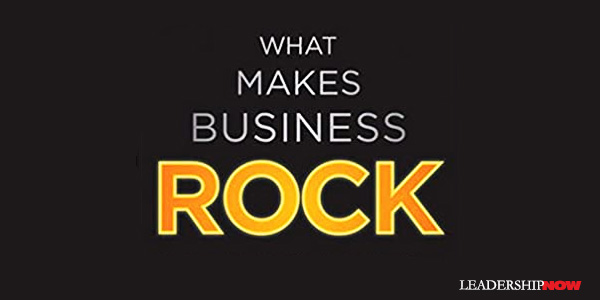
AFTER reading What Makes Business Rock by Bill Roedy, I have developed an appreciation for what it took to build MTV Networks International into what it is today. Former Chairman and CEO, Bill Roedy, has had a remarkable career. Due to financial constraints, he followed his Dad into West Point. Not his first choice. He became a member of the “Century Club” collecting more than a hundred hours of punishment duty. But he did learn the “difference between fighting the system and finessing it.” He also learned many of the skills that would enable him to succeed in business, including “discipline, time management, the value of teamwork, and the importance of physical endurance.” He learned how to prioritize. Survival depended on it. “Too often,” writes Roedy, “I have seen people focusing on the wrong things—things that are not going to directly or immediately affect their business….Leaders need to learn to cut through the chaff to determine priorities and to identify the real target.” After West Point he served in Vietnam in various command positions. “I learned the importance of making quick and firm decisions, communicating those decisions clearly to my troops, and then doing anything and everything necessary to implement them. I learned the importance of building morale, camaraderie, and a team spirit. I learned how to deal with the chain of command and how to get around it when necessary.” From Vietnam he went to Northern Italy where he spent four years in command of three NATO nuclear missile bases. A good place to learn how to deal with pressure and stress. “There are few situations more stressful than commanding a nuclear missile site and trying to determine in 30 seconds whether the aircraft approaching the base was a friend or foe. There was no margin for error. We had to be perfect every day.” Wanting to go into business, he resigned the military after 11 years and went to Harvard to get an MBA. As a child, Bill was so enthralled by the power of television that he would memorize the TV Guide and recite the schedule back to his mother. He knew he wanted to work in television so instead of the typical corporate route followed by his classmates, he took a job at a small start-up cable network called HBO. Roedy’s background doesn’t make him the likely candidate to build MTV International, but it certainly prepared him for it. More on that tomorrow. 
Posted by Michael McKinney at 11:46 PM
04.25.11

Manage Through Ego and Conflict Here Craig talks about an issue every team has to deal with—ego: We weren’t big shots. We weren’t stars. If we were going to do something great we needed each other and had to do it together. We couldn’t afford to wallow in our differences to get laid low by towing egos. We needed to manage through ego and conflict. More great efforts have been undone by ego left unchecked and conflict not resolved than can ever be imagined. This negative energy brings down sports teams, companies, political campaigns, armies, and even societies and nations. But the thing is this—ego and conflict can be healthy if managed and controlled. When they are not controlled, they become a monster that eats your group from within. Managed and controlled, ego and conflict are energy and a source of winning ideas and inspiration. Not managed and controlled, they cause people to fight each other, not the competition—and that is a formula for losing. Craig offers several strategies for managing ego and conflict like, finding a buffer or go-between, respect the role that each team member plays, respectfully agree to disagree, and be prepared to sacrifice for the good of the team. 
Posted by Michael McKinney at 11:23 PM
10.15.10

You Already Know How to Be Great
ONE OF the hardest things we will attempt to do is to act on what we already know to do. It’s that difficulty that lies behind much of our search for the next big thing; some way to get around or make easier that which we know we should be doing. It is never easy, but by applying some new thinking, we can get out of our own way. Alan Fine states in You Already Know How to Be Great, that performance improvement is most often an issue of reducing the interference that’s getting in the way of using the knowledge we already have. Fine says that we have to get right the three elements that facilitate the use of the knowledge we already have. They are: Faith: Our beliefs about ourselves and our beliefs about others. High performance is more likely when we believe that we can learn and do better. The absence of Faith could be described as insecurity. Fire: Our energy, passion, motivation, and commitment. High performance is more likely when we are excited about learning and doing. The absence of Fire could be described as indifference. Focus: What we pay attention to and how we pay attention to it. High performance is more likely when we pay attention in a way that will quiet our minds. The absence of Focus could be described as inconsistency. High performance happens when we “get rid of the interference that blocks these natural, inherent human gifts.” Focus is the most powerful tool for removing distractions and, thus, the “most effective way to release Faith and Fire.” If we “create a singular focus on one or more critical variables of the task, we’re far more likely to create the flow state that creates high performance.” More than instructing, Fine believes we would be better off looking to what is blocking Faith, Fire, and Focus in our organizations, performers, families, and teams. Unleashing these qualities facilitates the use of knowledge. As managers, leaders, coaches, or parents, we’re incredulous to think (or more likely, it never even occurs to us to think) that without our excessive instructing, regulating, controlling, directing, and intervening, people might actually be able to perform with greater confidence, more enthusiasm, and more effective focus. Fine introduces the GROW process as a way of creating focus. The process asks: “What is my Goal? What’s the Reality? What are my Options? What’s the best Way Forward? GROW increases Decision Velocity [the speed and accuracy with which we make decisions]. It helps reduce interference, clarify thinking, identify options, and chunk down the challenge into doable tasks. It unblocks Faith, Fire, and Focus and frees people to use the Knowledge they already have. As leaders, we tend to approach most situations by providing more information. We actually nourish the expectation that we are to be telling people what to do when we really need to be working to help them get what’s inside of them out. Fine calls this inside-out coaching. It’s less about providing more Knowledge and more about releasing the Faith, Fire, and Focus that's already there in the performer. It’s more Focus coaching than it is Knowledge coaching. “It’s easy for coaches to get blindsided by what they think people have to pay attention to—to get so focused on the task that they miss the window through which a person can actually pay attention.” “When leaders simply tell people what to do (which is often the case), the result is often a lack of engagement and accountability on the part of the employee and little or no performance improvement. One of the primary observable signs of an outside-in approach is people constantly asking managers, leaders, teachers, or parents what to do.” As a coach, the biggest challenge isn’t the performer; it’s your own interference. You Already Know How to Be Great is about coaching ourselves and others to remove the interference that is blocking performance. It is full of applications of inside-out coaching and the GROW process he advocates. As such, it is an indispensable book for coaches or leaders of all types.

Posted by Michael McKinney at 06:57 PM
06.23.10

Developing a Small-Wins Strategy for GrowthWhen moving through difficult times, it is helpful to develop a small-wins strategy. In difficult times, deficit-thinking is so easy to fall into and often becomes the norm. It is hard to defeat but by highlighting small-wins you help to create the kind of abundance-thinking needed for growth and forward momentum. A strategy of small-wins helps to develop the kind of outlook associated with abundance-thinking—self-efficacy, hope, optimism and resilience.A small-wins strategy also helps to eliminate the tendency to be consumed by past disappointments, obstacles and failures. The need to look for “what is working now” is key to moving forward. It opens your thinking to possibilities and paves the way for improving processes. Small-wins focus on the here and now. What can we do now and what can we safely ignore or eliminate. It is an antidote to the fixation error trap. It’s easy to caught up in “everything”—the full impact of what is happening and the habits and perspectives that have become so much of who we are—that we become overwhelmed and unable to act at all. Fixation errors keep us from noticing what is really happening, separating us from reality. Reassess after each win and keep moving to build momentum. Begin by breaking tasks and issues down in to manageable pieces; pieces that you can take responsibility for and act on now. If you are not in a position to implement this strategy on an organizational level, adopt it for your team or even individually. Lead from where you are. It’s contagious. Of Related Interest:
Posted by Michael McKinney at 11:35 AM
01.20.10

What Your Group Needs to Become ExtraordinaryWhy do most groups fall short of their potential and only a few groups become extraordinary? To find out Geoffrey Bellman and Kathleen Ryan say we need to dig deeper into the wants, needs and motives that cause people to work together. They define an extraordinary group as one that “achieves outstanding results while members experience a profound shift in how they see their world.” They exhibit:
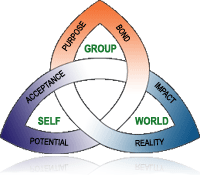
To accomplish this, you want to be a facilitative leader as opposed to a directive leader. With the group needs model in mind, the authors suggest that you “stand back from your group to consider the individual members, their collective purpose, and the world in which they operate” and ask “How might this group experience meet those needs?” Then consider the eight indicators of extraordinary groups (listed above) to see if they are present. Do members of the group seem energized, hopeful, connected and positively changed? A group leader needs to frame an inspiring purpose, lead with a light touch, keep the issues discussable, manage the world around the group acting as a buffer and facilitator, make sure the right people are on the team (those people with the knowledge, skills, or experience to tackle the group’s purpose), and integrate the Groups Model into their approach. Ask yourself questions like: “How will this meeting meet the needs of acceptance and potential, bond and purpose, reality and impact?” “Where and how can we use our differences as a group strength?” “Is there enough room in the agenda so that members have time for those more in-depth and sometimes complex conversations?” Extraordinary Groups offers practical advice on implementing the Groups Model into your own group situation. All of the suggestions offered are accompanied by examples, reflection questions and sample actions for both you and the group. By paying attention to group needs you can more consistently transform ordinary groups into something more energizing, connecting and affirming.
Posted by Michael McKinney at 12:02 AM
12.07.09

Got Wingmen? Never Fly Solo
AIR FORCE fighter pilot Rob “Waldo” Waldman learned how to overcome fear, anxiety, and self-doubt to fly combat missions that pushed him to his limits by disciplined training and the help of his wingmen. Wingmen are people with different backgrounds, skills, and experiences unified under one agreement—to never think or act alone. A wingman watches your back. In Never Fly Solo, Waldo threads real-world experiences to encourage the development of a check-six culture. Check-six refers to the six o’clock position where the jet is most vulnerable—the pilot’s blind spot. Waldo says, “There is a limit to how much you can learn on your own. A good wingman will give you mission-critical feedback, catch your errors, ask questions, and propose challenging scenarios to push you to grow in your skills and mental discipline.” Encouraging others to look out for our blind spots requires a great deal of mutual trust. “These trusted partners, male or female, are your wingmen.” Of course, this means first, not being afraid to acknowledge that you need help and then being able to ask for it. This is all the more difficult if you haven’t built trust in yourself and invested the time to build trusting relationships with others. You’ve got to “walk the flight line.” Get out and build relationships with those people you work with—treating each other as people first and coworkers second. “It’s the relationships we build and the people whom we trust that give us the courage to take risks and make ourselves better.” By being willing to say, “I don’t know,” or “I messed up,” we create a transparency that will attract others to us and “create the type of environment where people won’t be afraid to make mistakes. They will also be more likely to check your six as well.”Additionally, we have to keep our “radar sweeping for a wingman, coworker, or peer who may be experiencing a challenging time in her life. Don’t let her get isolated.” Be supportive and find her some help if necessary.” It is the worker that keeps to themselves—trying to fly solo—that check out, become unmotivated, complacent and careless. “Never feeling invested in the company’s mission, they do the minimum, and everyone suffers.” In today’s environment, communication, feedback, and mutual support are critical Waldo says because:
“An effective check-six environment frees up communication and removes barriers to growth so that all members of the team feel empowered to speak up and ask questions.” It also builds team confidence. We all need wingmen and the best way to find a wingman is to be one! 
Posted by Michael McKinney at 07:29 AM
11.09.09

Building Teams that Capitalize on the Innate Creativity of Everyone on the Team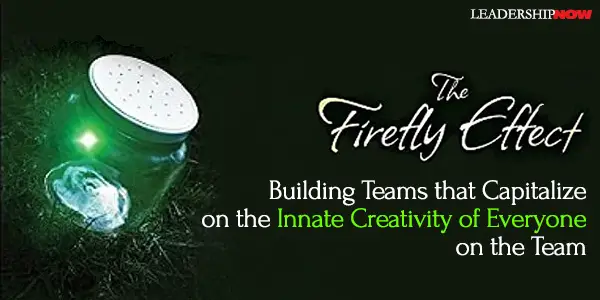
“A lone firefly—like the lone genius—does not ignite the imagination of others,” writes Kimberly Douglas in The Firefly Effect. “It takes the brilliant light of many, and the creative effort of the entire team, to truly spark innovation with impact.” The job of the leader is to “create a safe environment in which every member of the team can knowingly and proudly claim those differences, and apply them in an optimal way to achieve the goals of the team.” The leader must provide the processes that will allow every other member of the team to see each other in this new light. These differences can create heat. “Fireflies know how to shine without creating heat—without wasting energy on unnecessary conflict.” Differences should compel us to look at individual differences more creatively. The team’s focus is key. “One of the most important things that a leader can do is keep the team focused on the real competition; those who exist outside the walls of the organization…. Making this the focus keeps people from clashing within the group. When this focus is lost, infighting and bickering among the team members thrives.” This means learning to communicate more and better. It means learning to view conflict in a new way; not as a destructive, inevitable evil, but rather as a constructive source of creative abrasion. The Firefly Effect is about releasing that spark of creativity that exists inside all of us and channeling it in a productive way. Douglas provides down-to-earth, tested and practical methods for inspiring your team and leveraging their innate abilities. She shows how you and your team can capitalize on what is right about the people on the team. 
Douglas provides much to think about and implement: Two key components drive powerful teams: where they’re going and how they’re going to work together to get there. The answers to these questions are inextricably tied. It simply means asking, you want to capitalize on team members’ unique differences to what end? You want to promote creativity and innovation targeted toward which business objectives, problems, or opportunities? In the end, Douglas illuminates the idea that “a single person has a substantial amount of power to truly make a difference in an organization by first believing in something, and then taking action on it.” That’s leadership. 
Posted by Michael McKinney at 10:34 AM
07.27.09

5 Leadership Lessons: Getting Your Relationships Right Townsend wrote Leadership Beyond Reason to help you understand and utilize the soft skills – that which is beyond reason. He says “you ignore what is beyond reason at your own peril….Leading from your inner world ultimately produces better results in your leadership.” He divides our inner world into five areas: values, thoughts, emotions, relationships and transformation. As leadership is about connecting with those you lead and a primary focus of leadership, let’s pull five lessons from Townsend on relationships: Developing your relational abilities will help you read the landscape. Townsend adds, “The leader who misses relational aspects is surprised when people become distant, resentful, or just leave. The relational leader sees the signs coming a long way away and has time to do something about them.”
Posted by Michael McKinney at 09:51 AM
06.15.09

The Disease of Me"The force of selfishness is as inevitable and as calculable as the force of gravitation"Pat Riley argues that whether we know it or not, all of us are team players and it is through the team that we find significance. Yet the team can be undermined by the Disease of Me. In The Winner Within, he describes it as the overpowering belief in the importance of oneself. “The most difficult thing for individuals to do when they’re part of the team is to sacrifice. It is so easy to become selfish in a team environment.” The Disease of Me is ever present, but it can be anticipated and overcome. Riley lists the following symptoms of the disease:
What about the teams in your life? Are they due for a checkup?
Posted by Michael McKinney at 12:11 AM
06.08.09

Lead, Sell, or Get Out of the Way Lead, Sell, or Get Out of the Way by Ron Karr provides more evidence that leadership isn’t just about a few titled people at the top. It is a choice to think differently. Leadership is a choice to think differently about anything you do. Selling is no exception and is closely linked to the functions of a leader. Leadership is not always about people we “lead” in the conventional sense, but is frequently about people we must influence. Karr writes, “Whether you sell a product, a service, or an idea, you must be able to influence other people as leaders do.”
Lead, Sell, or Get Out of the Way by Ron Karr provides more evidence that leadership isn’t just about a few titled people at the top. It is a choice to think differently. Leadership is a choice to think differently about anything you do. Selling is no exception and is closely linked to the functions of a leader. Leadership is not always about people we “lead” in the conventional sense, but is frequently about people we must influence. Karr writes, “Whether you sell a product, a service, or an idea, you must be able to influence other people as leaders do.”
It begins with being able to and understanding the need to engage others in continuous strategic conversations as part of the normal way of doing things—a process Karr has termed Integrated Dialogue. Integrated dialogue is a conversation of shared purpose that draws people out “to create a powerful relationship, one that identifies whole new zones of mutual opportunity, addresses far-ranging issues, and positions you as an invaluable resource: a leader.” As with all leaders, salespeople too will succeed when they fully appreciate the many relationships inherent in their success. Sales leaders lead a whole cast of people in their own organizations from the customer service, tech people to accounting and senior management. In addition, they lead not only their customer or end-user but also many points of contact in their customer’s organization that are likely to have some input on the buying decision like operations, accounting, purchasing, and senior management. Gone are the days where everything filters through the salesperson. “Your success as a salesperson depends on your ability to build and sustain coalitions both inside and outside your organization. You must create and lead the coalition, no matter what you are selling.” This will resonate with any leader: Your job is to manage multiple constituencies and alliances and to use those alliances to identify new and better ways of generating the desired results. Your job is to do what most salespeople don’t do: lead the conversation with your prospects and customers about the results they need, the problems they have, and the obstacles they face. To make this happen you must possess and develop the belief that you have everything you need and can build on that, the belief that you can improve any area of your life, everything is possible, preparation maximizes your potential, and your customers—the people you need to influence—come first. After laying the groundwork, Karr defines and explains the seven traits that great sales leaders share:
Karr demonstrates how to move from task-oriented selling (which is what most salespeople do) to purpose-oriented selling. These principles are worth bearing in mind on a personal development level as well. Karr encourages, “The bottom line is that you have the ability to increase your sphere of influence and sales just by the way you act toward those you are trying to influence.” Change your conversations, change your outcomes. Leaders in any field will find much here to assimilate into their daily activities. Read it and grow. 
Posted by Michael McKinney at 11:15 AM
06.04.09

Are You Dealing With Insecurity?We all harbor some insecurity; even if it’s just trying to hide the fact that we do. But it is not something we can ignore. Too much insecurity can cripple our leadership and anyone we lead.In Building Your Leadership Resume, president of the Southern Baptist Convention and pastor Johnny Hunt outlines nine characteristics of an insecure leader: • An insecure leader has a hard time giving credit to others. “Why should praise seem like an unrecoverable cost? It is a gift that gives back to everyone.” • An insecure leader keeps information from his staff. “When you release information, you convey trust and confidence to others. When you conceal it, you convey just the opposite: no trust, no confidence.” • An insecure leader doesn’t want his staff exposed to other leaders—people who may possess qualities you don’t, people who may have skills your staff wishes you had. “When one person grows the whole team grows….Give your people the best—even better than you are.” • An insecure leader is often a micromanager. “He’s a control freak.” Nothing can happen that they are not fully aware of. They fear things will fall apart without them. This kind of oppressive control can wring the life out of your team. • Insecure leaders are too needy of praise. “For this reason, more than perhaps any other, they can’t really be leaders. When someone needs his followers to always be telling him how wonderful he is, he works in direct opposition to the heartbeat of leadership, which is: building into other’s lives.” • Insecure leaders don’t provide security for those they lead. “If the mood and environment in the office is one of fear, second-guessing, and self-doubt, you can be sure an insecure leader is in charge.” • Insecure leaders take more than they give. Instead of validating and encouraging others, they are focused on receiving it. • Insecure leaders limit their best leaders. “Insecure leaders cannot genuinely celebrate the victories won by others.” • Insecure leaders limit their organization. “Not only does insecurity throttle down the horsepower of individual team members; it results in putting restraints on the whole church or organization.”
Posted by Michael McKinney at 09:37 AM
06.03.09

Whatever Happened to the Rugged Individualist?“Corporate America is in the midst of a crisis” write Jonathan Littman and Marc Hershon in I Hate People! “The spirit of the individual has played a huge part in forging our nation’s history. Yet the scourge of teamwork pap has made solo efforts in companies seem unwanted, crazy, even dangerous.“Instead of thinking of yourself as a staffer in a big company, the manager of a division, or a top executive, you begin to define yourself in concrete individualistic terms. You are a brand unto yourself. Brainstormer extraordinaire. Marketing whiz. Charismatic project leader.” At the same time the soloist is not a loner, a recluse or a maverick. They fit smoothly within a group, playing with it expertly while often leading or accompanying fellow members. I Hate People! Kick Loose from the Overbearing and Underhanded Jerks at Work and Get What You Want Out of Your Job is a guide for navigating through the kinds of people in the workplace that make us all miserable and undermine rugged individualists. How do you know if you're a Soloist, or at least destined to become one? The easiest sniff test is how many times a day you mutter, shout, or even think to yourself, "I hate people!" But not all People Haters are necessarily Soloists. Littman and Hershon have created the Am I a Soloist Quiz to help you determine the depth of your Soloist leanings. The higher your score, the more Soloist blood in your veins. A. The portion of the day I prefer working by myself is . . .
Posted by Michael McKinney at 04:55 PM
05.13.09

5 Leadership Lessons: Amp Your Team, Rock Your Business What’s my role in this group? What do I bring to the group that no one else can? How am I contributing to (or detracting from) the success of the group? How much responsibility will I have in keeping the group afloat? Which of my teammates can I learn from, and what can I learn? Related Interest: Sex, Leadership And Rock N' Roll: Leadership Lessons from the Academy of Rock by Peter Cook Cook cites Sydney Pollack on authenticity: You go to leadership school, and try to pitch your voice the same way that the boss did there, and have your office decorated the same way his is, and that’s not real leadership. Real leadership probably has more to do with recognizing your own uniqueness than it does with identifying your similarities.
Posted by Michael McKinney at 10:38 PM
05.11.09

Sebastian Coe On Creating a Winning Culture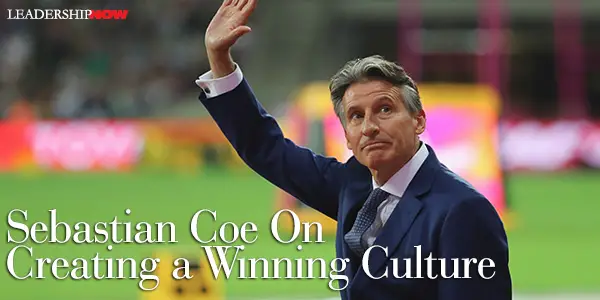
Sebastian Coe, Olympic gold medalist, politician, business leader and chairman of the London Organizing Committee for the 2012 Olympic Games, has written an inspiring book on the mental preparation required for winning in any endeavor. The Winning Mind is a fast-paced collection of life experience that offers evocative insights and expert coaching. Coe believes that leaders are shaped by their “environment, by their ambition, by their role models, by the support they are given as they progress through life and by sheer determination. Our aim must always be that there should be no limit to what an individual from any background can achieve with focus and application — provided they recognize and grab their opportunity with both hands.” Coe says that teams are most productive when they understand the part they play in achieving the final outcome. This requires very clear leadership. “Part of this is ensuring that the work culture is constructive, positive, inclusive and constant.” He offers this advice for creating a winning culture:
How well are you nurturing the conditions necessary to be able to put complete trust in your team? 
Posted by Michael McKinney at 03:27 PM
01.22.09

What to Look for in a Team of AdvisorsIn 1976, Stephen Hess wrote in Organizing the Presidency that in choosing Cabinet members, while the notion of a Cabinet “type” can be overdrawn, there are qualities that the President should look for in public executives.Persuasiveness. “This is necessary in large, hierarchical organizations where leaders have limited control over personnel and where the tug of inertia may be considerable.” Personal stability. “This calls for a sturdy internal gyroscope, stamina, and the ability to work under pressure. Broad-gauged intelligence. “…ability to conceptualize, to see the policy implications and consequences of their actions.” Flexibility. “They must do so without losing site of the President’s ultimate goals.” A sense of duty. “Unlike the President and members of Congress, they are not elected. This means, paradoxically, that they must have an even sharper sense of responsibility than an elected official.” A thick skin. They “should be lightning rods for public unhappiness and, if they are doing their jobs properly, they will deflect from the President as much criticism as possible.” Patience and impatience. They must be able to “deal with endless procedures,” hearings and meetings and yet at the same time they “must prod their subordinates to do better and must use their impatience with the status quo as a constructive tool of management.” These qualities might well be considered when looking for any team of advisors.
Posted by Michael McKinney at 01:28 AM
01.09.09

The Accountable Leader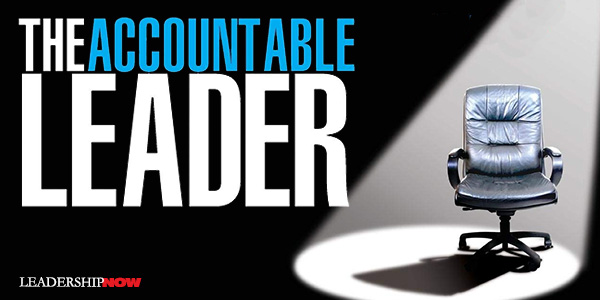
BRIAN DIVE tells us in The Accountable Leader that many organizations have difficulty developing leaders and fostering effective leadership because they have never considered the context they must lead in. The organization must be structured, Dive contends, so that all leadership roles from top to bottom have well-defined decision rights. In other words, accountability needs to be structured into the very fiber of the organizational architecture at all levels. Accountability, organizational design, and leadership are three inextricably linked factors. An organization is in flow, or in a state of equilibrium, when the required number of management layers (vertical architecture) matches the effective reach (or span of control) over the relevant resources that the organization needs in order to achieve its purpose. After briefly explaining the problem and the key concepts used in correcting it, he begins to present the practical application of his ideas for creating accountability within an organization. He addresses questions such as: How many layers of management are necessary? How do leadership requirements change at different levels? How can potential leaders be identified? How can they be developed? How should people be rewarded?Beyond the useful correctives to organization architecture and accountability, Dive also makes an important distinction between Managerial leadership (operational in nature) and Strategic leadership (changing the organization) for leadership development. Each requires different abilities and approaches in decision-making style and accountability. “Operational accountability is ensuring that existing assets and resources continue to perform better. The resources are given. Problem-solving remains related to actual events, rather than the abstract.” With Strategic accountability, “problem-solving moves into the abstract domain. Solutions have to be found that require mental modeling, as they do not yet physically exist.” On leadership development, Dive writes that “many organizations still confuse values, skills, and competencies” and “it is one of the main reasons why so many leadership development programs fail.” Here are several thoughts in this regard: Although values and skills, especially technical skills, play an important role in who should work in an organization, they are not reliable guides for the assessment of potential and who should be promoted. 
Posted by Michael McKinney at 09:01 AM
01.06.09

Strengths Based Leadership
THE FACT IS, many leaders do not really know their strengths. Not only does this lack of self-awareness bring about unintended consequences to one’s behavior, but also it can lead to disengaged employees and undue stress in the workplace and beyond. Donald Clifton remarked: What great leaders have in common is that each truly knows his or her strengths – and can call on the right strength at the right time. This explains why there is no definitive list of characteristics that describes all leaders.In Strengths Based Leadership, authors Tom Rath and Barry Conchie present a new leadership version of Gallup’s StrengthsFinder assessment. (An access code is included with the book so you can take the new assessment online.) The assessment is design to help you see how your top five strengths fit into their newly identified four domains of leadership strengths: Executing strengths, Influencing Strengths, Relationship Building strengths, and Strategic Thinking strengths. You will find that this knowledge is useful in creating well-rounded teams. As they note, "Although individuals need not be well-rounded, teams should be." Unique to this book is a study of 10,000 followers. When they asked them why they followed, four basic wants and needs emerged: trust, compassion, stability and hope. Once you have identified your strengths, they will give you specific suggestions for meeting those needs. The idea of strengths-based leadership is not to ignore your weaknesses as some have mistakenly misunderstood. But the emphasis for any leader should be a deep understanding of what they bring to the table and not trying to be something they are not. Rath and Conchie write: The most effective leaders know better than to try to be someone they are not. Whenever they spot an opportunity, they reinvest in their strengths…. Leaders stay true to who they are – and then make sure they have the right people around them. Those who surround themselves with similar personalities will always be at a disadvantage in the long run to those who are secure enough in themselves to enlist partners with complementary strengths. 
Posted by Michael McKinney at 11:46 PM
03.07.08

Inspiring the Will of the Team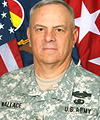 The ability to inspire and make a difference in a young person’s life is an awesome responsibility. Good coaching brings out the very best in both players and coaches. Coaches, like Army Drill Sergeants, teach a lot more than just skills and tactics, they teach determination, discipline, and character, both in and out of uniform. Coaches and military commanders face a similar prospect; how do you develop and maintain a winning organization year in and year out, when the capabilities and competence of your “bench” and the cohesion of your unit are constantly in flux? To develop formative training and innovative leaders you have to instill a “Warrior’s Spirit” in your players. And to cultivate a “Warrior’s Spirit”, you must first establish the core identity, direction and doctrine for your organization. But the development of a “Warrior Ethos” is not a goal line or battlefield revelation. It is a principled work ethic that builds mental stamina as well as physical prowess. Coaching character is as much, if not more, about the will of the coach as it is about the will and the work of the athlete. The “will of the Coach”, I like that. It emphasizes that the onus for results resides with the one who leads, who teaches, and who sets standards for the unit. As combat and football are both human endeavors, there exist some very real and decisive elements to these contests of wills that dramatically affect their conduct and outcome. “Shifts in momentum,” “seizing the initiative,” “fan base and fanaticism,” “national will,” “officiating,” “media bias,” “play making,” “pressure,” “injuries” and “leadership;” are all indisputable and unpredictable aspects of these activities. How do you develop that elusive “something” that soldiers and players draw on at “crunch time?” It is the character of the leader and the character of the organization that inspires loyalty across the formation, musters the reserves and evokes a “Warrior’s Ethos:”
In football as in combat—to win the day, you’ve got to win the moment, and when that moment arrives it’s the character of the man, the character of the team and the character of the coach that will decide the contest.
Posted by Michael McKinney at 01:16 PM
12.21.07

Lou Holtz on Bringing a Team Together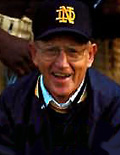 "I want you to learn everything we do at Notre Dame, how we do it, why we do it. It’s important that you learn our methods now so that when you become juniors or seniors you can provide the proper leadership for our younger players. That is essential if we are to enjoy continued success. We did not recruit you to change the University of Notre Dame but to conform to the morals and values of this great institution. You won’t change Notre Dame, but Notre Dame is going to change you.” Holtz reflected that his speech “was establishing a standard, setting a tone from day one. We have all see many great companies and schools fail to pass on their rich traditions to the next generation. They are shortchanging their people. We gave our players something to live up to and few of them ever disappointed us. If your organization or team is performing poorly, perhaps it’s because you don’t ask enough of your people. Never be afraid to demand excellence. But remember, the standards you establish for others must reflect the standards you set for yourself. No one will follow a hypocrite.”
Posted by Michael McKinney at 10:08 AM
11.26.07

5 Leadership Lessons: James M. Kilts on Building the Right Team In his instructive memoir Doing What Matters, James Kilts gives credit to his team for the turnaround he engineered at Gillette. Picking the right people is key to the success of any team. Here are some of his thoughts on building the right team.
Posted by Michael McKinney at 10:46 AM
07.16.07

Making Your Team Swing
WORLD RENOWN Jazz artist, Wynton Marsalis, has some profound things to say about business and relationships that are worth reviewing. Earlier this year, USA Today's Del Jones interviewed Wynton Marsalis about principles found in both jazz and business. Marsalis told USA Today, “When you listen to great jazz musicians, you hear the respect they have for each other's abilities. During a performance, most of the musicians' time is spent listening to others. You see the trust they have for each other because they are always making adjustments and improvising based on what someone else does.” Marsalis acknowledges that trust and listening to others goes hand-in-hand, but he brought up another important point that I think applies to any functioning organization or relationship. He points to the mindset of being aware of what others are doing and making adjustments for them in what you are doing, for the sake of the whole group. It’s not pointing fingers and affixing blame. It’s being so tuned-in to others that you can absorb their mistakes and they can absorb yours without missing a beat. He calls it “swing.” Here is more on that concept: Swing is a rhythm, an era in American history, and it is a world view. In this world view, there is a belief in the power of a collective ability to absorb mediocre and poor decisions. When a group of people working together trust that all are concerned for the common good, then they continue to be in sync no matter what happens. That is swing. It's the feeling that our way is more important than my way. This philosophy extends to how to treat audiences, consumers, staff or dysfunctional families. This may seem idealistic, but think about how church congregations recite, nearly together and completely unrehearsed. They proceed by feel. Swing is the single objective. It is the core that makes us all want to work together.
Posted by Michael McKinney at 07:05 AM
07.04.07

All Team Members Should Be LeadersBritish Rugby team England, has enlisted the help of the Royal Marines in Dorset to develop the leadership necessary to create a winning team. Brian Ashton, the head coach is making use of outside consultants too, to bring this team together. It points to the fact that every member of a team needs to operate as a leader, whether they are the point leader or not. An effective team leader will be make sure that all aspects of a task are being covered and that they are coordinating without being dictatorial. This requires a lot of give and take. Additionally it is important that all members of a team know what everyone else is doing so that they can adjust and align themselves to the problems that any other team member may be facing. The article continues. “’You need to pull players together, put them in a hostile and uncomfortable environment where they must work together to be successful, and they have done that.’ Some of the exercises designed by the Marines involved sensory deprivation, testing the ability to make decisions in extremes of tiredness….’This is the first time this group of players has been fit and available and the process of bonding as a group has been accelerated,’” Ashton said.
Posted by Michael McKinney at 09:13 AM
06.26.07

Newswire: The Science of Team Success
Posted by Michael McKinney at 08:09 AM
|
BUILD YOUR KNOWLEDGE
 

How to Do Your Start-Up Right STRAIGHT TALK FOR START-UPS 
Grow Your Leadership Skills NEW AND UPCOMING LEADERSHIP BOOKS 
Leadership Minute BITE-SIZE CONCEPTS YOU CAN CHEW ON 
Classic Leadership Books BOOKS TO READ BEFORE YOU LEAD |
|